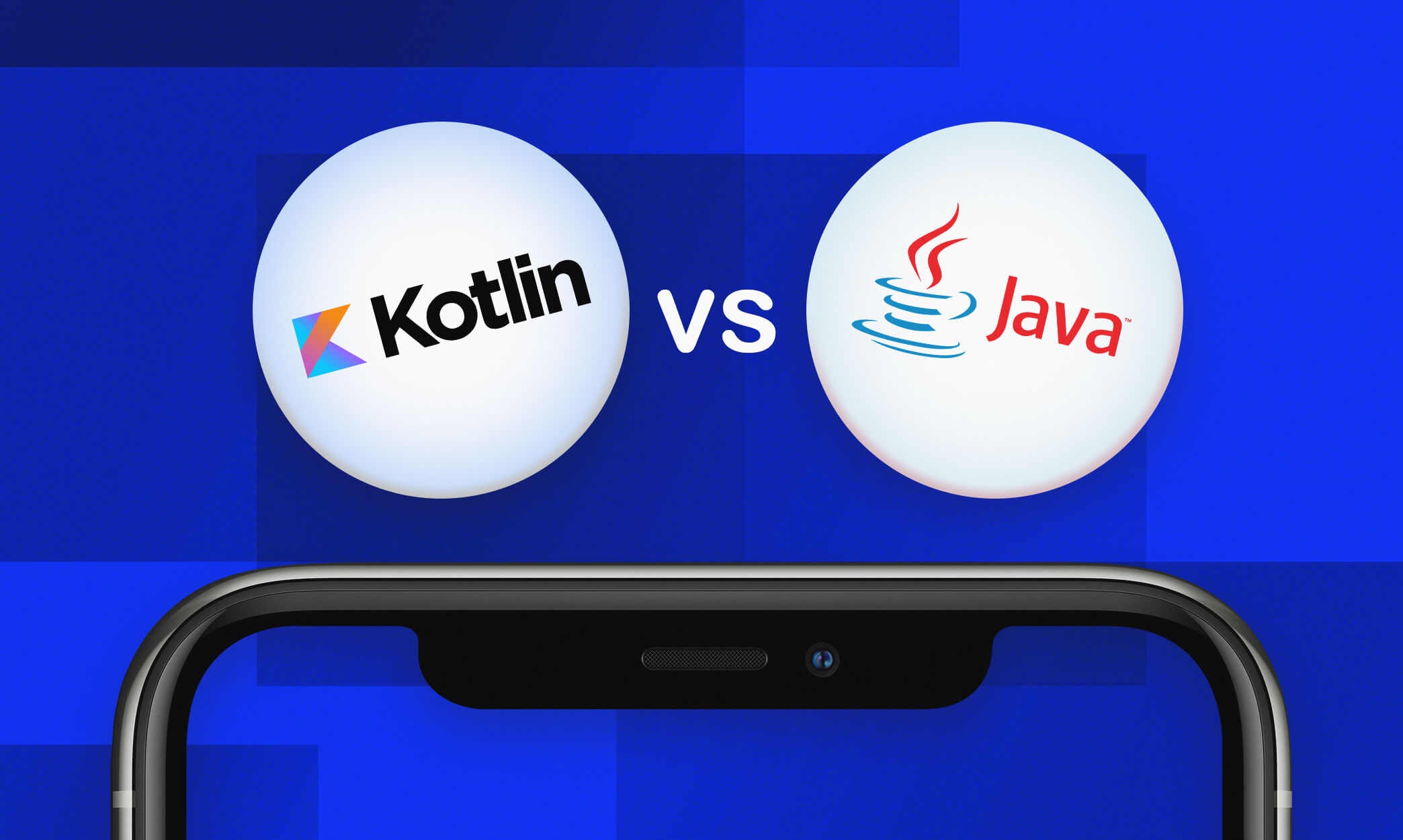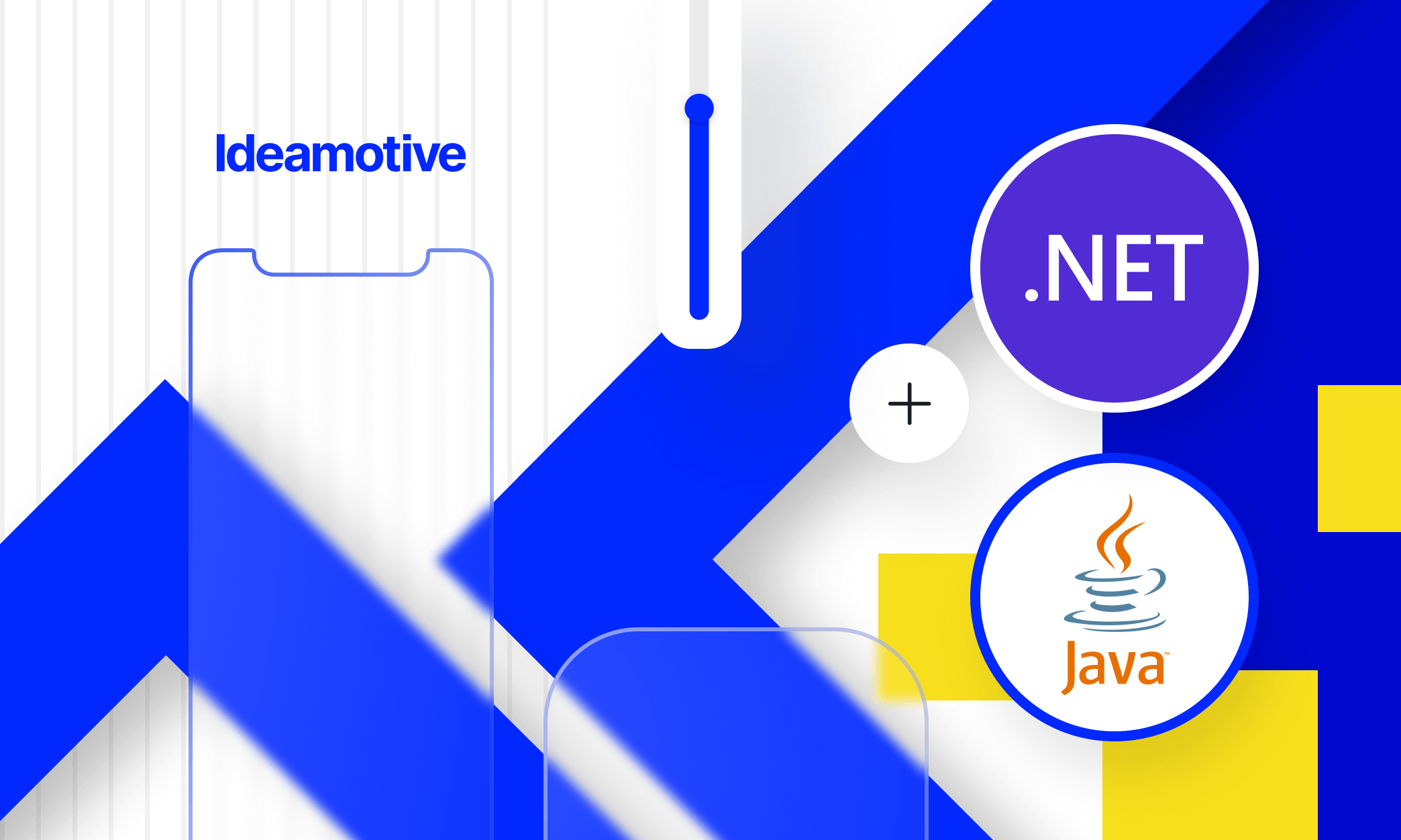The Business Side of Java Development
Guide for startups and digital entrepreneurs
Explore the language, its key applications, cost of development, main frameworks, and find out if Java suits your next software project. We’ve collected all the information that software product decision-makers need to know about Java before developing a Java-based product. Ready?
Why was this guide created?
Are you new to Java or need a refresher? Do you want to understand how Java fits into web, mobile, or desktop development? Then you’re in the right place - we’ve created this guide exactly for readers like yourself.
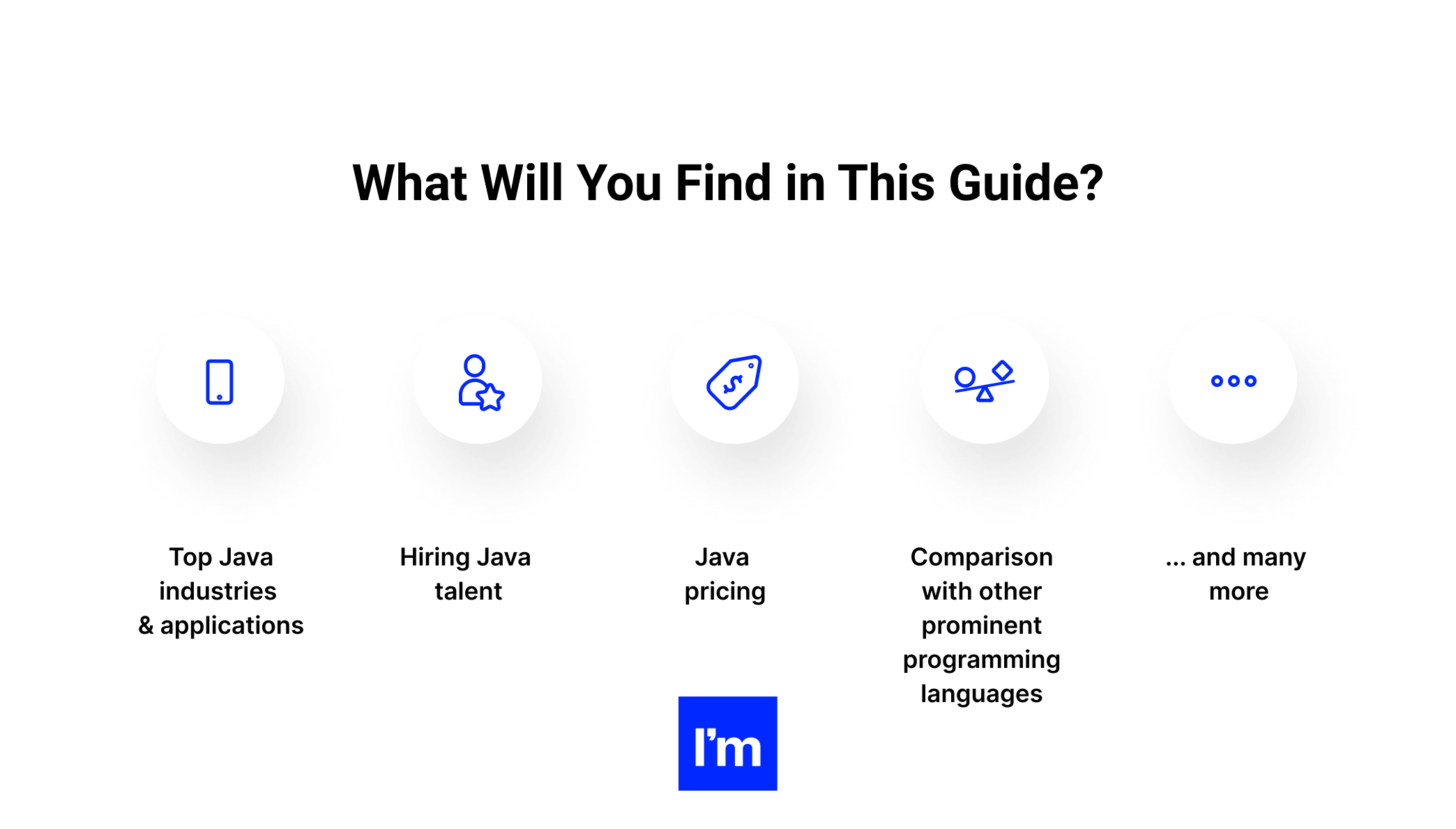
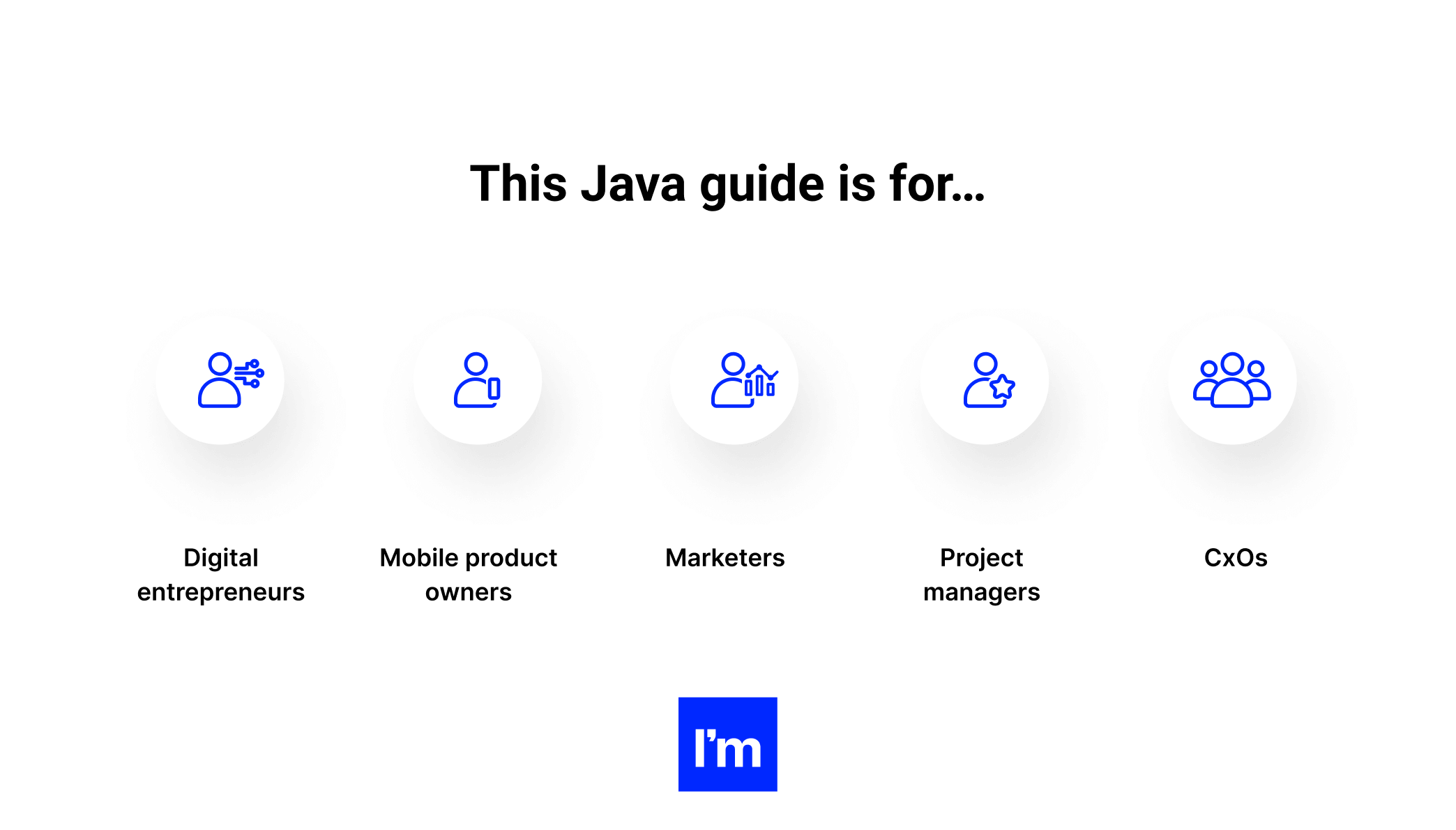
This Java guide is NOT for…
Software developers, architects, quality assurance specialists, or other technically-oriented professionals, as the content of this guide has a strong business focus.
No time to read it now?
No problem. Download your exclusive pdf copy to keep in your back pocket. Type in your email address below, and we’ll send it to you right away.
Or, if you're ready to plunge in, continue reading.
Let’s get started!
GET THE EBOOK VERSION OF THIS GUIDE
The guide breaks into snackable sections so you can easily navigate the content and move directly to the topic you need.
But if you still don’t have the time to go through them now, we’ve got your back! Here’s the pdf version for you.
By clicking “Get the e-book” you consent to processing your data by Ideamotive Sp. z o. o. for marketing purposes, including email marketing.
Table of Contents
01 What is Java?
In the unlikely event that you have never heard of Java, here’s the official definition, as provided by Oracle, who now owns it:
Java is the #1 programming language and development platform. It reduces costs, shortens development timeframes, drives innovation, and improves application services.
To add more context, Java is a high-level, class-based, and object-oriented programming language that came about in 1991 to support interactive television development and has evolved a great deal to reach today's 16th version.
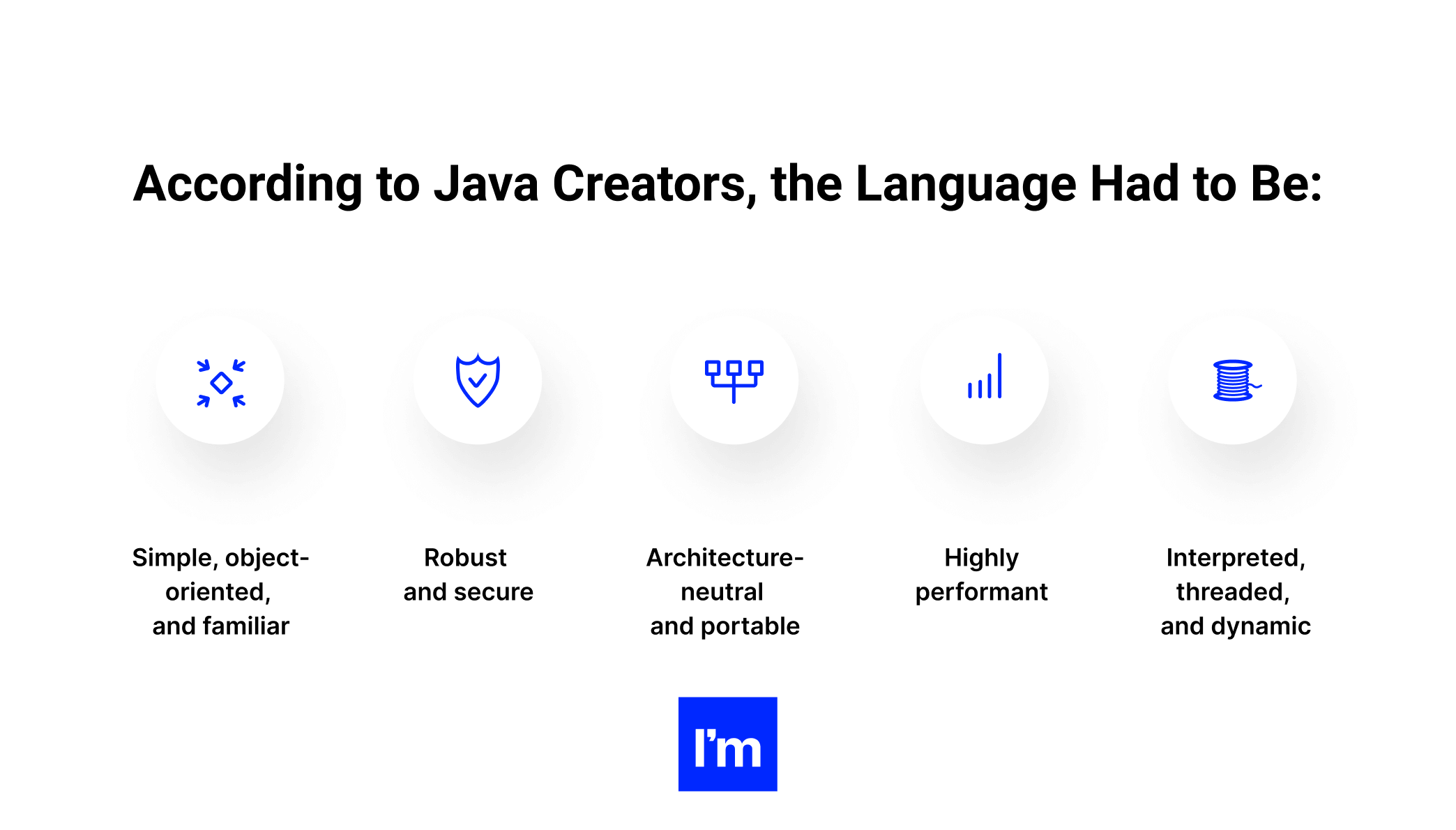
One thing to be remembered is that Java is both a programming language and a platform, so an environment for running applications written in this language. All Java platforms consist of Java virtual machine (JVM) and an application programming interface, or API, but each serves a slightly different purpose.
→ See also: What is Java Enterprise Edition (Java EE)?
When did Java first appear?
Sun Microsystems (later acquired by Oracle) released the first public implementation of Java in 1995. Since then, Java has been consistently ranking among the most used programming languages in the world.
While the popularity of many competing technologies ebbs & flows over the years, Java’s standing has always been incredibly strong.
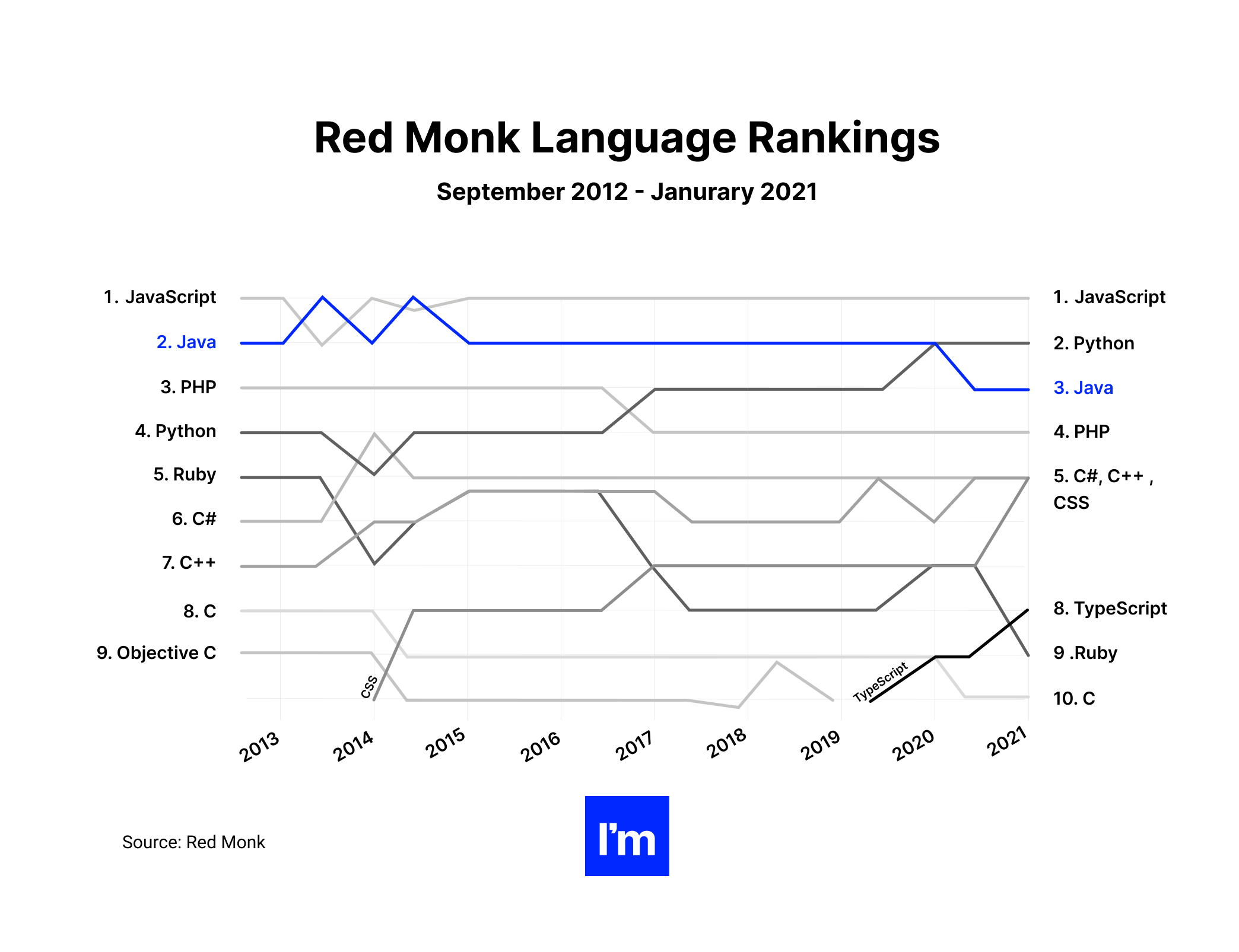
What makes Java the glue for thousands of business application and mobile app projects? That’s what we are going to explore throughout the next few chapters. But first, let’s see why we think Java is relevant for any startup, enterprise, or mobile business.
Why should you care about Java?
We are exploring the business benefits of Java in the Pros and cons of Java development. But to get started, here are three strong reasons why Java is worth your attention:
- Java is the official programming language for Android, the operating system which runs on 73% of global smartphones.
- The language runs on 97% of enterprise desktop computers.
- More than 222,700 companies use Java globally, including nearly 91,000 organizations in the USA.
Is Java free to use?
It depends. Before 2019, Java offered free licensing. Starting from 2019, Oracle introduced fees for Java versions 9 and up. The pricing varies from one Java version to another. For instance, Java SE 11 is available for free under an open-source license. But generally, the latest Java releases carry a subscription fee for commercial use, while individuals and open-source users are still welcome to use Java with no charges.
As per licensing costs, desktop pricing is $2.5 per user per month, and discounts apply with tiered volumes. The server and cloud use also requires a payment ($25/month or less). But apart from these costs, there’s a huge selection of free Java IDEs, frameworks, and libraries.
→ Get more information about Java’s current pricing on this website.
Must-know Java terminology
Before we move forward, there are a few Java-related terms worth knowing. You may come across them in the following sections and other Java-related resources.
The following list is not exhaustive but includes the minimum terminology you should be familiar with. For a comprehensive dictionary of all Java-related terms, go here.
- Java class - a basic building block of Java. It’s a template or a blueprint that describes an instance of each class using methods and variables. For example, a class ‘Cat’ would tell how instances of cats look and behave like. One class can be used to create multiple instances.
- Class instance - a particular object created for a given class. It has its specific states and behaviors. For example, a cat has a name, size, color, breed (states) and displays certain behaviors (sleeping, meowing, scratching the couch, etc.).
- Method - a block of code triggering a specific behavior. For example, when executed, a method meow() can make the object cat meow. A class can contain multiple methods.
- Instance variable - variables store data values, such as text, whole numbers, single characters, etc. For example, our cat may use a variable name with the value “Grumpy.”
- Java native interface - an interface that enables non-Java programmers to run code in a Java Virtual Machine when an app cannot be entirely written in Java.
- Java runtime environment (JRE) - a piece of software running on top of a device’s OS that provides all resources essential to run Java code. JRE contains Java class libraries, Java loader, and Java virtual machine. No Java program can run without JRE.
- Java virtual machine (JVM) - a virtual machine that enables a device to run Java and non-Java programs compiled to Java bytecode. JVMs allow Java programmers to write code once and run it on many platforms and systems. See also Java virtual machine.
- Java development kit (JDK) - Java development environment that includes tools useful for developing, testing, and running programs written in Java. It contains the Java runtime environment (JRE), a compiler, an interpreter, an archiver, a documentation generator, and more resources needed for professional Java development.
Further reading
02 What can you do with Java?
Java is all over the place, from hardware to data centers, smartphones to AI bots, enterprise software to e-commerce websites. The general-purpose language appears in web and mobile apps, enterprise solutions, online games, big data apps, and hardware OSs.
Java applications: FAQs
Can Java be used for web development?
Yes, and in fact, 52% of Java’s applications are web services. There are plenty of Java web development frameworks and tools out there, allowing developers to build web applications quickly. Programmers can also leverage the so-called servlet APIs or programs that run on Java-enabled web or application servers. They help Java developers receive, process, and respond to requests sent by a web server. To create cross-platform web content rapidly, Java experts also use JavaServer Pages.
Can Java be used for mobile application development?
Indeed, as the default Android development technology, Java is one of the most preferred languages for mobile app development. It allows building eye-catching, fast, and interactive mobile apps, especially in combination with Kotlin. That said, when we look at iOS, Java is hardly a top choice for programming.
Is Java good for microservices?
Not good - excellent. Even though microservices weren’t designed for implementation in a specific programming language, several Java features make it the preferred choice for their delivery. These include the support for service-oriented architecture, easy-to-read annotation syntax, integrated user interfaces, portability, and a vast spectrum of Java microservices frameworks and libraries.
Is Java good for game development?
Java has brought us classics such as Bejeweled, Football Tycoon, The Elder Scrolls Travels, Doom II, and - above all - Minecraft. It powers numerous blockbusters that run on PCs and even more hits played on mobile devices. One reason for that is the LibGDX game engine, which allows developers to write, test, and debug games on desktop PCs and Android devices simultaneously. However, Java is not recommended to program advanced, RAM-intensive games, especially on consoles.
What about machine learning for Java developers?
Java is considered one of the most reliable technologies for AI and ML projects after Python. This is because it offers an abundance of frameworks and libraries for machine learning development, such as SAMOA, Datumbox, Mahout, JavaML, or ELKI. Other features that make Java advantageous in this field include high scalability, code portability, easy-to-code algorithms, convenient debugging, and a built-in garbage collector.
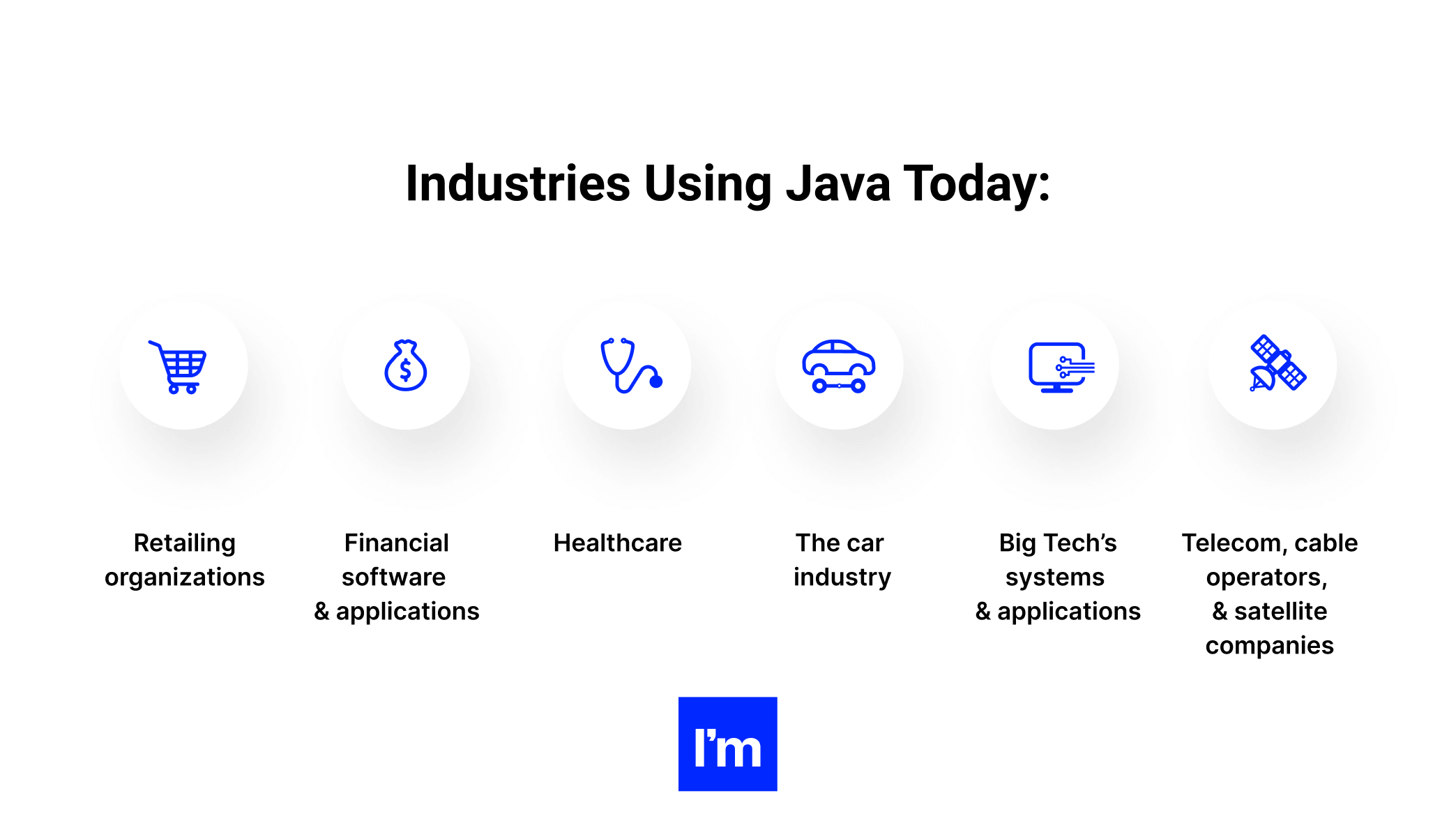
Traditionally, when we think of Java, we think of ‘corporate platforms.’ Indeed, the enterprise inclinations of the language are unquestionable. Still, it would be wrong to reduce Java uses to enterprise apps only. Oracle is constantly striving to make the language appropriate for other uses as well. Below are some examples.
- Java dominates the tech stack of many leading retailing organizations, powering their websites, web apps, and business systems.
Examples: Amazon, Target, Walmart
- Programmers use Java extensively to develop healthcare diagnostic and interventional systems, wearable devices, practice and health management systems, and BI tools for practice and hospital management.
Examples: CVS Health, Samsung Healthcare, Cardinal Health
- Java has been the go-to technology for developing financial software and applications for years because of its wide range of in-built security features. In fact, 44% of Java developers use the language for building finance-related software.
Examples: Citi Group, J.P.Morgan, Bank of America
- Telecom organizations, cable operators, and satellite companies tap into Java’s rich collection of frameworks and libraries to roll out billing and operations support systems and other strategic software.
Examples: AT&T, Comcast, T-Mobile
- We can also find Java in the back-end of Big Tech’s systems and applications. For example, Google uses Java to power its critical apps like Google Docs. Java also powers the core of many YouTube apps, such as YouTube Premium, YouTube Go, YouTube TV, and more.
The car industry makes an interesting case of Java use. Modern vehicles are jam-packed with robotics and automation systems, many of which are written in Java.
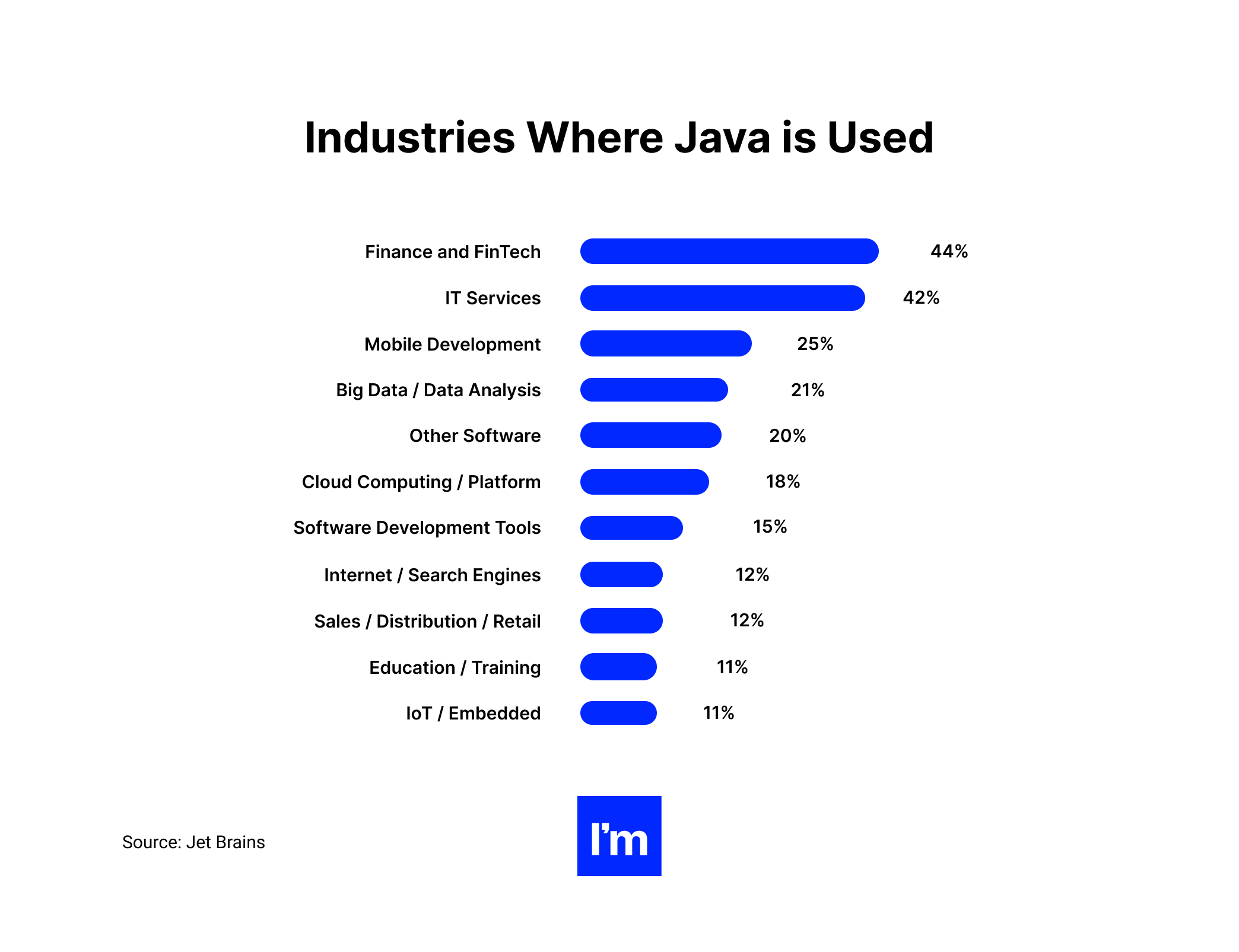
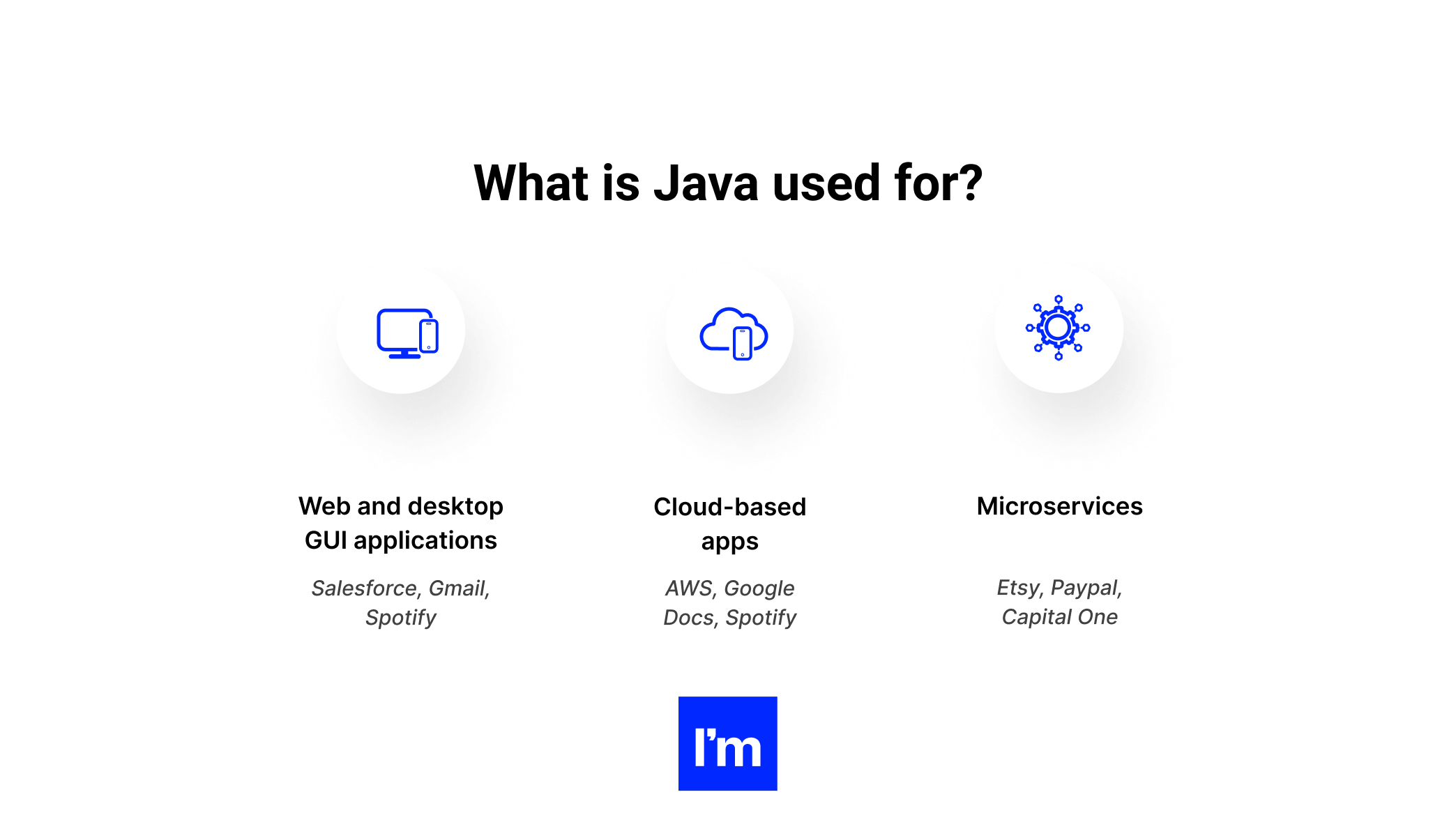
Computer software, web development, and mobile application development are widely explored domains for Java. But Java also plays a significant role in creating data science and machine learning platforms, edge systems, IoT infrastructure, and microservices-based software.
Web and desktop GUI applications
Who uses Java: Salesforce, Gmail, Spotify
Why: The portability of Java makes it an excellent choice for web apps. Instead of writing or extending code separately for each platform or device, Java developers can build one code and then run it on various environments. This gives businesses a huge time and resource advantage.
Another factor contributing to Java web development popularity is a rich set of Java web development frameworks and APIs. The first ones enable swift integration of advanced features into the website, saving developers time writing code. The second automate many developers’ tasks and ensure code consistency, contributing to faster development and streamlined experience with Java-based apps and GUIs.
→ Prominent examples of Java frameworks for building web apps and websites include Spring, Struts, Grails, and Hibernate. You’ll learn more about them in the section Java technology landscape: frameworks & libraries.
A thing not to be overlooked about Java is its multithreading capability, allowing the language to run and execute multiple tasks simultaneously. This translates to improved throughput and server responsiveness, better use of CPU, and as a result - smoother user experience when using Java-based web apps.
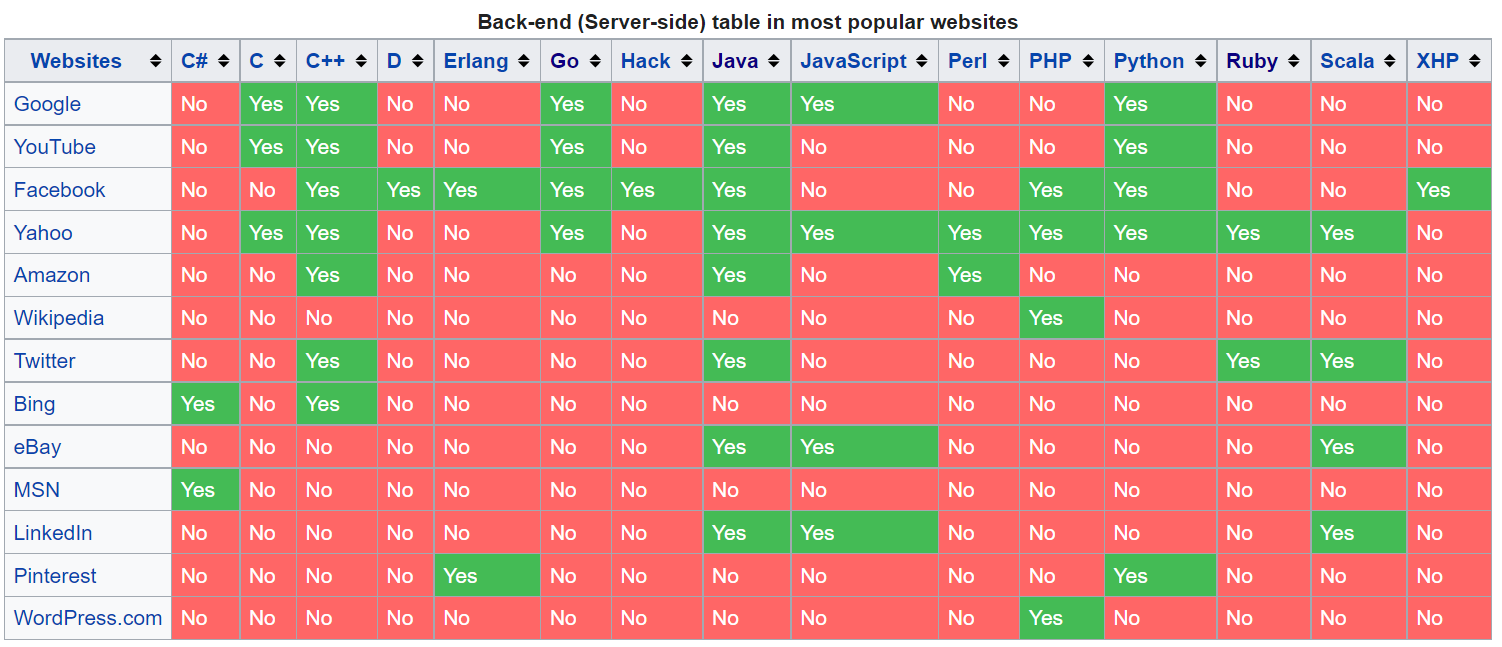
Java is the domineering back-end technology in the world’s most popular websites
The above merits of Java contribute to its being one of the top languages for creating responsive GUIs (graphical user interfaces). In addition, Java also provides immediate visual feedback on code updates, so developers can instantly see the results of their work.
But the main reason why GUI development in Java has many supporters is the profusion of Java GUI frameworks and builders that streamline interface development. While it is possible to build GUIs in Java from scratch, most programmers command frameworks for faster, more efficient development.
Top examples of Java GUI frameworks include SWT, Swing, AWT, and Apache Pivot.
Cloud-based apps
Who uses Java: AWS, Google Docs, Spotify
Why: Java is the enabler of numerous modern technology approaches, one of them being cloud computing. Its robustness, efficiency, and multiple-platform support resolve some of the key challenges cloud developers face.
Java’s ‘write once, run anywhere’ capability provides strong support for decentralized cloud applications and resource scalability. Fast data processing enables handling large data sets within short time frames - essential for working with cloud-based data management apps. Java also ensures a stable, reliable architecture. It is crucial for cloud-based platforms with thousands of users simultaneously accessing a profusion of virtual and physical resources.
Additionally, Java offers a host of cloud development tools that reduce the engineering effort when working with applications in the cloud. Examples include:
- Java Cloud Service - a platform as a service solution to build, deploy, and manage Java Enterprise apps.
- Openshift - a similar solution by Red Hat that enables fast Java application development, hosting, and scaling.
- IBM SmartCloud - a collection of enterprise-class cloud computing technologies and services useful for building private, public, and hybrid clouds.
Microservices
Who uses Java: Etsy, Paypal, Capital One
Why: Microservices have entered mainstream programming as a distinctive method of developing software. They replace cumbersome and rigid monolithic apps with convenient services that can be coupled or work independently. Such an architecture approach allows greater service reusability, higher code reliability, and easier scaling and maintenance, among other benefits.
Microservices have evolved from the service-oriented architecture (SOA) pattern, which uses reusable software components. And SOA is one of the leading architecture approaches in Java-based software. By extension, Java has become the language of choice to develop microservices alongside Python or Go.
There are quite a few Java microservices frameworks out there. These include Jersey, an open-source framework for developing RESTful web services in Java, Swagger - a highly popular framework for documenting RESTful APIs, Spring Boot, Restlet, Dropwizard, and many more.
Can startups use Java?
Java is huge in the corporate world, but it does not exclude its application in startups. While lightweight programming approaches like React or Python tend to be more popular among growing businesses, Java also fits well in numerous startup projects.
Thousands of startups build their products using Java. Some well-known names include: Sprout Social, Upwork, Route, InvestCloud, Grindr, Neustar, TigerConnect, Sketchy, Grammarly, Sift, and Miro.
There are several reasons why startups continue to rely on Java in some of their projects:
- Large Java talent pool,
- Stable, performant language = a reliable platform,
- Rich resources and guidelines for smooth implementation,
- A broad range of development, debugging, and testing tools,
- A huge community help solve issues fast if programmers get stuck,
- The massive number of big data and data analytics tools based on the JVM,
- Embedded support for Android mobile development.
We explore all of them in the section Pros and cons of Java development.
What is Java Enterprise Edition (Java EE)?
As mentioned in the intro, Java provides four different environments for its language that serve various purposes - and company sizes.
Java Standard Environment, or Java SE, is the core platform, offering the essential functionalities of the programming language. This includes basic object and types definitions and more specific classes used to handle networking security, GUI, database access, and XML parsing development.
To develop corporate Java applications and software, large companies usually employ Java EE or Java Enterprise Edition. It is a robust collection of technologies and APIs extending the standard Java platform functions to support large-scale, business-critical distributed apps’ creation, testing, and deployment.
Some of the core specifications shipped with Java EE include:
- Java servlets for managing HTTP requests,
- Java WebSocket to facilitate WebSocket connections,
- Java APIs for handling web services (including creation, conversion from JSON data format to Java, mapping XML to Java),
- Java enterprise specifications - a set of specs to support more sophisticated, enterprise-grade program functions.
Java Micro Edition (Java ME) is often used to develop clients of Java Enterprise Edition services. It provides an API and a virtual machine for running Java apps on small devices.
JavaFX enables the creation of rich internet applications. As in the case of Java ME, JavaFX apps may be clients of Java EE services.
While organizations of all sizes can use Java SE, Java EE is more favored by distributed, large corporations
Mobile (Android) apps
Who uses Java: LinkedIn, Tinder, Uber
Why: Java is cut out for Android development because it was the first language officially used to write Android apps. Android OS heavily relies on the language and its libraries. And while today, Kotlin is slowly taking over, most Android mobile developers still need at least some basic grasp of Java to build their mobile apps for this platform.
Java Platform Micro Edition is a mobile edition of Java that provides a secure and powerful environment for building apps that target mobile devices. And since we’ve mentioned security, it’s one of Java’s core assets. The language comes with many inbuilt security features essential for building mobile apps for sectors like fintech, social media, healthcare, or banking.
Also, Java offers a wide spectrum of default design patterns that can be easily implemented and customized in a mobile app. It is highly compatible with mobile app builder platforms such as Android Studio.
Kotlin vs Java: Which one to choose for Android development?
Initially, Java was the standard technology for writing Android apps. However, since Kotlin emerged in 2011, Java has been gradually losing its Android market share.
In 2019, when Google named Kotlin the preferred language for Android development, Kotlin mobile app development has particularly started to grow in importance. So much that Android Studio, the standard Integrated Development Environment for creating Android apps, uses both Java and Kotlin as the official languages now.
What’s Kotlin?
Kotlin emerged in 2011, created by JetBrains to make coding in Java simpler and more productive. It is a modern, cross-platform and multi-purpose language known for a concise, effective syntax and pragmatic design. In addition, the language runs on JVM, making it 100% compatible with Java and allowing a seamless transition between the two languages.
Kotlin primarily serves native Android app development, but it can also support web and desktop apps, server-side development, and data science apps.
Kotlin’s strengths
- Kotlin is succinct. Using fewer lines of code translates to speedy development, streamlined code performance, and easy maintenance.
- Enhanced code readability leaves less room for errors and results in fewer crashes and system failures.
- The language is quite easy to use, especially if one already knows Java.
- It offers complete cross-platform support.
Kotlin’s weaknesses
- Compilation speed is probably the chief downside of Kotlin mobile app development. In some scenarios, the language is significantly slower than Java.
- Despite sharing a lot of common ground with Java, Kotlin still has its peculiarities. Getting familiar with them involves certain investments in training, even for experienced Java developers.
- Kotlin is a relatively young technology. Therefore, it cannot compare with Java regarding the community size and available specialists.
Kotlin’s popularity
According to Android’s data, more than 60% of Android developers have used Kotlin in some of their projects. Altogether, there are over 4.7 million Kotlin developers globally, making it the 13th most popular language in programming (Java takes 2nd place). It is also estimated that about 70% of the top 1,000 Android apps are based on the language.
Companies that currently use Kotlin to power their mobile apps include Airbnb, Basecamp, Tinder, Slack, Evernote, Netflix, Trello, Pinterest,
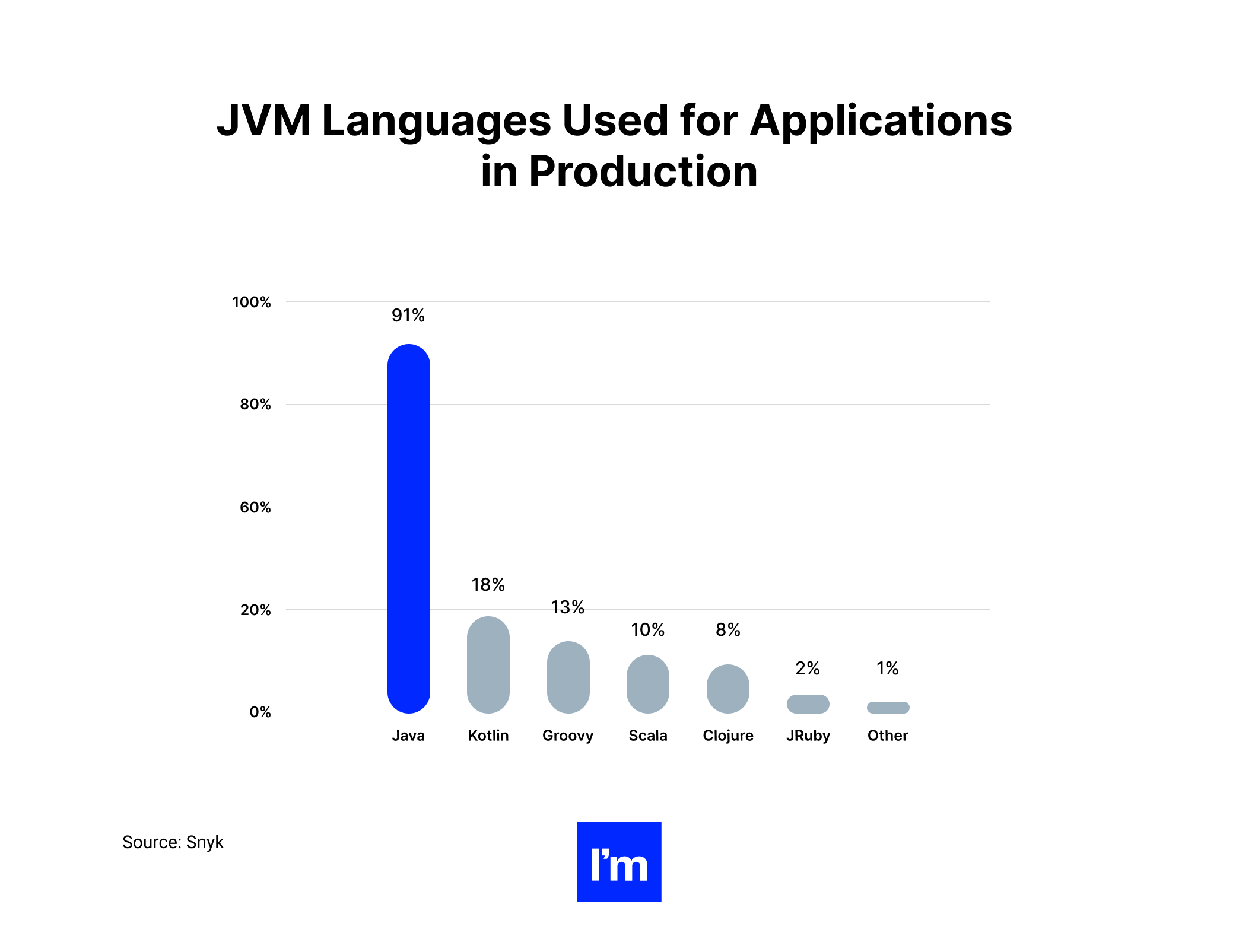
Kotlin increases in weight but Java still outranks it in overall popularity
Should you choose Java or Kotlin?
Despite the growing importance of Kotlin, saying that it wins over Java in Android development would be an overstatement. Both languages can be used to build performant, scalable mobile apps. True, Kotlin is the recommended Android technology today, but before making the final choice between it and Java, consult an expert Android development agency to determine which of them better suits your purposes.
Game development
Who uses Java: Minecraft, Flappy Bird, Wildermyth
Why: In the past, when PC was the platform of choice for most gamers, Java game development was thriving. However, once gaming consoles closed the performance gap, and Internet access became ubiquitous, other technologies, like C and C++, became the industry standard, outpacing Java.
One reason for that is the abundance of gaming engines and libraries that C++, in particular, offers. Java has its tools, like a popular jMonkey Engine for developing 3D games or libDGX, a cross-platform Java game development framework, but they come nowhere near C++ ones in terms of popularity. Another factor impacting the declining use of Java for AAA games is that major game consoles don’t have Java virtual machines. This adds a whole new level of complexity to developing games to these platforms in Java.
Despite the above, as the preferred Android language Java naturally dominates Android game development. To build simple mobile games, game makers take advantage of Android Studio, the official development environment for the OS. It provides a useful drag-and-drop interface, together with code editing, debugging, and testing tools (like graphics drivers, for example) to build Android games fast.
In addition, Java also frequently powers the server-side of browser games, implementing services like messaging or in-game purchases. It can also be efficiently used to create indie games, which don’t push the limits of technology, simple 2D action games, and puzzle games without sophisticated animations.
IoT and smart devices
Who uses Java: Galaxy Watch, Amazon Go, Smartcar
Why: One of the key Java features that make it well-positioned to power IoT and smart devices is its ability to run on a wide range of platforms. Millions of IoT devices use Embedded Java or a set of Java technologies designed for embedded systems. It allows developers to create, test, and debug code on their device, and then move it to the target device with a JVM.
Apart from that, Java code offers efficiency that allows IoT sensors and devices to exchange and retrieve data without delays and memory access violations. This is essential in smart systems that must communicate almost in real-time. Additionally, the language uses thousands of libraries and standard APIs, including hardware support libraries, which reduces the developers’ effort to bring IoT apps to market quickly.
Java also meets and exceeds the strict security requirements of connected smart devices through its embedded security features, a vast set of security APIs, tools and implementations, and projects like Java Card, a smart card with an embedded Java interface. It appears in in-vehicle systems, connected devices, smart meters, and gateways to authenticate users and protect systems from physical and network attacks.
All the above factors contribute to the heavy use of Java in IoT solutions ranging from remote patient monitoring and mHealth devices, through industrial automation solutions and self-driving cars, to smart home meters and retail IoT platforms.
Data science and machine learning
Who uses Java: Hitachi Vantara, Expedia, Canva
Why: Java is making inroads into data science, big data, and machine learning projects. This is because it provides not only a secure but also a highly portable platform. Other features of Java that make it advantageous for developing AI, ML, and data science software include cross-platform support, built-in performance optimizations (like the garbage collector), fast debugging, and scalability.
However, one of the greatest merits of Java, when applied in these modern verticals, is a large number of excellent frameworks and libraries for data science. We are exploring the most significant ones in the Java technology landscape: frameworks & libraries.
Key takeaways
- Java is an extremely versatile language used to build web, mobile, and desktop apps across numerous industries.
- Traditionally, it’s been considered an enterprise-grade language. However, many well-known startups use Java in their projects.
- Its top uses include corporate Java platforms, web applications, cloud-based software, microservices-based architecture, Android apps, IoT systems, and big data engines.
- Key industries taking advantage of Java include fintech & banking, healthcare, telecom and cybersecurity, retail, e-commerce, marketing, ICT, mobile gaming, and entertainment.
03 Java technology landscape: frameworks & libraries
Software development frameworks are so common these days that many programmers rely on them exclusively to build Java software. So let’s have a little run-through of the most popular of them and see how one can use them to facilitate project execution and delivery.
What are different frameworks in Java?
Frameworks are platforms for developing apps that lay the foundations for developers to build on. They may include predefined objects, classes, methods, functions and code libraries, compilers, interpreters, and other programs used by programmers to write code. By binding necessary tools together, frameworks help developers save time and effort in writing and testing repetitive code.
If you ask what the main benefit of using frameworks is for your project - there’s one simple answer: efficiency. Besides, as they provide ready, pre-tested components, frameworks positively affect the quality and reliability of the delivered code.
The most popular Java frameworks
There’s no shortage of Java frameworks. We have frameworks supporting the development of enterprise web apps, those helping developers build highly scalable systems, and others well-suited for creating and executing complex data processing workflows.
The most popular Java framework used in business applications is called Spring. To launch new projects, developers usually use Spring Boot, or a module of Spring used to build standalone apps with minimal configurations. Often, these tools are coupled with Hibernate.
Apart from these two frequently used tools, Wikipedia lists a few dozen Java frameworks. Going through all of them would be exhausting, so we'll stick to the most common ones these days. Most of them are designed to facilitate Java web development.
Java web and mobile development frameworks
The first type of frameworks are Java-based web and mobile development frameworks and Java GUI frameworks. They are used for the rapid development of web-based applications and graphical user interfaces.
Grails
Grails is written in the Groovy language, but it is fully compatible with Java and runs in the JVM. Lightweight and open source, it enhances developer productivity when building agile web applications. Grails is well-suited for dynamic projects based on short sprints, as it supports iterative development. The framework also strongly focuses on low maintenance, flat learning curve, and code reuse. Companies that use Grails include Google, Cisco, JPMorgan Chase, Sony, Walmart, Vodafone, UBS, Roche, and many more.
GWT Framework
GWT, or Google Web Toolkit, offers plenty of options required to build, debug, optimize, and run dynamic, fast-responding, GUI-based web applications. It is a popular web framework brought by Google, allowing developers to write Java code and deploy it as JavaScript in the front-end. The framework prioritizes developer productivity and user convenience, and it contains a library for mobile Java app development. AdWords or Google Wallet are examples of popular apps built with GWT.
Hibernate
Designed for relative databases, Hibernate maps Java classes to corresponding database tables for easier and faster database communication. The tool facilitates data creation, manipulation, and access, especially in systems that integrate with multiple databases. It is very easy to scale, modify, and configure and improves the developer experience using familiar CLI tools and IDE plugins.
JavaFX GUI Toolkit
This GUI toolkit comes pre-installed with the JDK package. It is a multi-featured software platform for developing portable, fully-featured desktop, web, and mobile applications. Its distinctive features include Scene Builder, a visual tool for designing UIs without coding, and TestFX, a unit test framework for running automated simulations of user interactions with the Java interface. Examples of companies using the toolkit include Oracle, Pivotal, DLSC Software & Consulting, Gluon, and KBC Bank.
JSF (Java Server Faces)
Java Server Faces (now called Jakarta Server Faces) provides the specification for building modular GUIs for browser-based apps. Published by Oracle, the framework has become the standard for building server-side interfaces in Java. Its primary goal is ease of use. The tool also allows developers great freedom when selecting mark-up language, protocol, or client device.
Java Virtual Machine
As we crack on the most common Java toolkits, we should mention the Java virtual machine, which enables other programs to execute in Java.
JVM is a part of the Java Runtime Environment and acts as an engine for running code in clients and servers. Originally designed just for Java, today, JVMs can support any language compiled to Java bytecode (the intermediate code processed by the JVM).
The way JVM works is that it processes the bytecode optimized by a just-in-time compiler and converts it to native code or machine-readable language easily understood by the OS (operating system). Apart from the compiler, every JVM includes a class loader. It’s responsible for loading Java classes into memory to be executed by the execution engine, also part of the JVM package.
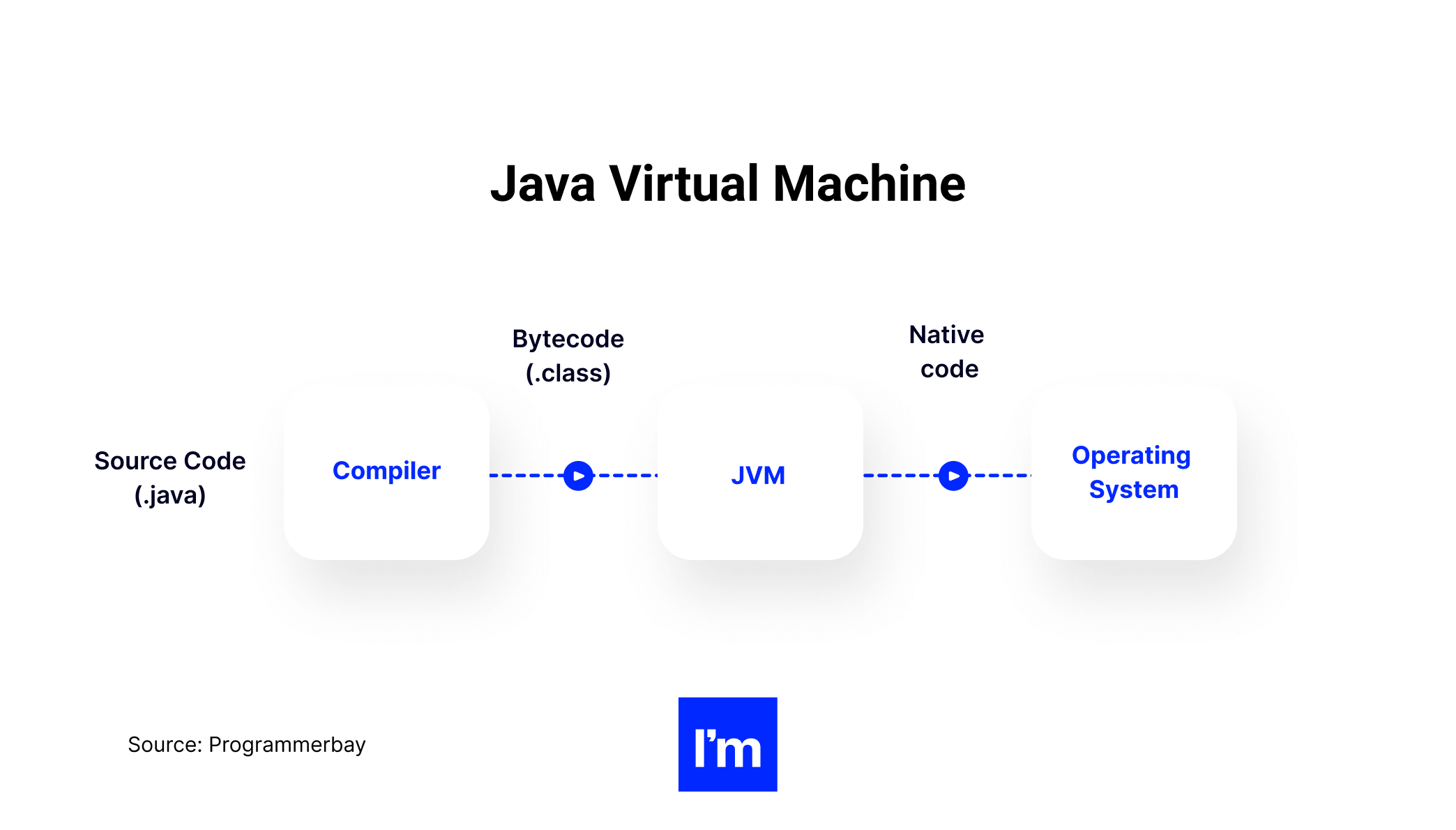
Since it’s a virtual machine, JVM is abstracted from the underlying device. This allows it to run Java class files across various platforms and devices without adjusting anything (in line with the ‘Write once, run anywhere’ approach). Another core function of JVM is the management and optimization of program memory.
GraalVM
Now, let’s also mention GraalVM, a high-performance JVM and JDK that aims to improve the interoperability performance of Java virtual machines. It consists of tools like a just-in-time compiler and ahead-of-time compilation engine that help make applications start and run faster. The solution supports Java code but can also be used with JavaScript, Python, Ruby, and others.
Micronaut
Micronaut is a relatively new framework designed to address some inefficiencies of more traditional toolkits (like Spring, for example). A modern, full-stack framework for building modular microservice and serverless apps uses ahead-of-time compilation to reduce application startup time and memory use. This is especially important when working with highly dynamic and scalable environments, like cloud web services (e.g., AWS Lambda) or container-based applications. The framework is compatible with Java, as well as other languages, including Kotlin and Scala.
Play Framework
As the name suggests, Play enables lightweight, web-friendly Java apps for web, desktop, and mobile interfaces. It is quite unique because it allows the creation of highly scalable apps without consuming much CPU and memory. Additionally, Play makes it possible to build web and mobile apps using one tool. Zalando, Walmart, Samsung, Verizon, LinkedIn, and EA are just a bunch of top names utilizing the tool in their apps.
Quarkus
Quarkus by Red Hat belongs to the new generation of frameworks designed to deliver blazing app startup speed and keep memory usage low. Its main focus is Kubernetes-native development. Quarkus aims to optimize Java code and efficiently deliver apps deployed in serverless, cloud, and Kubernetes environments. Even though the framework was first released in 2019, it’s production-ready and used by Backbase, JustChunks, Sensedia, and Moogsoft, among other tech companies.
Spring
This exhaustive open-source framework is the top developers’ choice for building scalable, high-performance enterprise applications, but it can support any Java-based project. It provides comprehensive tools (including Spring Data, Spring boot, Spring Cloud, Spring Security) to quickly deliver production-grade features to apps working locally and in the cloud. Additionally, Spring comes with an extension that allows developing mobile apps. It also includes a tool called Spring Native, which supports compiling Spring apps to native executables. The goal is to boot apps faster while reducing memory consumption. Netflix famously uses Spring as the core of its microservices architecture.
Stripes
An open-source web application framework by Atlassian, Stripes prioritizes simple conventions that minimize configuration overhead. The framework is conceived to be lightweight and simple, promising that programmers can set it up and start developing projects in less than 30 minutes. In addition, by simplifying development and maintenance work, Stripes enables a streamlined project delivery.
Struts
Struts is a free, open-source framework for creating modern Java web applications. It follows the model-view-controller pattern (MVC), which abstracts three core logical components of a software platform to create scalable, easily extensible projects. This makes it highly flexible, which enables programmers to build truly powerful applications in a short time. Altogether, Struts shares many features with Spring, and the choice between the two is often down to a developer’s preferences.
Tapestry
Written in pure Java, Tapestry is a component-oriented framework for creating highly scalable apps. It integrates easily with back-end and testing frameworks and prioritizes performance and coding efficiency, with features such as live reloading, client-side caching, or JavaScript aggregation. Like Stripes, Tapestry places convention over laborious configuration to simplify coding. Additionally, the framework puts tons of stress on scalability. On the flip side, it has a moderately steep learning curve, and implementing certain functions may require more work than other Java tools.
Vaadin
Vaadin is a component-based platform for rapid and agile development of web apps in Java and TypeScript. For example, developers can write an end-to-end business app in pure Java code or use a visual designer to create layouts. All Vaadin components are also mobile-first by design, so they adapt quickly to different screen sizes and provide a smooth touch-screen experience. The framework generally emphasizes UX and performance, which makes it a go-to tool in companies like Wells Fargo, Bank of America, JP Morgan Chase, GlaxoSmithKline, and Volkswagen.
Java machine learning and data science frameworks
Apache Spark
This powerful open-source analytics framework puts focus on the development speed. It is blazingly fast when it comes to large-scale data processing. Its libraries allow quick access to various data sources and business intelligence tools and let the developers query structured data using SQL or DataFrame API.
Datumbox
Datumbox is a simple yet effective framework enabling the rapid development of Java machine learning, natural language processing, and statistical applications. It has an extensive collection of models, algorithms, statistical tests, and other tools, with a broad spectrum of applications, from social media monitoring and SEO to text analysis and spam detection and elimination.
Encog
This advanced Java machine learning framework provides a variety of algorithms and classes for data processing and standardization. Created in 2008 to support genetic programming and other neural network technologies, it has evolved to be used in financial research and business analytics platforms.
Hadoop
Hadoop provides a software framework for distributed storage and processing of large sets of data. The open-source framework was originally meant for computer clusters and owed massive popularity to its ability to scale from single servers to thousands of machines. Despite Hadoop’s robust capabilities, the framework is quite easy to grasp for Java developers. Therefore, it’s often the first choice for programmers wanting to immerse themselves in big data and data science programming.
Mahout
Apache Mahout is a distributed, scalable algebra framework and recommendation engine that supports developers with data classification, clustering, recommendations, and processing. The technology is closely associated with Hadoop, also by Apache (Mahout algorithms are written on top of Hadoop). A slew of top companies uses Mahout in their projects. For instance, Twitter uses it to model user interest. LinkedIn applies its algorithms to figure out “People You May Know” and other user-related data. SpeedDate relies on it for its member profile recommendations.
MOA
MOA is another interesting Java-based framework applied in data science. It powers solutions for real-time data stream mining and analytics. In other words, MOA helps companies discover patterns and extract insights from constantly flowing evolving data records. Examples of data streams include web searches, mobile communication, and ATM transactions.
Neuroph
Neuroph is a lightweight Java framework that enables the creation and training of neural networks that solve business problems across various industries. The framework comes with a Java class library and a GUI tool, and it makes a good choice for beginners who are starting their journey with deep learning and neural network architectures.
Stanford CoreNLP
Another popular Java machine learning framework is CoreNLP, developed by a Stanford University research group. It is a robust and reliable natural language processing framework allowing computers to break down and interpret human language. Developers can leverage the capabilities of CoreNLP in search engines, spam filters, voice assistants, marketing SaaS, translation software, etc. Apart from English, the framework supports several languages, such as Arabic, Spanish, and Chinese.
And what about Java libraries?
We have already covered a lot of ground on Java frameworks. Let’s also mention a few popular Java libraries. What’s the distinction?
A library contains popular routines and resources, which can be retrieved by a program when needed. On the other hand, a framework can include different libraries, and it can call for the resources required to fill the missing gaps in a piece of code to deliver the necessary action.
Java has a massive ecosystem and a robust selection of libraries for any purpose and occasion. Developers can use communication, testing, logging, parsing, HTTP, bytecode, database connection, etc., libraries. Again, we will only feature a few that you are most likely to encounter in your Java project.
General-purpose Java libraries
These are core Java libraries providing various basic elements and functions.
- Apache Commons - a set of libraries that provide reusable Java components, ranging from compression, configuration, and validation up to network utilities, mathematics and statistics features, and cryptographic libraries.
- Google Guava - a collection of common Java libraries developed by Google engineers. Like Apache Commons, they cover many utilities and functionalities, including new collection types, a graph library, and tools for concurrency, caching, strings, and more.
Data science Java Libraries
Java offers strong support for data science through its rich collection of ML, AI, and data processing libraries that streamline the implementation of mathematical and scientific computations.
- Deeplearning4j - a commercial-grade deep learning toolkit/library to deploy neural nets.
- ELKI - a data mining library/framework focusing on research in algorithms.
- Java-ML - a collection of machine learning algorithms with a common interface.
- JSAT - a machine learning library for running statistical analyses.
- MALLET - an ML package useful for statistical language processing, document classification, information extraction, numerical optimization, and other machine learning functions.
- MLib - Apache’s scalable machine learning library comprises various learning algorithms, workflows, and other utilities.
- OpenCV - a library providing the tools for implementing real-time optimized computer vision. It can be used in video surveillance, web and mobile search, augmented reality gaming, new user interfaces, and many more areas.
- Weka - a handy tool for implementing data mining tasks. It comprises tools for data preparation, classification, regression, clustering, association, and visualization.
Java logging libraries
These utilities facilitate log event management, which is critical for smooth software performance and security. JDK ships with its logging utilities, but external solutions are also available and include:
- Log4J 2 - an upgraded version of Log4J 1, a logging utility for Java from Apache.
- LogBack - an alternative to Log4J, with fast implementation and broad configuration options.
- SLF4j - this library provides a simple abstraction of Java logging frameworks.
Java unit testing libraries
Any meticulous Java developer runs unit tests to validate isolated lines of code before committing them to production. Fortunately, there’s a ton of utilities that make this task less demanding, such as the following Java unit testing libraries:
Key takeaways
- Java has an immense set of frameworks and libraries used by developers to streamline development and write high-quality code.
- Apart from general-purpose tools like Spring or Apache Commons, the Java ecosystem includes dozens of specific web and mobile development libraries, data processing, AI & ML analytics, and other functions.
- The main business benefits of using these tools include faster time-to-market, more robust security, streamlines user experience, and higher team productivity.
04 Pros and cons of Java development
You already know so much about Java! How it began, where it is used, what frameworks and libraries are the most common... But to get a complete picture of the impact of Java programming on your project, you still need to know its benefits and shortcomings. So we will tackle them now.
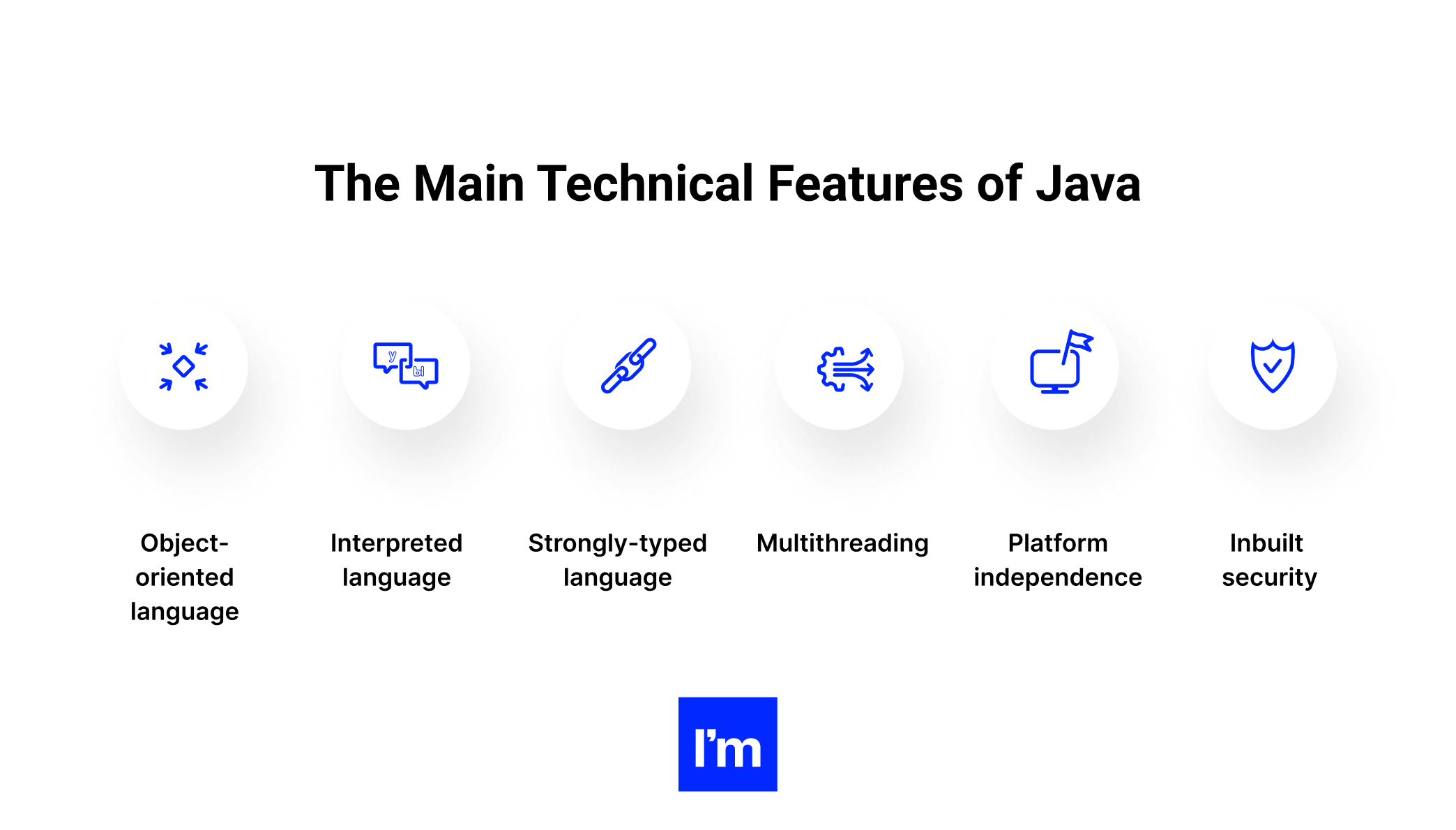
Before we dive deep into the pros and cons of using Java, let's decipher some key technical features of the language, as they have a bearing on its business relevance.
Java as a language is:
- Object-oriented language: In Java, everything is an object, made up of fields and attributes, as well as methods and procedures. Additionally, Java objects can be reused between programs. As a result, programmers can split large projects into compact, manageable parts, facilitating and speeding up coding.
- Interpreted language: Java implementations interpret and execute instructions on the fly without storing the bytecode anywhere. This results in more flexibility and faster development.
- Strongly-typed language: Each object must be assigned a data type (e.g., integer, character, etc.) that does not change once declared. When a programmer declares a variable of a certain type, the inbuilt compiler will check that it is always assigned values of that type and no other. The advantage is that you can spot and eliminate certain errors before the program is executed, reducing runtime errors.
- Multithreading: Java introduced the concept of multithreading to the programming world. In simple terms, it is a feature that allows simultaneously executing multiple tasks, represented as threads. The goal is to enhance performance, simplify coding, and reduce development time.
- Platform independence: Unlike many other popular languages, Java compiles into platform-independent bytecode. Each operating system has a unique JVM, which then converts the bytecode into the platform-specific machine language. The gain? A programmer can write Java code once in the OS of their choice and deploy it on all other OSs that support JVM without doing any handwork.
- Inbuilt security: Java comes with several features that make the code much less vulnerable. They include a Security Manager and a vast range of APIs, tools, and implementations of security algorithms and protocols.
Now let’s see how these and other technical aspects of Java pour over its business advantages (and disadvantages).
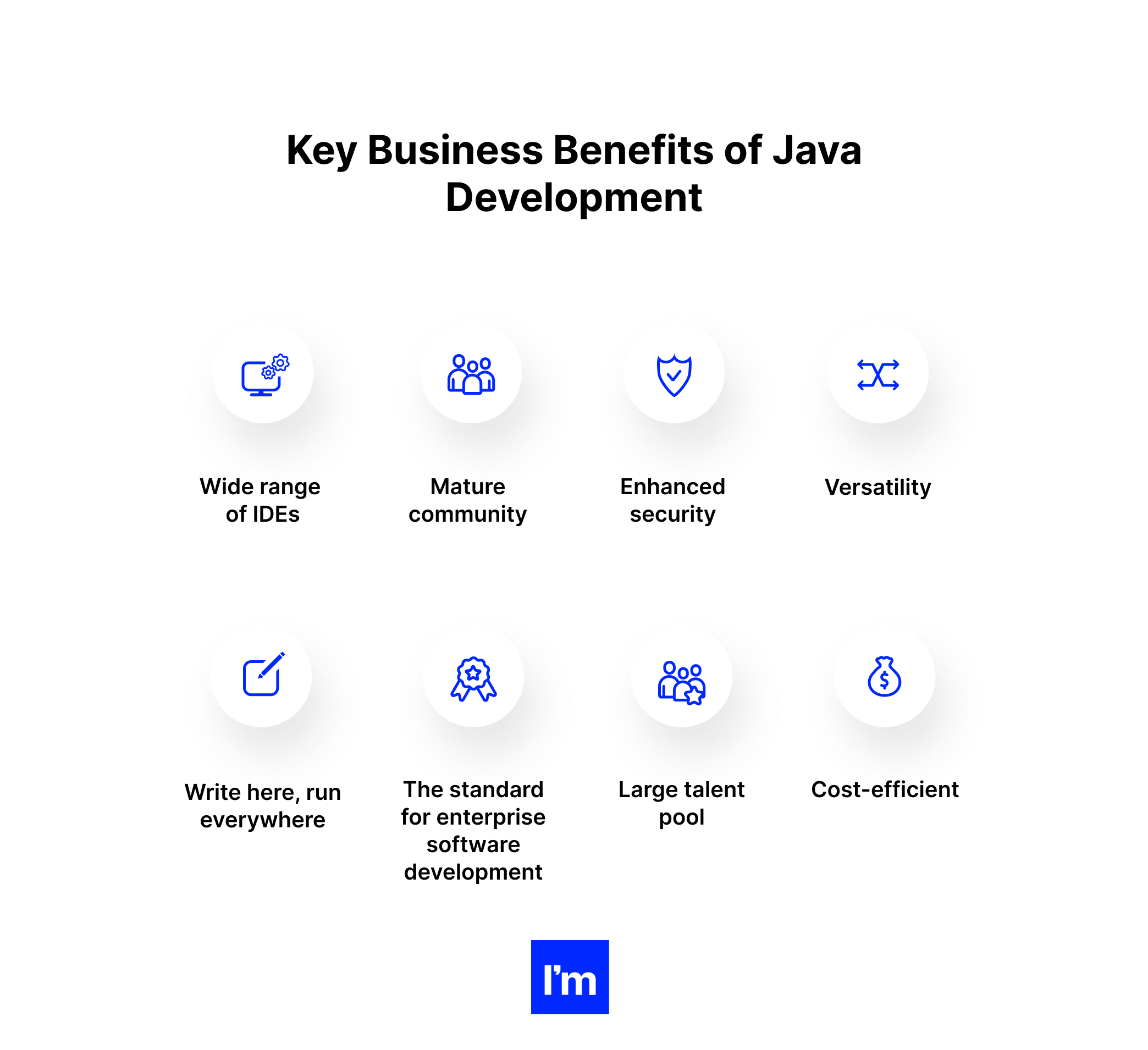
Java comes with a bundle of advantages that make it worthwhile for business. Intended for developing complex, reliable applications, it powers some of the most well-known software today. And which Java pros, in particular, compel business decision-makers to go with the language?
Wide range of IDEs
There are many Integrated Development Environments (IDEs) in Java, bundling all the tools needed to write Java code efficiently. The most popular Java development environments include Eclipse, IntelliJ IDEA, NetBeans, and BlueJ.
The vast selection of IDEs most primarily benefits programmers, but it also provides a business advantage. How? Allowing developers to choose the environment they feel at ease with improves the programming experience and speeds up the workflows. And this, in turn, reflects positively on the project delivery times and software quality.
Mature community
Even as a mature language, Java is constantly improving, thanks to the unmatched community of supporters. Used by over 35% of software specialists, it ranks among the top programming languages in the computer science curriculum at universities worldwide.
Data from popular online learning and teaching marketplaces confirm relentless interest in the language: Udemy offers nearly 1,000 courses in Java on different levels, while Coursera search shows almost 1,500 results for the Java-related query. Interestingly, Java community efforts have been formalized. In 1998, the Java Community Process was established to ensure Java technology's standard of stability and cross-platform compatibility.
Enhanced security
Java has always stood out in terms of security. Many factors contribute to that, some of which we have already listed above. On the whole, Java offers a well-defined access policy together with advanced access control and authentication mechanisms. The language also uses a variety of cryptography techniques and public key infrastructure policies and procedures.
Additionally, Java sandbox provides developers with an isolated space to securely run and test their apps without accessing the local disk or the company network. Finally, the language is very stable. These features make Java a popular choice in finance and banking apps, healthcare software, and telecom solutions.
→ For more examples of Java use, go back to the section What can you do with Java?
Versatility
Java features such as dynamic coding, platform-independency, and network-centric design make it applicable in various platforms and industries. Additionally, it offers a massive collection of frameworks and libraries written specifically for given sectors. Add a large pool of developers to the equation, and you’ll know why hundreds of thousands of companies in the world use Java, including 90% of Fortune 500 businesses (as the Internet has it).
Write here, run everywhere
Another hugely important benefit of Java is its portability. Platform independence means no changes are needed to ship the source code to different end-user devices or platforms. As a result, programmers can deliver the project far more quickly, as they only need to write the code once and then deploy it whenever necessary. Additionally, high portability positively impacts the end-user experience, as the users can seamlessly transition between different devices and keep their work in Java-based apps consistent. This is especially relevant in the era of BYOD and remote/hybrid collaboration.
The standard for enterprise software development
Built by Oracle to support enterprise-grade apps, Java shines in corporate applications. One reason for that is the multitude of libraries and frameworks adapted for specific purposes. Additionally, Java rolls out to multiple devices and OS types, making it ideal for supporting the needs of modern dispersed corporate teams.
Enhanced security features shipped with Java are yet another benefit not to be missed by enterprises. Last but not least, Oracle is constantly improving and upgrading the language. JDKs and associated software releases come out regularly every six months, which significantly boosts Java’s reliability and innovation.
Over 51 billion JVMs are currently running worldwide (Oracle)
Large talent pool
There’s a certain discrepancy when it comes to the estimates of Java developers’ workforce. But whether it’s 7.5 or 10 million Java specialists, one thing remains true - Java is one of the most widespread and popular programming languages in the world. As a result, finding qualified Java programmers is relatively easy compared to less prevalent languages. And the faster you build your Java dream team, the sooner you’ll reap the rewards of your completed project. Want to start now? Have a look at our stellar Java experts.
Cost-efficient
As we highlighted in the beginning, Java is no longer 100% free for commercial projects. Since 2019, Oracle has embraced a subscription-based model, which means that to develop your commercial project in Java, you’ll need to cover a small fee that depends on the number of developers and the features required.
Despite that, there are many ways in which Java helps businesses drive the project delivery costs down. As it is technologically agnostic, Java does not require any extra infrastructure investments. Instead, you can use the existing hardware to bring your project to life. Besides, Java’s portability translates to time efficiency. Developers enjoy the freedom of using the OS they feel the most productive with, and they don’t need to duplicate their work to support different end-user systems and devices. That’s a huge time-saver, which also helps save a pretty penny.
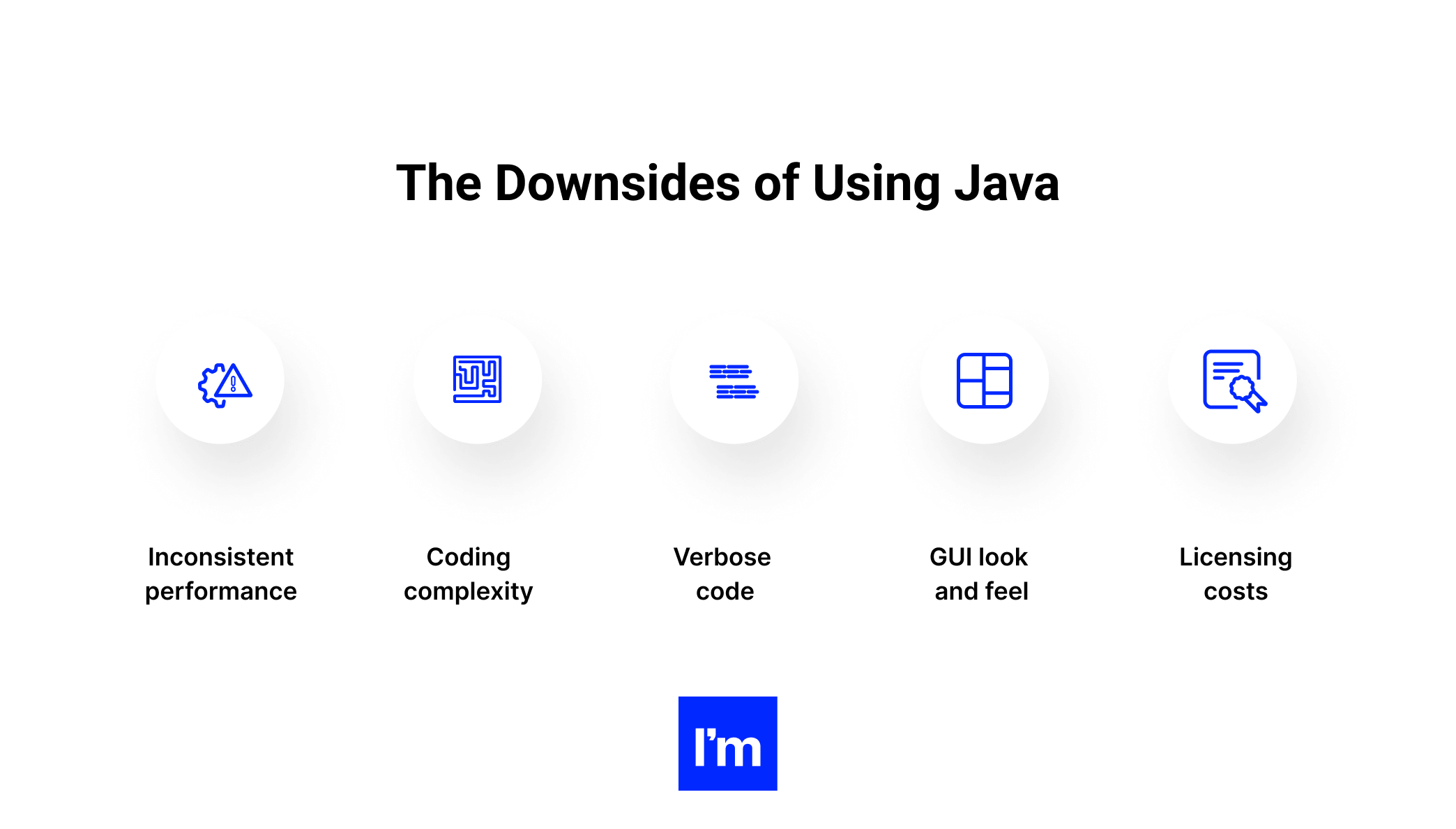
Every coin has two sides. So, let’s see what Java features do not work in the language’s favor.
Inconsistent performance
Performance is Java’s weak spot, based on several factors. For example, the poor use of garbage collection increases the memory space required for processing Java code. Or, reliance on JVM means that the code is interpreted at runtime, which causes a drop in performance. The introduction of the just-in-time compiler has given Java’s processing speed a considerable boost, but it remains inferior compared to languages like .NET, Go, or Rust.
Coding complexity
Opinions are divided as to whether programming Java is simple or difficult. Some developers claim that learning and using Java is straightforward, as the syntax is clean and the language drops many confusing concepts, like pointers or operator overloading. Only about 50 keywords are needed to build Java code, the portions of which can be conveniently reused across a project.
While all of this is true, many programmers complain about Java’s complexity. That’s because the trick of the trade to mastering Java isn’t to learn the language but to grasp its APIs. And there are thousands of them. Besides, getting familiar with dozens of Java toolkits and deciding which ones are the most suitable for a particular project takes time and effort. As a result, becoming proficient in Java is easier said than done.
Verbose code
Java syntax reads easily, and it is relatively easy to understand in isolation. However, the language has a bad name for being quite verbose, i.e., using too many words to execute an action (compared to other technologies). Programming in Java tends to produce considerable amounts of boilerplate code (i.e., code portions that must be reused repeatedly in a program with little alterations). This affects code readability and may impact the program performance and memory use in large projects.
On the other hand, verbosity is not an entirely bad thing, as it makes it easier for the Java compiler to debug code more effectively. But it certainly takes a lot of developers’ skills and experience to produce more concise Java code.
GUI look and feel
Unfortunately, the look and feel of Java-based applications often leave a lot to be desired. While programmers can choose from several GUI builders, none of them uses fully native GUI components. This makes developing modern user interfaces quite challenging in Java, especially in complex, multi-functional business applications. It is possible but requires advanced Java skills.
Licensing costs
Since Oracle introduced a new commercial licensing model for Java in 2019, commercial users need to pay for updates, bug fixes, and Oracle’s support. While the fee is rather low, it is still there. Besides, a failure to renew the subscription ceases your rights to use any software licensed under it, which might be a showstopper for some businesses considering Java use.
Key takeaways
- Java is an object-oriented, strongly-typed, and interpreted language that supports multithreading, cross-platform development, and “Write once, deploy anywhere” features.
- These characteristics streamline development, reduce coding effort, provide a stable code with enhanced security, and allow Java to be deployed to different platforms and devices in a wide range of sectors.
- On the other hand, Java’s performance lags behind some languages, and its code is quite verbose. This may negatively affect some developers’ experience. Java also requires advanced programming skills to deliver smooth and modern GUIs.
05 Java vs. other software development technologies
As we already know Java’s strengths and weaknesses, let’s see how the language compares to other programming technologies. Which ones offer higher performance, and which are more complex to use? What programming languages fit well in machine learning projects, and which will be more suitable for mobile apps? Let’s find out.
.NET vs Java
Not a programming language but a software development platform, .NET (also called Dotnet) was released by Microsoft in the early 2000s to build and run applications on Windows. It supports two implementations for developing backend apps, the .NET framework, and .NET core. Together, they provide various tools, languages, and libraries for writing apps to launch on other operating systems.
The first APIs offered by the platform included a web framework, a data access functionality, and a GUI desktop app library. By now, .NET has expanded to tens of thousands of pieces of shared code. .NET apps are written in the C#, F#, or Visual Basic languages, which are interoperable. They are used by companies like Microsoft, Accenture, The American Red Cross, Tesla, and Stack Exchange.
Speed of development
.NET is based on object-oriented programming, allowing developers to write code bit by bit to combine it into a larger software piece later on. The platform comes with the Visual Studio IDE that empowers developers to build their apps end-to-end in one place. This is a huge time-saver, provided that a programmer is already familiar with the tool. Additionally,.NET specialists can count on support from an active community of global developers. Additionally, since .NET became a cross-platform technology, it has allowed writing code once to be deployed on multiple OS.
However, Java offers the same advantages that streamline development speed: object-oriented paradigm support, powerful IDE, tons of libraries, robust community support, and cross-platform implementations.
Winner: a tie
Performance
Gauging .NET performance is not an easy task because of significant differences between its two implementations. .NET core stands out for high performance. The implementation provides built-in optimizations that automatically boost code performance without developers having to make any changes. One tool that stands out for speed is the ASP.NET framework for building interactive web apps and services. At 7 million requests per second/server, it offers unbeatable speed, head and shoulders above Java and most other languages.
In contrast, the .NET framework is not fast and requires programmers to apply various utilities to speed up the code execution. Besides, it’s notorious for memory leaks, which may affect app and OS performance over time.
Winner: .NET core, hands down
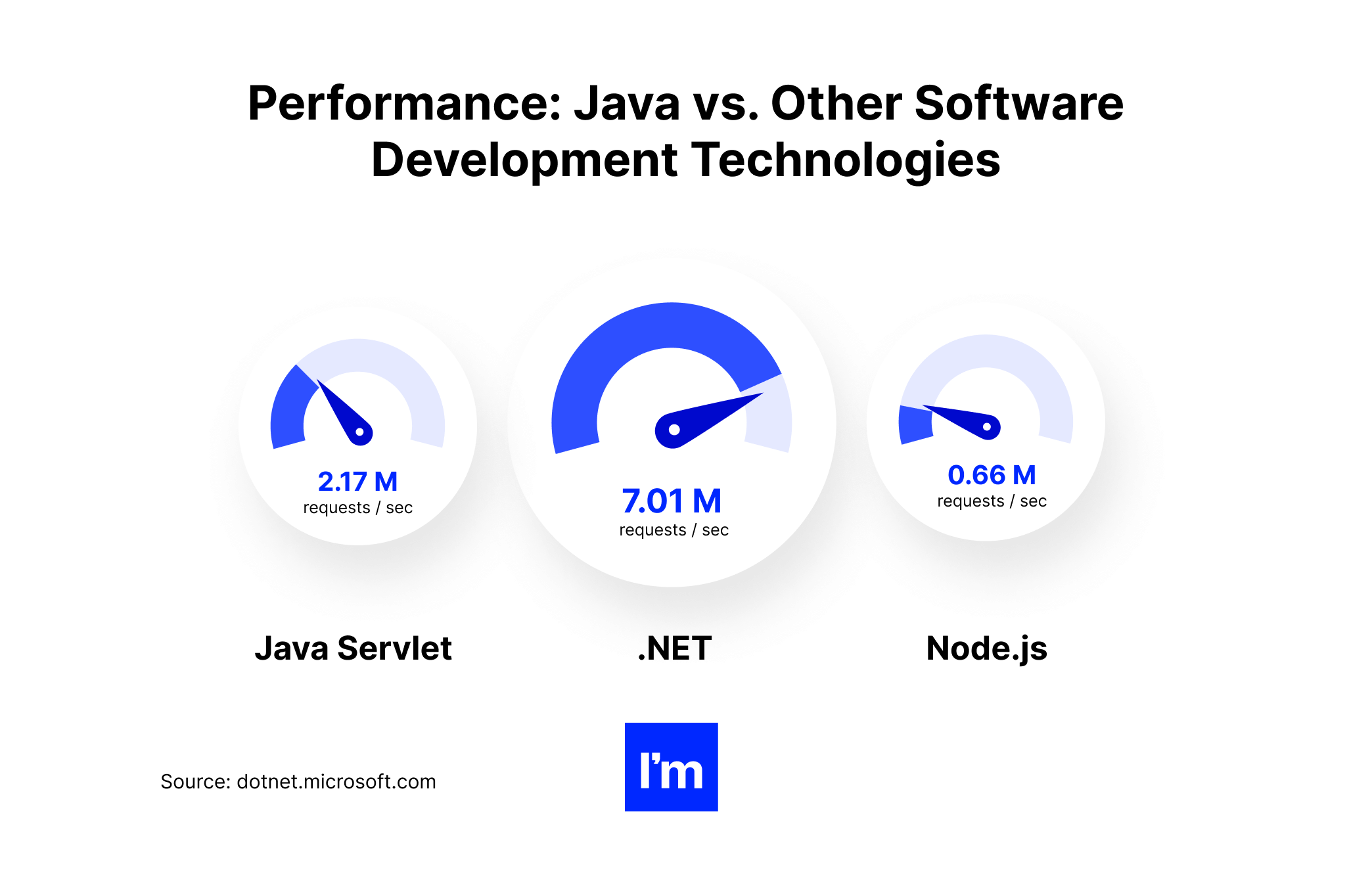
Versatility
In the past, .NET was only used for Windows apps, while Java could operate on any OS from the start. However, this is no longer relevant. Microsoft has opened the framework to be free and available for anyone and upgraded it to be compatible with other operating systems.
The .NET core implementation serves modern-day applications, like high-scale microservices, cloud-based apps, IoT solutions, ML software, etc. Besides, the platform supports the C# programming language. (see below)
Winner: .NET, by a hair
Cost of development
.NET comes with no licensing costs and free development tools for all platforms. However, Visual Studio, the default development platform for .NET, carries a monthly fee for commercial and enterprise-scale projects (from $45 per month). Access to advanced options like Azure services support also involves additional costs. And there aren’t the only .NET-related tools that may entail licensing fees.
Looking at developers’ earnings, in 2020, .NET specialists in the USA were making $93.3K/year on average, about $7000 less than Java specialists. Not a significant difference.
Winner: none
Talent pool
Trying to count .NET developers’ pool is like trying to boil the ocean. It’s extremely challenging to ascertain a “.NET developer” since .NET isn’t a language. On the whole, we can say that a .NET professional is a web programmer with a firm grasp of the .NET framework or .NET Core.
The only reliable data we can provide here comes from the official .NET website: +3,700 OSS company contributors. Based on other estimates we found, the number of programmers who use .NET varies between 6-8 million, which is slightly less than the size of the Java community.
Winner: Java, but it’s a close-run
Popularity
.NET Core is the most loved framework of all. 72.67% of developers praise the tool. But when we look at the .NET framework, only 42.14% of programmers appreciate it. Looking at web frameworks, ASP.NET also takes the win, with 71.47% of developers loving the platform. So, it’s safe to say that the .NET ecosystem is immensely popular among programmers. But how about companies?
One study found that .NET Core is among the five most sought-after frameworks by recruiters. However, the same survey names Java the second most in-demand language (59% of the companies surveyed look for Java skills). C#, so the core language behind the .NET platform is sought-after by 40% of companies, significantly less than Java. A global Google Trends search for .NET and Java developers confirm these findings
Winner: Java, slightly
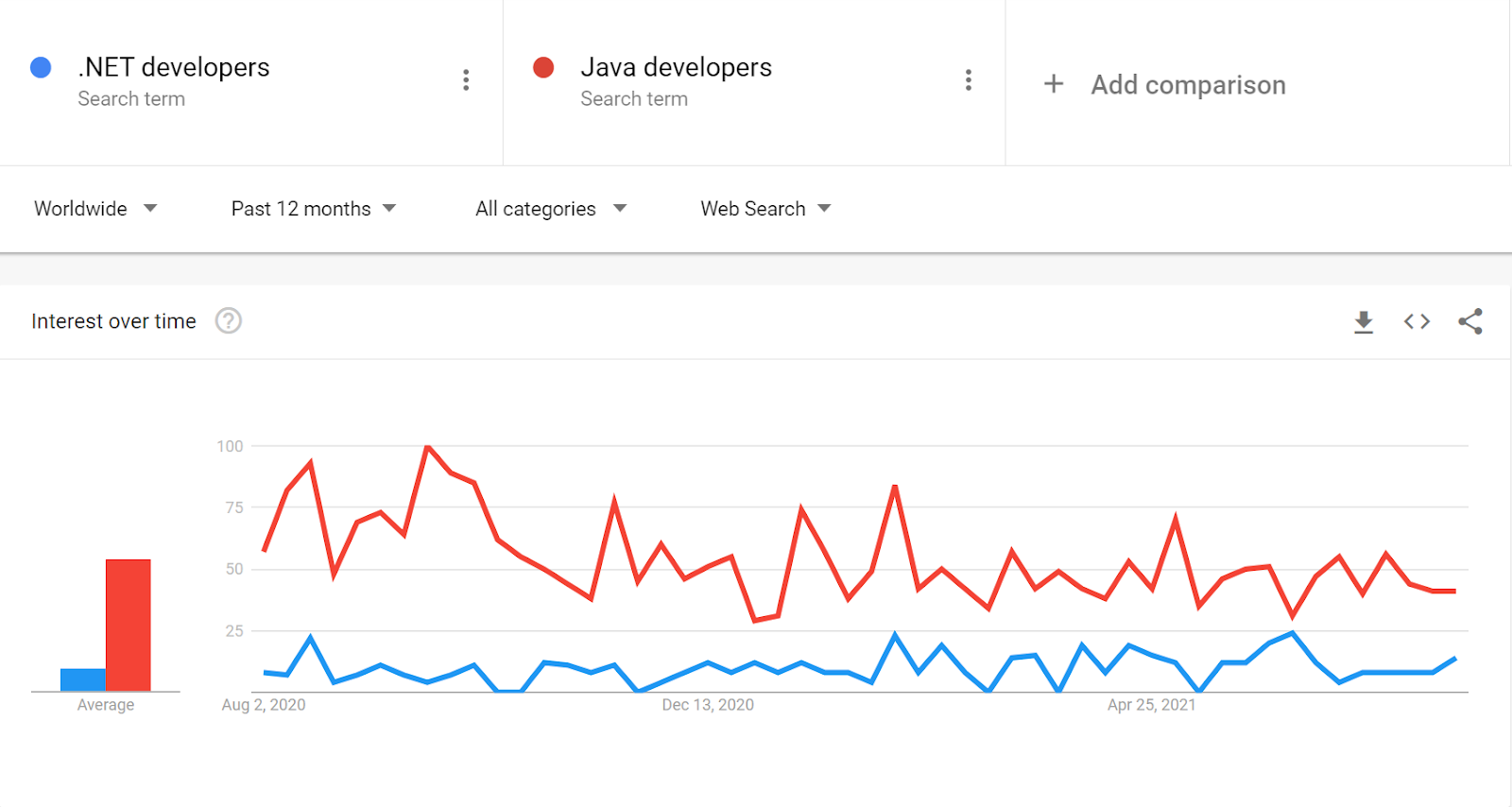
C vs. Java
Created in 1972 for use with the UNIX operating system, C is one of the most senior and widely used programming languages on our list. It was designed for efficient execution and cross-platform support and is commonly applied in operating systems, embedded systems, database development, and system and desktop applications.
C is a procedure-oriented, low-level, and compiled language. As opposed to Java, it breaks down into functions, which specify a program’s tasks. Because of its age and original purpose, C is present in most software platforms today, including those used by GitHub, MasterCard, Nokia, Oracle, VMWare, Adobe, IBM. In addition, it has heavily influenced the development of many younger languages, Java among them.
Speed of development
Java’s syntax is closer to human language than C’s, so it’s usually easier to grasp and use. Additionally, functions like garbage collection (enabling automatic memory management) and dynamic typing (where type checks are performed mostly at runtime) further streamline and facilitate coding for Java programmers. While working with C means that programmers need to manage memory allocation and management on their own, Java does it for them, shortening development time.
Winner: Java
Performance
Both C and Java are considered compiled languages. However, Java compiles to an intermediary JVM code. And as a low-level language, C sits close to the machine’s instruction set, working directly with the hardware. As a result, there’s no overhead related to bytecode compilation required by Java.
Additionally, the same Java enhancements that make it a more programmer-friendly language degrade the code performance. As a result, C is more applicable for programs that require ultra-speed. That said, Java’s just-in-time engine provides optimizations that make the apps run twice as fast as before.
Winner: C, by a slim margin
Versatility
Both C and Java were created for portability. Their source code can be written once and ported to any system or machine that supports them. Similarly, both languages are general-purpose. While Java is particularly useful in enterprise apps, web app backends, machine learning solutions, and data analysis engines, C finds broad applications in system programs, gaming, and desktop apps.
Winner: none
Cost of development
C is an open standard, available for anyone to use for free. It doesn’t have any source code but comes with different compilers and libraries that range from free to ridiculously expensive. But generally, it is possible to use it for free, even in commercial projects.
Let’s consider developers’ earnings. According to Stack Overflow’s survey, salaries of C and Java developers are comparable, standing at $50K/year for global programmers and $120-125K/year looking at the United States. Likewise, Indeed’s estimates are similar; the average base salary of a US-based Java developer is $102K/year + $5K of a cash bonus. The base pay is $100K/year for C developers, with +$5.6K of a cash bonus.
Winner: a tie
Talent pool
The number of Java developers ranges between 7-10 million globally. As stated by SlashData, there are 6.3 million programmers coding in C OR C++. Looking at Stack Overflow again, Java is used by over 35% of the world’s programmers’ population, almost twice as much compared to C’s community size (21%).
Winner: Java
Popularity
Both Java and C are immensely popular for similar reasons. They are mature, well-established, and powerful languages with many applications in business and other verticals. C powers Microsoft’s Windows kernel, which makes the language ubiquitous. On the other hand, when we look at mobile development, Java runs on Android devices, which control 73% of the global mobile device market.
When we consider the PYPL Index, which measures popularity trends in programming, we’ll see that Java is the second most sought-after language globally, while C is the 5th. Google Trends confirms the trend for both technologies.
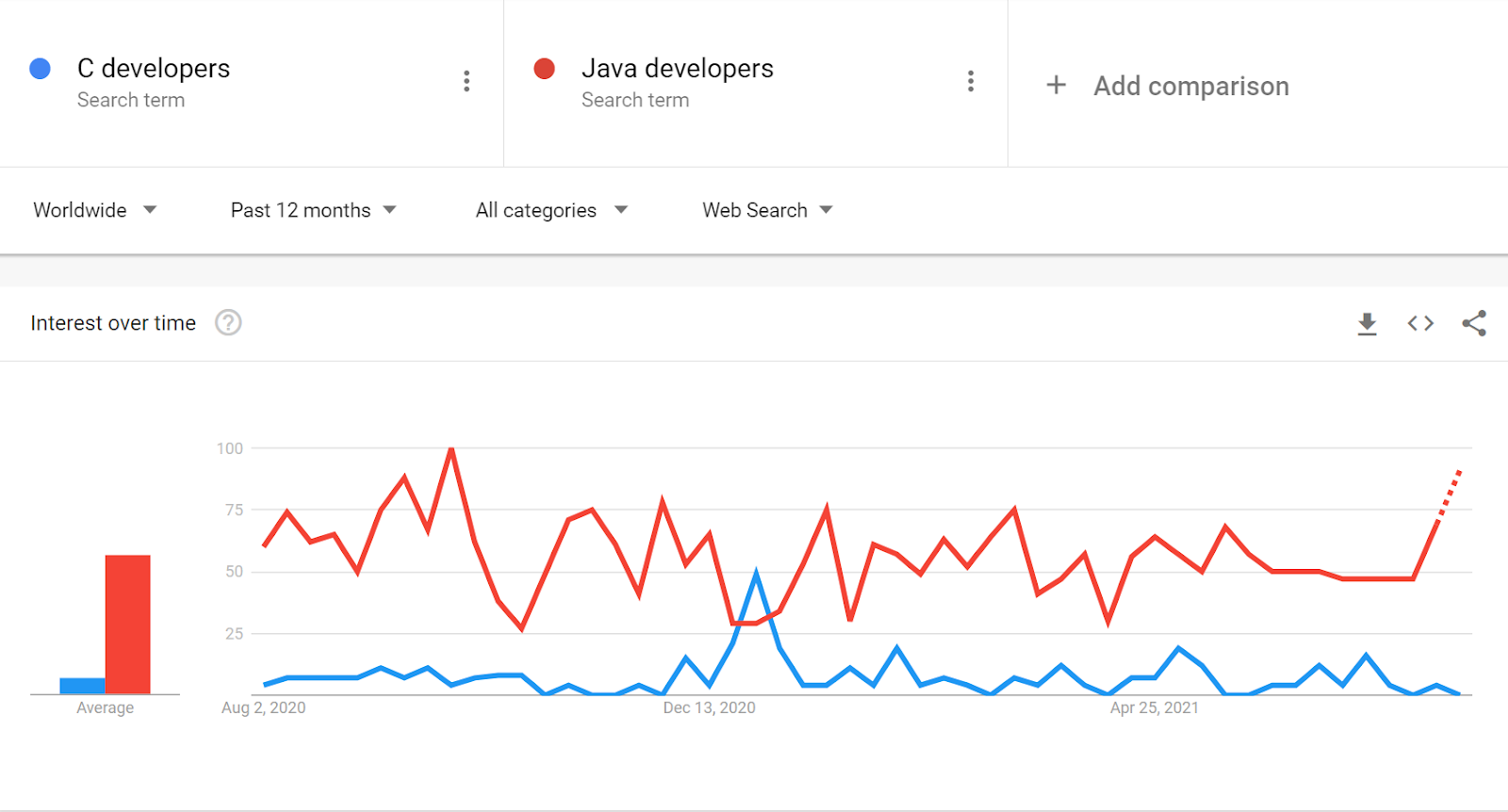
Winner: hard to tell
C# vs Java
C# is one of the most diverse and reliable programming languages used for developing desktop and web apps, web services, windows applications, and games. Created by Microsoft around 2000, it typically runs on the .NET framework, while it can also be used on other platforms. The language is versatile and multi-paradigm - it primarily follows object-oriented programming, but it can support different paradigms.
The distinguishing features of C# include portability and high efficiency. It has a succinct and reliable code optimized for performance and a smooth development experience. C# is also significantly easier to learn than C or C++. As technology backed by Microsoft, the language is constantly evolving with the changing developer and business needs.
→ Read more: C# vs Java: Which Is Better For Building Your Product?
Speed of development
Java and C# share a similar core syntax, and they both come with a massive set of libraries to streamline code development. C# has a mild learning curve, especially considering the extensive Microsoft documentation support and a large online community of peers. It also uses the concept of structs, or value types, which are usually faster to write than classes.
On the flip side, C# is tailored to the Microsoft environment, which requires developers to put in extra work to support other OSs. In consequence, the total project delivery speed may suffer. Besides, Java has fewer components than C#, highly reusable code, and many built-in features that make writing code quite efficient.
Winner: let’s call it a draw
Performance
Which one is faster? C# or Java? Benchmark comparisons don’t provide conclusive results. In some tests, Java takes the win in CPU load but fails massively on memory use. In others, C# has a comparable launch speed to Java.
For sure, contributors on both ends make significant investments in performance optimizations of their respective languages. Besides, the millisecond differences in speed won’t be noticeable for many end-users unless they apply to systems operating on huge data sets that need to be processed at a rate of knots.
Winner: none
Versatility
We already know what Java can do. The language is highly versatile and a top choice for writing complex business applications and Android apps. But C# also has a broad spectrum of applications, including web and mobile development and gaming. And actually, both technologies are often used to solve similar problems. However, even though C# can be used for web development, it isn’t optimized to that aim, slightly lagging behind Java.
Winner: leaning towards Java
Cost of development
The C# programming language itself costs nothing to use. However, some related tools that streamline C# development, like Visual Studio IDE, may require a subscription to access more advanced features.
Looking at labor costs, C# developers, although in lower demand than Java specialists, tend to get paid slightly more globally, $57K/year versus $50K/year. However, when we look at the USA, these proportions will be reversed. Both StackOverflow survey and Indeed’s base salary estimates agree that US-based Java experts tend to earn $800-1,000 more per month than their C#-skilled colleagues. Meanwhile, expert-level C# developers get about $49K/year in Poland, compared to $69K/year earned by the most senior and distinguished Java programmers.
→ See also section: The cost of Java development.
Winner: hard to tell
Talent pool
SlashData assesses C# community size at 6.7 million specialists, almost a million fewer than in the case of Java (other reports claim the Java community to be even bigger). This data aligns with StackOverflow’s data: with fewer than 28% of global programmers using C#. The language is less popular than Java, used by 35.5% of software developers.
Winner: Java
Popularity
The trend for using C# has been gradually decreasing in recent years. Today, 40% of global organizations look for developers coding in this language, compared to 59% of companies seeking Java skills. Among thousands of companies with C# in their tech stack, we’ll find Microsoft, Accenture, Stack Overflow, Citi, Boeing, and many more.
One look at the global Google Trends from the last 12 months testifies to Java’s advantage. The term ‘Java developers’ is searched for nine times more often than ‘C# developers.’ Interestingly, while the interest in C# remains on the same level, with small changes, the popularity of Java ebbs and flows.
Winner: Java again
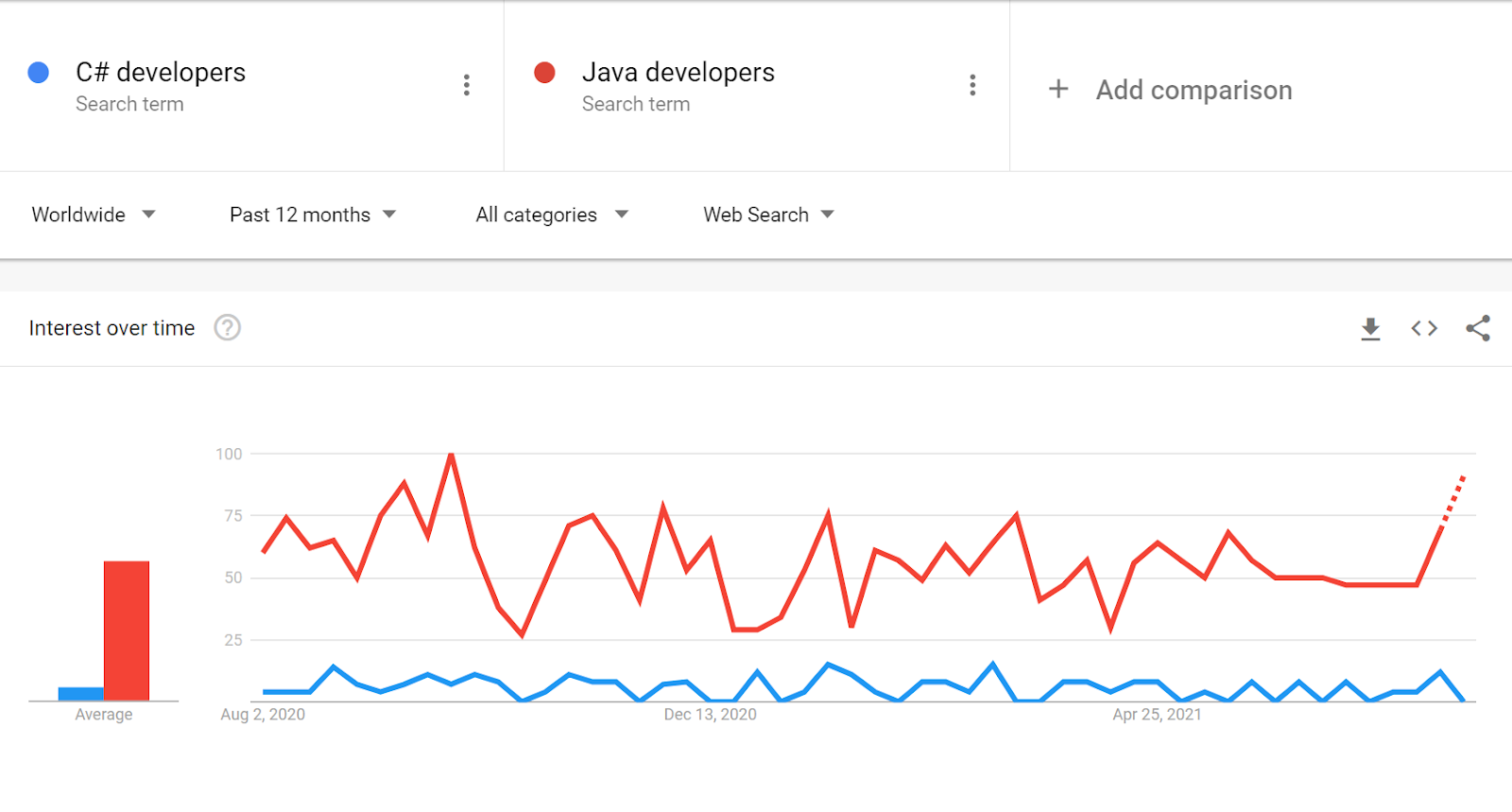
Go vs Java
The Go programming language makes it easy to build simple, reliable, and efficient software. It’s a relatively young technology (released in 2009), created by Google engineers to improve programming efficiency through high readability and usability, high-performance networking, and run-time efficiency.
Go is free and open source but developed and maintained by Google. Like Java, it is statically-typed, compiled, multi-paradigm, and it can serve multiple purposes. Go’s syntax shares many similarities with C, but the language has been optimized for modern, multi-core computers to run multiple processes simultaneously. As a result, it appears in a slew of internal Google projects and various cloud and server-side apps, DevOps tools, command-line software, and more. We can find Intel, Medium, Baidu, Uber, Docker, and Alibaba among Go users.
→ Read more: Go vs Java: Similarities, Differences, and Business Applications
Speed of development
Both Java and Go are based on C, but common origins are where the similarities end. Go is much more compact and simple to understand, while Java is robust and stable. But as Go affords developers more coding liberty, this comes at the price of being a more error-prone language. The technology has no error handling, so while it might take less time to write code, it can be extremely laborious when it comes to debugging. Additionally, Java offers a much broader set of tools to streamline development and make it less time-consuming.
Winner: none
Performance
Looking at benchmark reports, Go puts Java in the shade in many use cases, as it doesn’t rely on a VM for compilation. Instead, it compiles to machine code and runs on the device directly. And while Go doesn’t support the ‘write once, run everywhere’ paradigm by design, it has its means to deploy to various OSs without rewriting the core code from scratch.
Winner: Go, in most scenarios
Versatility
Go was originally intended to build software related to networking and infrastructure. Today, it has more uses, from cloud-based and server-side apps to AI and data science platforms. But as the language strives to accomplish everything, it hasn’t carved out its niche. Besides, at times, it is too simplistic to be used in sophisticated projects. We think it’s fair to say Go and Java are equally universal.
Winner: a draw
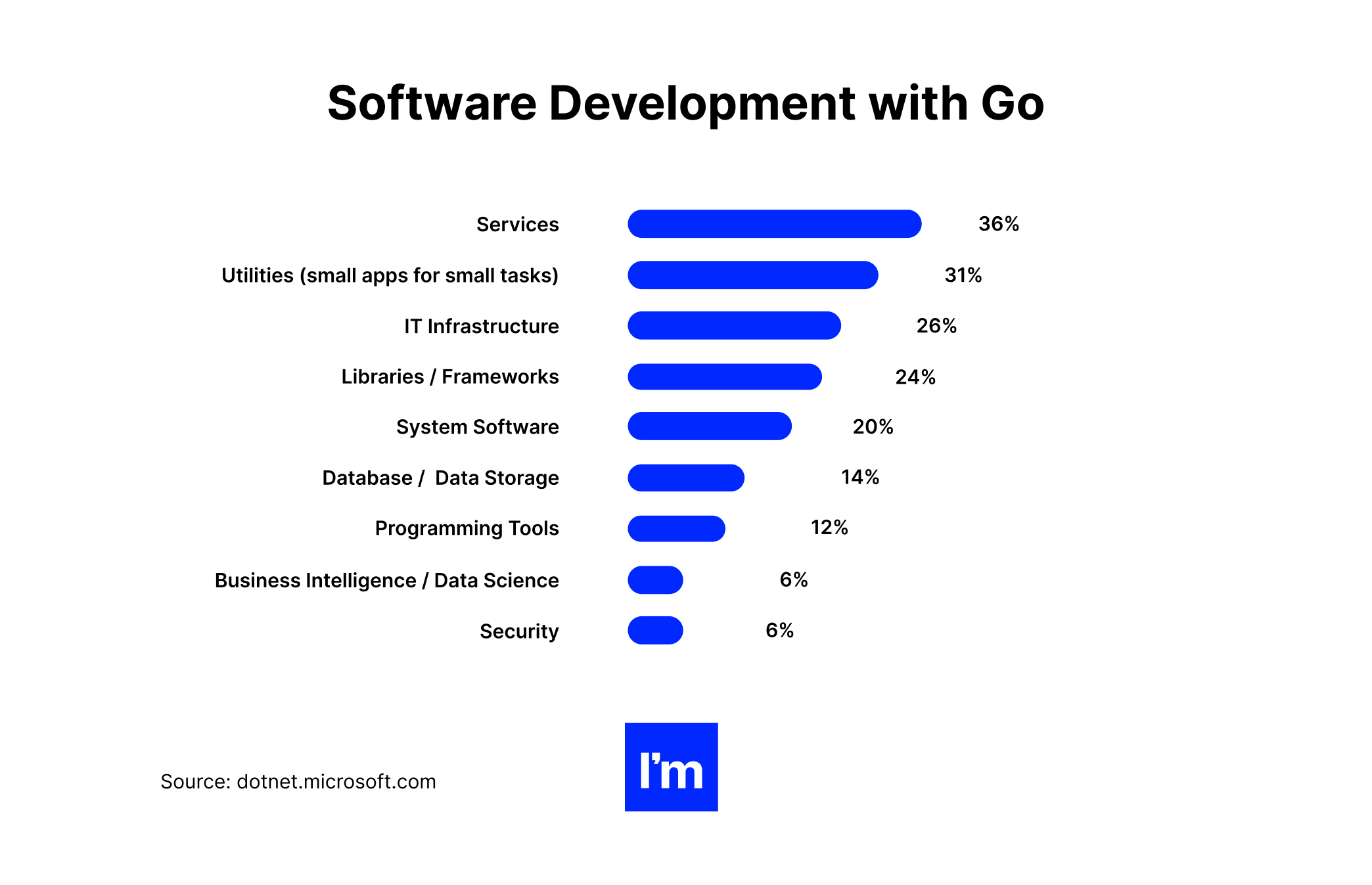
Cost of development
Go is the third highest-paid language in the world. In the US, it ranks even higher, at the second spot. If you want to hire a US-based Go expert full-time, be prepared to fork out $140K/year, on average. You can expect to pay from $74K/year for a Go professional by casting your nets globally. A Java developer will cost you at least $20K/year less, regardless of the location.
Winner: Java
Talent pool
Research shows that there are about 1.1 million Go developers in the world. More optimistic estimates increase that count to 2.7 million. Still, that’s three times fewer than Java. To sum up, Go programmers, are not only much more expensive compared to Java, but they are also far more difficult to find.
Winner: Java, easily
Popularity
About 9.5% of programmers use Go, compared to 35.5% working with Java. The PYPL ranking, which places Java in the top three of the most popular programming languages, puts Go in the 13th spot. Another report, which assesses the most in-demand programming skills on the labor market, finds that 13% of organizations are looking for Go developers. Compare it to 59% of companies seeking Java software development skills, and you’ll get the full picture.
Winner: Java, without a shadow of a doubt
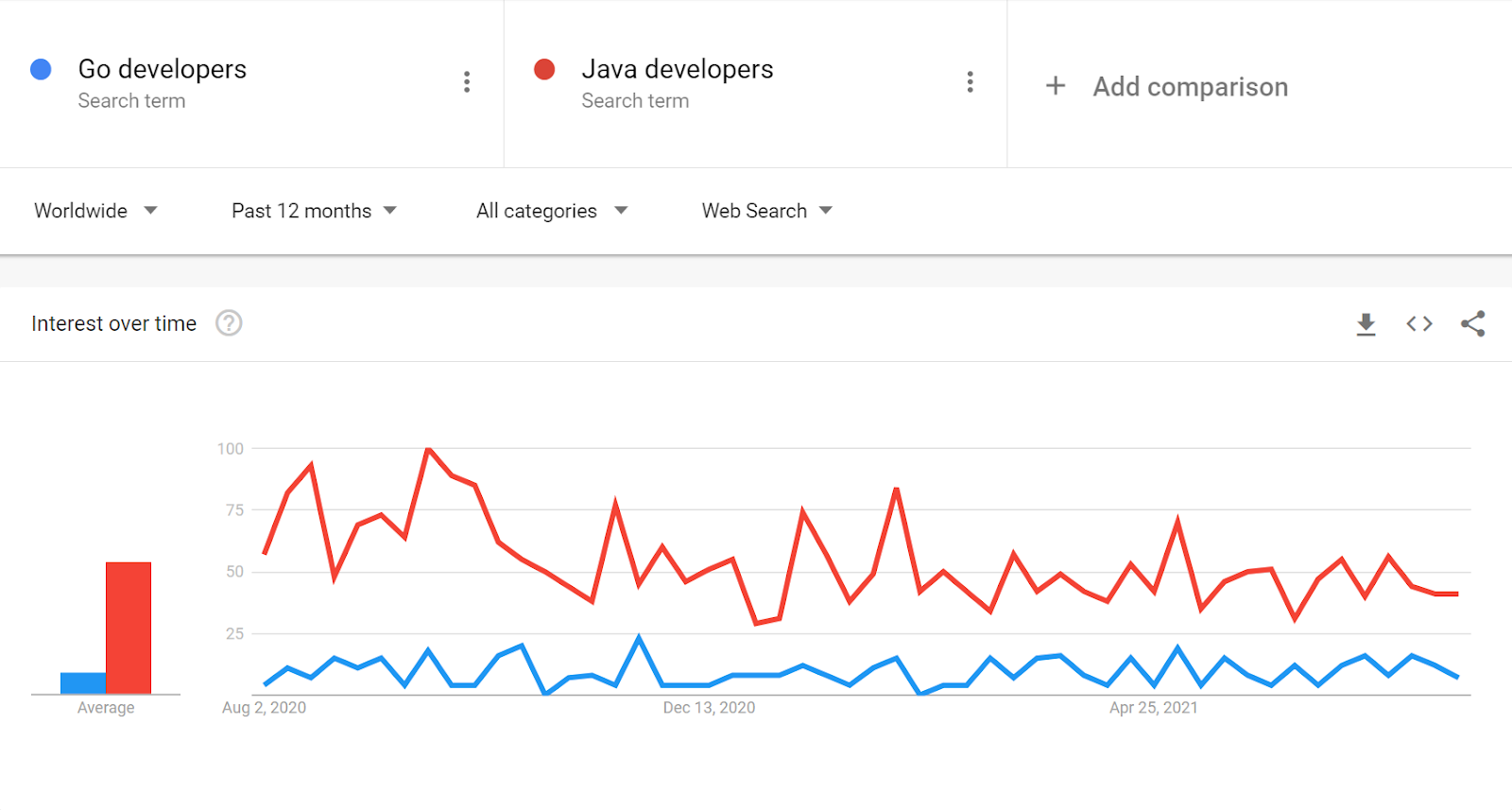
PHP vs Java
One of the most widely-used programming languages, PHP is a scripting technology designed for web development. The language appeared in 1994, and it has been regularly updated and improved ever since. Most large e-commerce, wiki, and CSM sites use PHP extensively. These include WordPress, Facebook, Amazon, Wikipedia, Etsy, and Slack.
PHP pages contain embedded HTML code instead of running commands to output HTML and trigger a particular action/state. The code is executed on the server.
→ Read more: PHP vs Java – The Best Choice For Web Development
Speed of development
PHP and Java have a moderate learning curve, especially if a developer is already familiar with other programming languages. Additionally, they both offer extensive tooling and vast community support – factors that make development easier and faster for programmers.
It seems that in recent versions, PHP has exceeded Java when it comes to development speed. As a result, coding the same software in PHP would probably take less time than in Java. Still, PHP code tends to be more error-prone than Java’s, as many issues surface at a later stage of development, leading to a more significant debugging overhead.
Winner: PHP in a close contest
Performance
Despite past complaints on PHP’s performance, the language contributors have applied numerous architectural improvements to speed up its processing. As a result, PHP version 7 and higher come with optimizations such as native PHP functions or using JSON instead of XML, which allow developers to achieve a fully performant PHP code.
However, Java's just-in-time compilation and other optimizations also add a significant boost to its performance. In fact, in most benchmark tests, Java beats PHP, especially in sophisticated solutions that process large volumes of data. A simple web app built on PHP may run faster than on Java, but it won’t be the case with a complex big data platform.
Winner: a tie
Versatility
Initially made for creating dynamic web pages - about 79.1% of global websites use it - PHP can now be applied to a wider range of programs and apps, spanning scripting and DevTools, wiki sites, and e-commerce apps. While Java comes after PHP in these areas, it supports tens of applications across various industries. It is a truly multi-purpose technology that outruns PHP in versatility.
Winner: Java
Cost of development
Most recent Java versions require commercial users to pay for using them. On the other hand, PHP is available for free. And looking at labor costs, it also emerges as the winner. PHP developers tend to earn much less than their Java-skilled colleagues, about $39K/year globally, or $100K/year US-wide. The difference is less prominent when we look at the hourly rate distribution, but it still works in PHP’s favor. While most PHP freelancers charge $41-60 per hour, the median hourly rate for the entire PHP expert population varies between $61-80. For Java, the tendency is the same.
Winner: PHP
Talent pool
PHP does have a vibrant and active community of devs and supporters, but it cannot compare to that of Java. The number of PHP developers is estimated at 6.3 million, two-thirds of the Java community size.
Winner: Java, easily
Popularity
Fewer than 22% of developers work with PHP (35.5% with Java), and the language is in-demand by 32% of companies, compared to Java’s 59%. These differences may result from the fact that PHP has fewer uses than Java. Additionally, many other languages have already progressed past it, becoming a viable alternative to once-domineering PHP.
Winner: Java
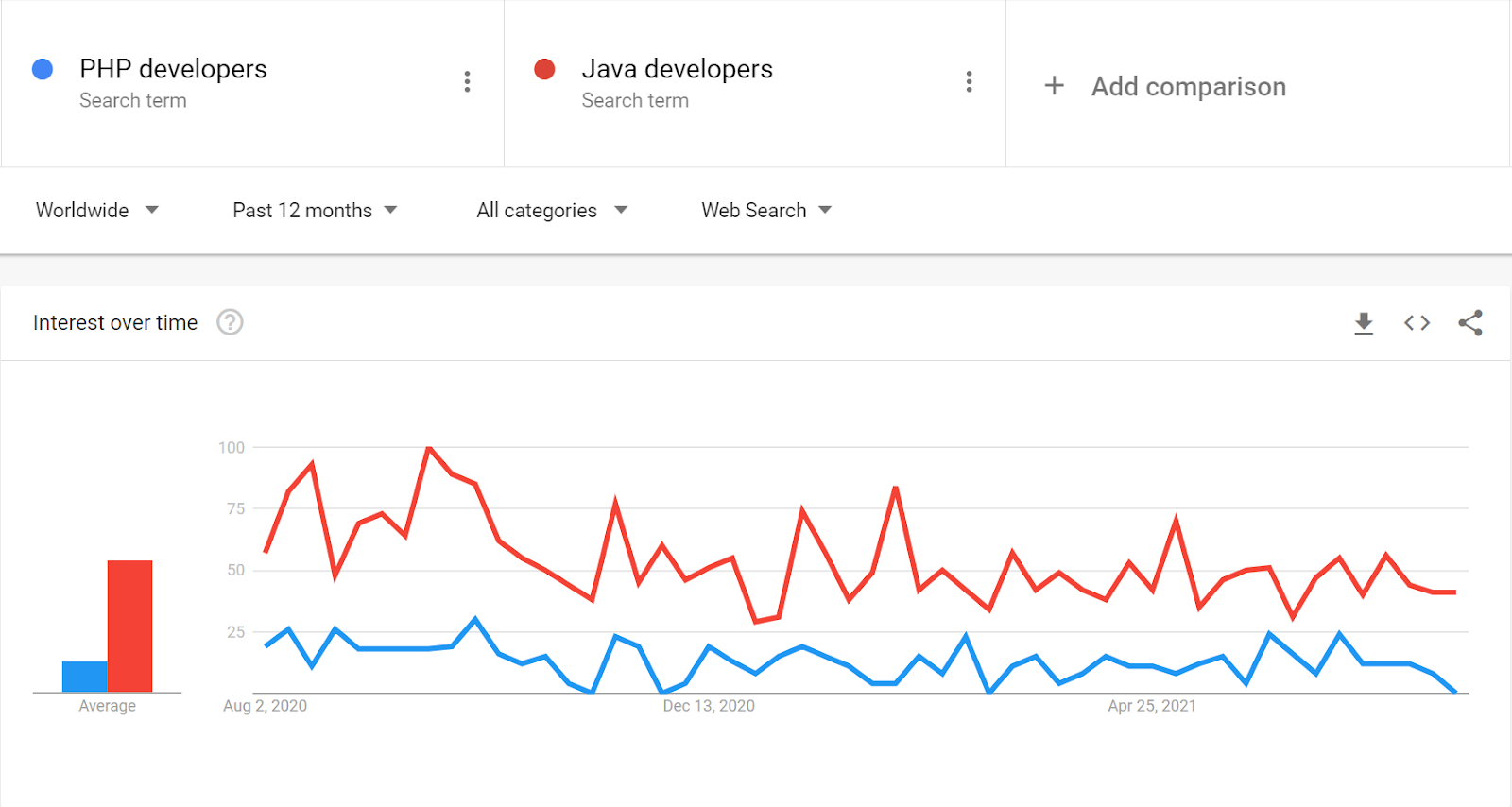
Python vs Java
With Python vs. Java comparison, emotions are running high. Both are extremely popular and robust languages, with strong cross-platform support, vast communities of dedicated specialists, and a rich selection of tools to make coding more efficient.
First released in 1991, Python has emphasized code readability and developer’s comfort from day one. It is an interpreted and dynamically typed language, so type checking is deferred until runtime. Python wasn’t designed to solve a particular problem; it is universal and used nearly everywhere, from websites and web apps to software testing applications to data analytics engines. An extensive set of Python AI and ML utilities make it the top choice for AI and ML programming.
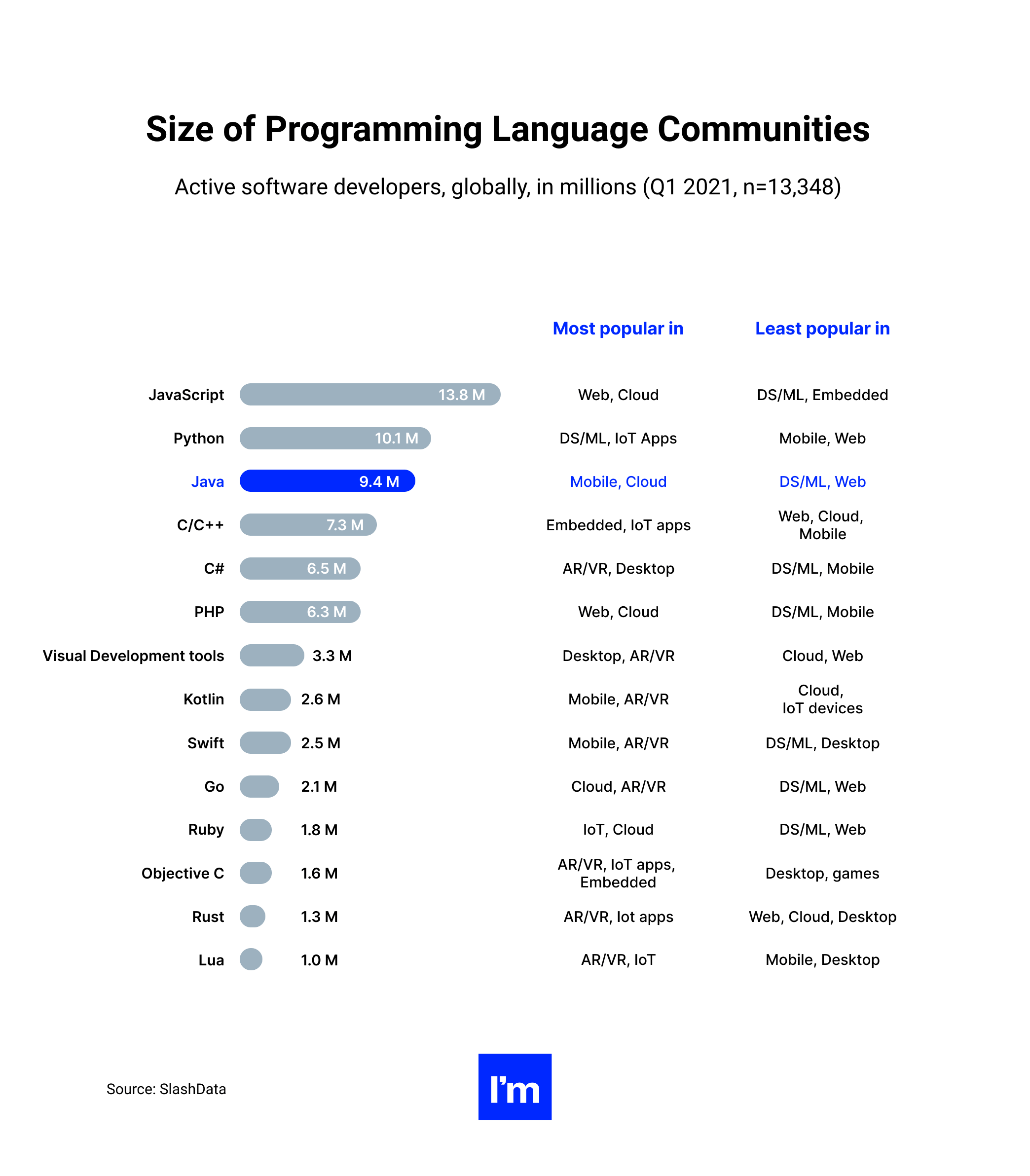
Popularity
The demand for Java developers used to be greater than that for Python engineers in the last year. Lately, it has reached the same level for both languages. And it has been a recurring trend for several years. So depending on the date, you might see Python towering above Java or Java eclipsing Python in demand.
Winner: the two go neck and neck
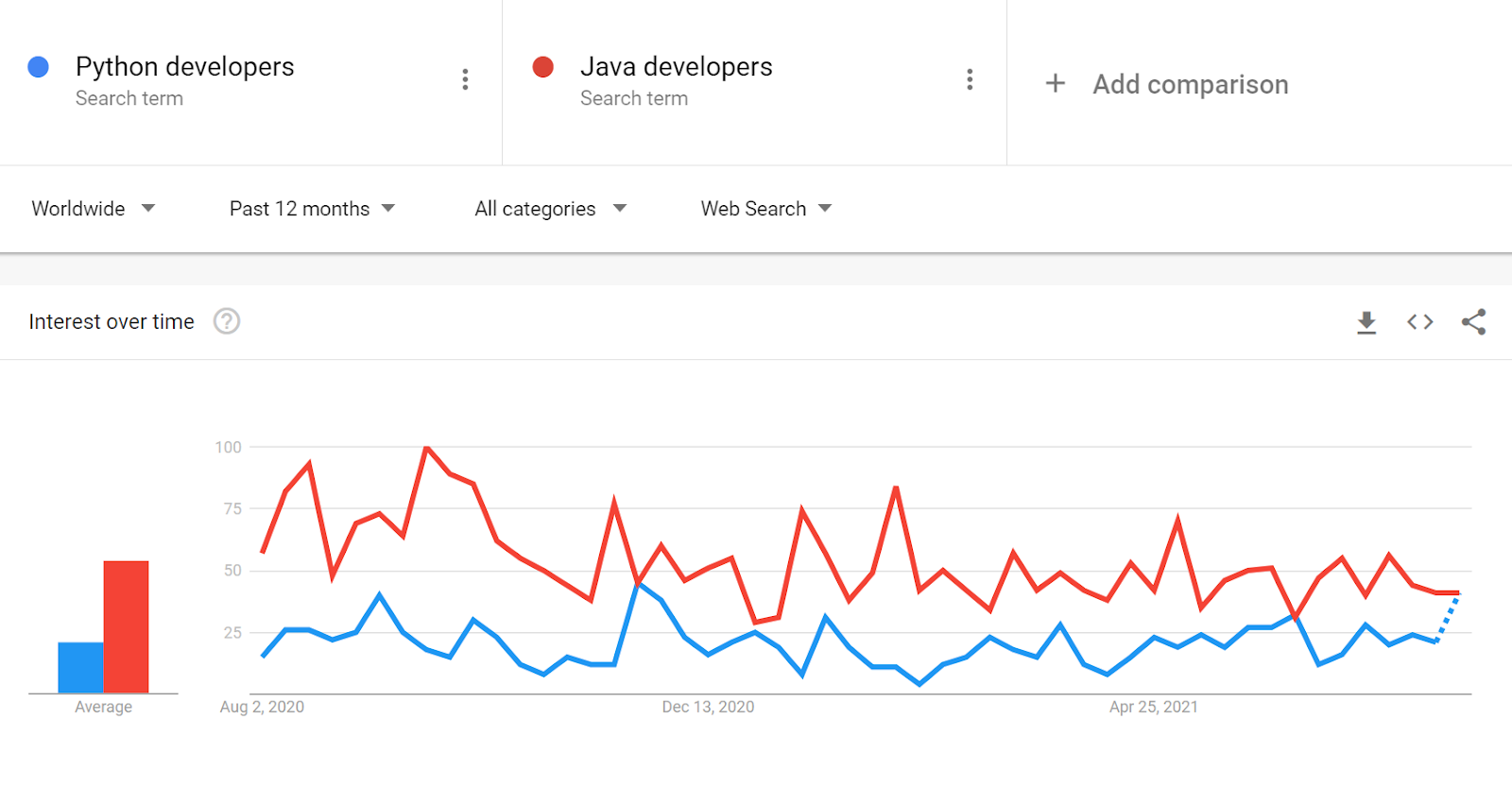
Ruby vs Java
In the words of its creators, “Ruby is a language of careful balance.” That’s because when Yukihiro Matsumoto was developing it, he combined bits and pieces of his favorite technologies to create a language that’s ‘simple on the outside, and sophisticated inside’.
The first release of Ruby happened in 1995. Since then, the language has gathered a strong community of supporters who appreciate that Ruby aims to make programming an enjoyable and fulfilling experience (somewhat like Python). Companies like Fiverr, Github, Bloomberg, Kickstarter, Airbnb, Zendesk, and hundreds of others use Ruby primarily to build elegant, high-performing websites and web apps.
Speed of development
When the focus is on developers’ convenience, as in Ruby, this has to mean faster coding. The trimmed, efficient code and easy-to-read syntax considerably reduce development time. In addition, Ruby generates way less boilerplate code than Java, and it offers numerous frameworks and libraries that support time efficiency. The most popular of these tools, Ruby on Rails, follows established programming standards, which further minimizes output code and speeds development.
Winner: Ruby, no question
Performance
On the other hand, program execution speed is not Ruby’s best asset. The boot times of Ruby frameworks are notoriously long. Code optimizations are possible, but they require extra work. Besides, making a wrong judgment while coding might add a significant project overhead and slow down the entire app. For that reason, Ruby is hardly applicable for projects requiring memory-intensive tasks.
Winner: Java beats Ruby to the ground
Versatility
The most common implementation of Ruby, Ruby on Rails, is built to create web apps. Although companies sometimes use the language for prototyping, building MVPs, and creating data analysis programs, Java still seems slightly more versatile, as it can also support enterprise platforms and mobile apps through Kotlin.
Winner: Java, by a nose
Cost of development
Ruby developers are more pricey, earning $130K/year in the US, with top earners getting as much as $160K/year. That is more than what Java experts usually make. And when we look at the global rankings, the discrepancy becomes even more prominent. That’s probably down to the fact that Ruby's talent pool is significantly smaller than Java’s.
Winner: Java takes the crown
Talent pool
Speaking of which… Gathering different data, it seems that about 1 million software developers use Ruby at work, while one-third of that number are professional Ruby programmers. This corresponds to less than 7% of the global developers’ community, which is nothing compared to Java’s community size. Interestingly, Japan is the country where Ruby enjoys the greater following.
Winner: Java again
Popularity
Another category where Ruby yields to Java is the popularity among companies. Only 9% of organizations look for Ruby-related skills, compared to 59% seeking Java expertise. That is not to say that Ruby is unpopular. On the contrary, think of any major SaaS company, and they are likely to have Ruby in their stack. However, given the technology’s small community size, some organizations may choose to go with other languages, as hiring the right talent for them is much easier.
Winner: Java, by a great deal
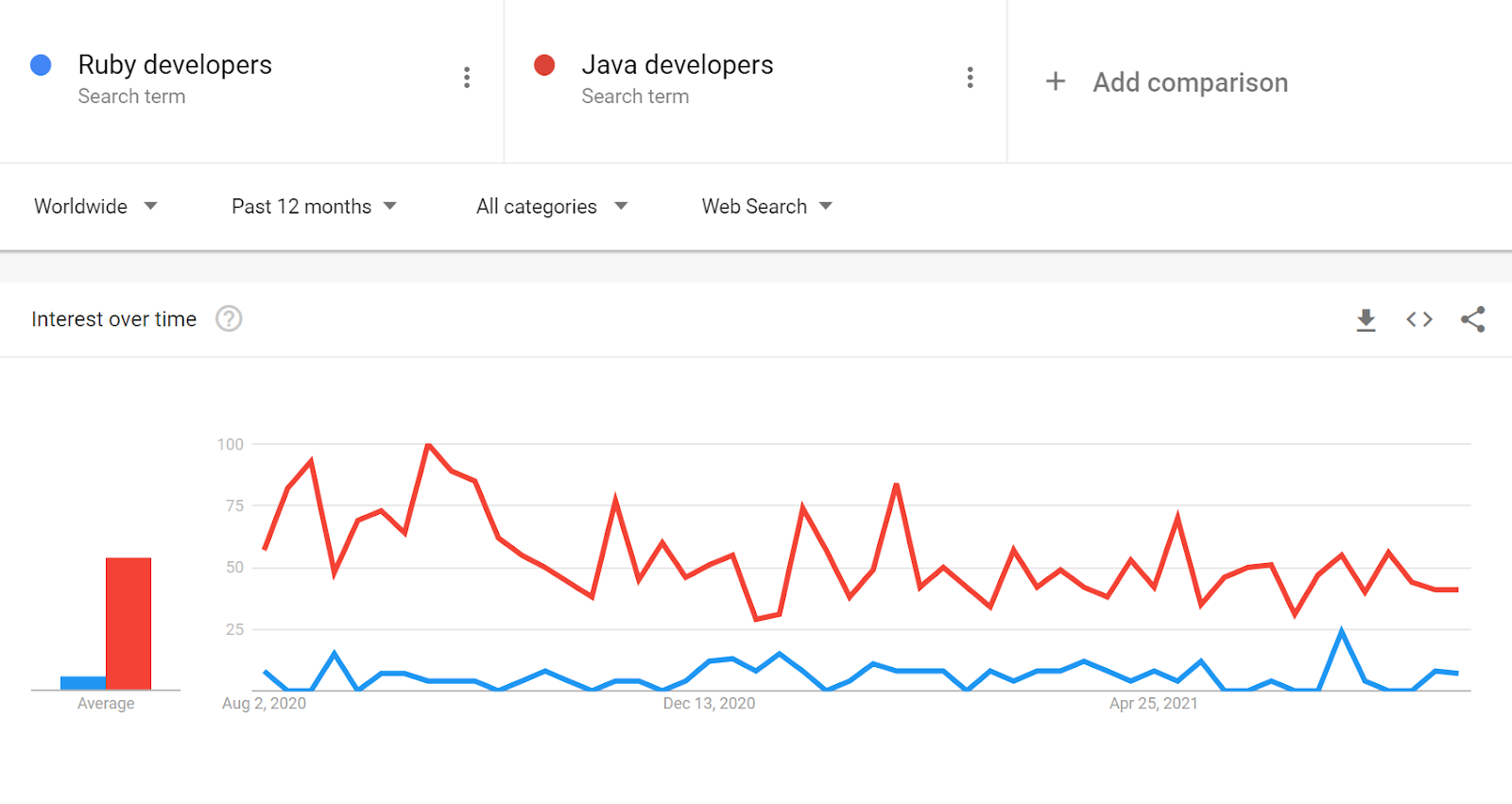
Rust vs Java
Another interesting Java competitor is Rust, a multi-paradigm, high-level language designed for performance and security. Its main selling point is memory safety - the inbuilt Rust features protect programs from memory leaks and runtime errors. Other advantages include programming efficiency, code simplicity, and a growing number of libraries to support emerging use cases.
Rust emerged publicly in 2010, under Mozilla’s auspices. By now, it has become the most loved programming language by the developers’ community. The technology has many applications, from writing web apps, working with servers, and building utilities to creating embedded apps. Dropbox, Coursera, Figma, Amazon, and Discord all use Rust in their projects. Significantly, Microsoft has been moving some of its programs from C++ to Rust, which shows that the language hasn’t said its final word yet.
Speed of development
Rust is optimized for the user’s experience, focusing on usability and tooling to allow developers to code faster. In addition, the comprehensive documentation and various integrated package management and build tools help automate and speed up work in Rust. Maybe that’s why not only software developers love the language. In recent years, new projects have been emerging where non-programmers dabble with Rust to build data science software.
Winner: Rust
Performance
As confirmed by various tests and benchmarks, Rust code runs orders of magnitude faster than Java while consuming less memory for processing. That’s due to several factors, one of them being that Rust compiles to native code ahead of time, with no further optimizations at runtime. Besides, unlike Java, Rust doesn’t use a garbage collector by default. While it’s a useful feature that optimizes developers’ experience, it can considerably slow down the executed programs.
Winner: Rust inflicts a humiliating defeat on Java
Versatility
There’s no shortage of cases and applications that Rust can support. You can use it to build file systems, OSs, websites and internal tools, browser components, and even games. But it’s hard to assess it against Java’s versatility. So, to be on the safe side, let’s call it a tie.
Winner: inconclusive
Cost of development
The salaries of candidates with Rust skills range from $120K/year up to $200K/year, which is above Java average costs. That said, programming with Rust will often require less time than coding with Java. This might significantly impact the total project cost, especially when you hire programmers per hour.
Also, for cloud-based software development, if you pay cloud suppliers for resource/memory consumption, you might be better off going with Rust in some cases.
Winner: possibly Rust
Talent pool
A mind-blowing 87% of global developers adore Rust, which is almost twice as many as in the case of Java. But when we look at the number of programmers who use Rust in their projects, we’ll get a modest 7% of developers, five times fewer than Java specialists.
Winner: Java
Popularity
For some reason, Rust remains a niche technology, despite all its advantages and developers’ enthusiasm. Only 10% of organizations consider it as in-demand technology. Meanwhile, 6 out of 10 companies seek Java support. Additionally, if we dig deep into the main Rust applications, we’ll learn that a whopping 67% of Rust developers use the language… as a hobby. As little as 16% of them take advantage of it in commercial projects.
Google Trends results confirm narrow interest in Rust developers. The trend for Rust developers has remained low and stable over the last 12 months, which attests to its low popularity among business users.
Winner: Java, big time
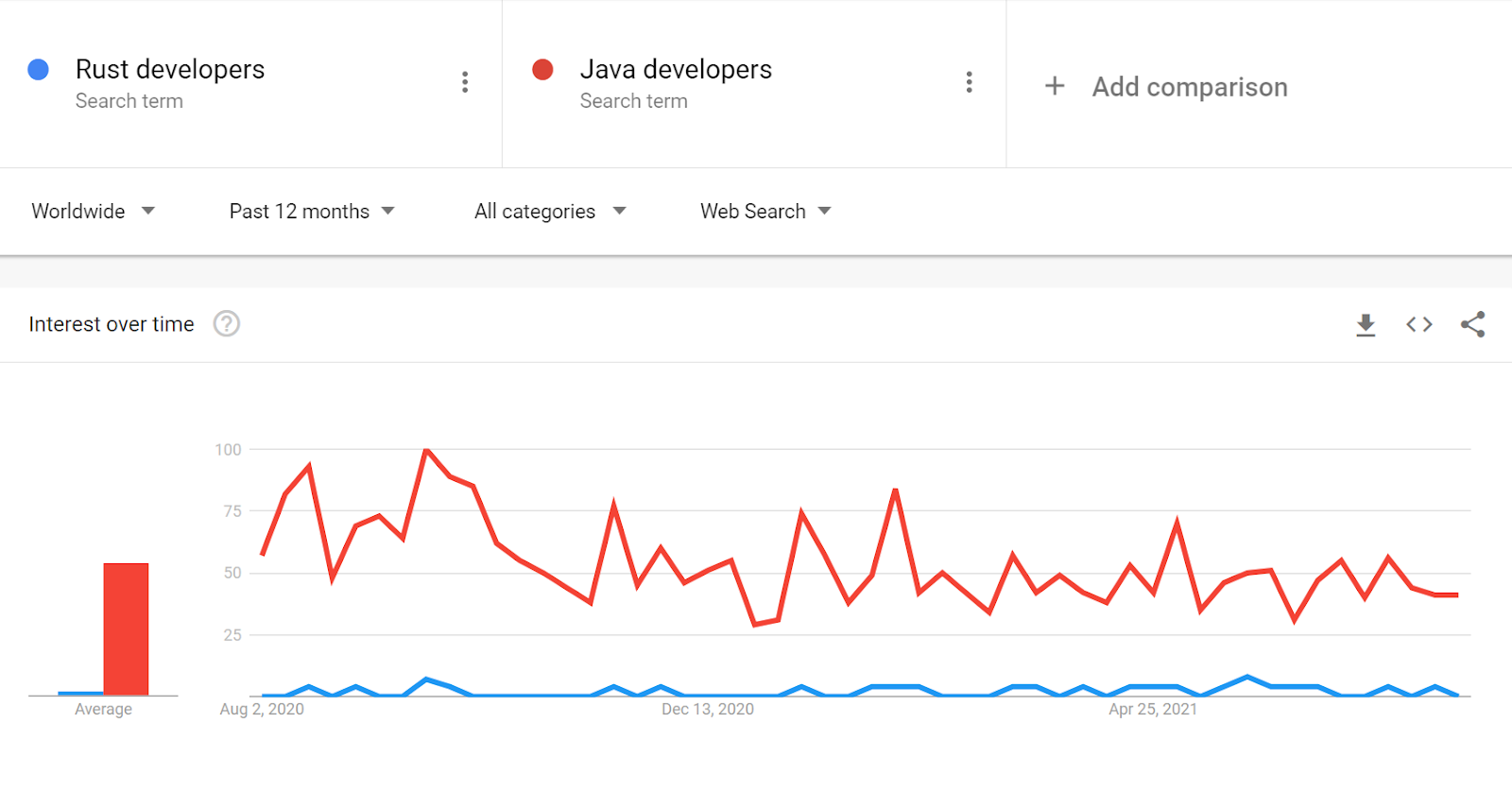
Scala vs Java
Next up, Scala - a serious Java contender. First released in 2004, it was designed to be concise and solve many issues encountered by Java developers while offering robust performance and speed.
As Scala comes with its own virtual machine, its source code compiles into Java bytecode to run efficiently on the JVM. In addition, the language supports various programming paradigms and features, including concurrency, type interference, and pattern matching. Their powers combined allow writing compact and highly efficient code.
Speed of development
Created to address Java’s inefficiencies, Scala may be significantly faster than Java in scenarios requiring few optimizations. Where Java tends to be verbose, Scala allows achieving the same results using fewer code lines. It also provides macros and functions that simplify coding for programmers and result in faster code delivery. To add to that, Scala can be run in the browser, making a project launch even more hassle-free.
Winner: Scala takes the win
Performance
Both Scala and Java require compilation before running on the JVM. However, multiple sources have found Scala to be performing faster than its contender, sometimes to a significant degree. This results from various optimizations applied to address Java’s inadequacies. One such example may be a different concurrency model, which simplifies and accelerates task execution by a program.
On the other hand, the code compilation in Scala can sometimes be slow. Furthermore, Scala is very future-oriented and provides strong support for scalability, but it is not backward-compatible, which may create issues with development. Also, Java tends to be more reliable when it comes to bug detection and elimination.
Winner: drawn game
Versatility
Scala boasts a wide range of applications, just as Java does. The multi-purpose language can power data collection and processing apps, websites and web applications, microservices-based architectures, as well as corporate-grade, complex software platforms. And yes, it is also possible to use Scala in mobile development. Sounds familiar? Exactly. As far as the range of applications is concerned, Java and Scala go even-steven.
Winner: both
Cost of development
If you want to run a Scala-based project, prepare to shell out $150K/year when hiring a US-based developer. That’s $30K/year more than what you’d invest in Java skills. Scala is the top-paying software development skill in the United States and one of the most expensive globally. Elite salary matches elite skill set, as only three in 100 developers program with Scala.
Winner: Java, considerably
Talent pool
Like other relatively young programming languages, Scala has a long way to go before it reaches the size of Java’s community (if ever). Roughly 3.6% of the world’s developer population use the language, translating to less than one million users globally. Hardly impressive.
Winner: Java, without blinking an eye
Popularity
Despite numerous prominent organizations using Scala in their projects (LinkedIn, FourSquare, Netflix, Sony, Twitter, The Guardian - to name just a few), the language ranks low in popularity. Only about 11% of companies look for it when recruiting developers.
Scala occupies 17th place on the PYPL popularity index (Java’s second). Why is that the case? That we don’t know. But even though Scala gets lots of love from its community, it’s significantly less influential in the business world than Java.
Winner: Java, substantially
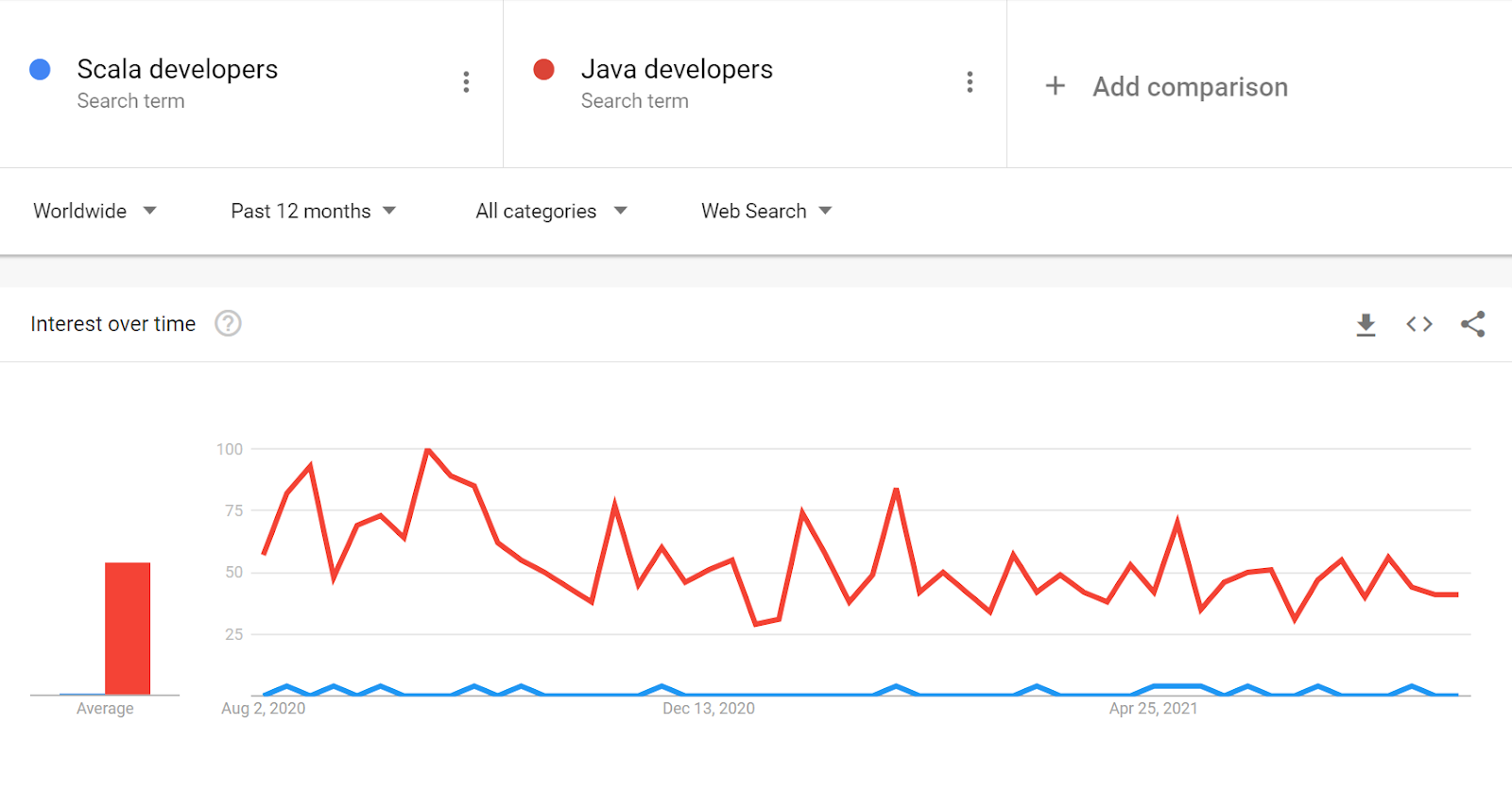
Swift vs Java
Apple’s baby, Swift, is the youngest language on our list. Like Scala, it was also meant to address common concerns of another programming technology, this time Objective-C.
The language is licensed as open-source, and it is regularly updated and upgraded by Apple. Built for a range of iOS devices, it can now support software that can run on Windows. However, Swift still does not make it possible to write mobile apps for Android. At least not yet.
Speed of development
“Make programming simple things easy, and difficult things possible” that’s the motto behind the Swift creation. As a language for the modern era, Swift strives for developer’s ease and convenience. And it seems like it’s quite successful in this venture; more than 63.5% of developers love their experience with Swift.
The language’s syntax is clean, expressive, and quite easy to master, especially for programmers with knowledge of C and C++. Its portable code can run on multiple devices, including those powered by Windows or Linux. Given these features, the language is much faster for coding than Java.
Winner: Swift, beyond question
Performance
Swift creators tout the language as ‘incredibly fast,’ but it’s not necessarily the case. Benchmark tests show inconclusive results. While many programs run faster in Swift, others get a major lag when compared to Java. Other tests have shown that Swift trails behind languages like Go or Rust in performance. Therefore, we’d say Swift and Java go neck and neck in this factor.
Winner: 1:1
Versatility
Swift was made to support Apple products, and it remains in this limited use to this date. Nevertheless, Apple pursues making the language multi-purpose to support systems programming, mobile and desktop apps, and cloud services on different OSs. But until it reaches that goal, Java runs circles around Swift in versatility.
Winner: Java, by far
Cost of development
Swift is hosted on GitHub, up for grabs by anyone. The code can be ported across numerous platforms, devices, and use cases without any extra charges. And when it comes to hiring costs, Swift developers tend to earn slightly more than Java’s. As a result, we proclaim it a draw.
Winner: none
Talent pool
Swift users and fans have no chances of winning against Java’s community. A tiny 5.1% of software developers use the language in their projects. There’s not much to add to that. Hiring a skilled Swift professional is a tough row to hoe.
Winner: Java all along
Popularity
As for a niche language, Swift is doing quite well in popularity among organizations. The PYPL index ranks it as number 10 of all programming languages, higher than Rust, Ruby, and Go. However, the index also indicates a downward trend for that tech.
Since Swift overtook Objective-C for iOS development, Apple has been the chief user. But other well-known businesses like IBM, Lyft, Slack, and Uber also develop their iOS apps in Swift. Still, the popular demand for the language remains rather low, at 14%, and in the last 12 months, it has remained stable. In comparison, Java trends come and go, but the language consistently ranks in the top league.
Winner: Java
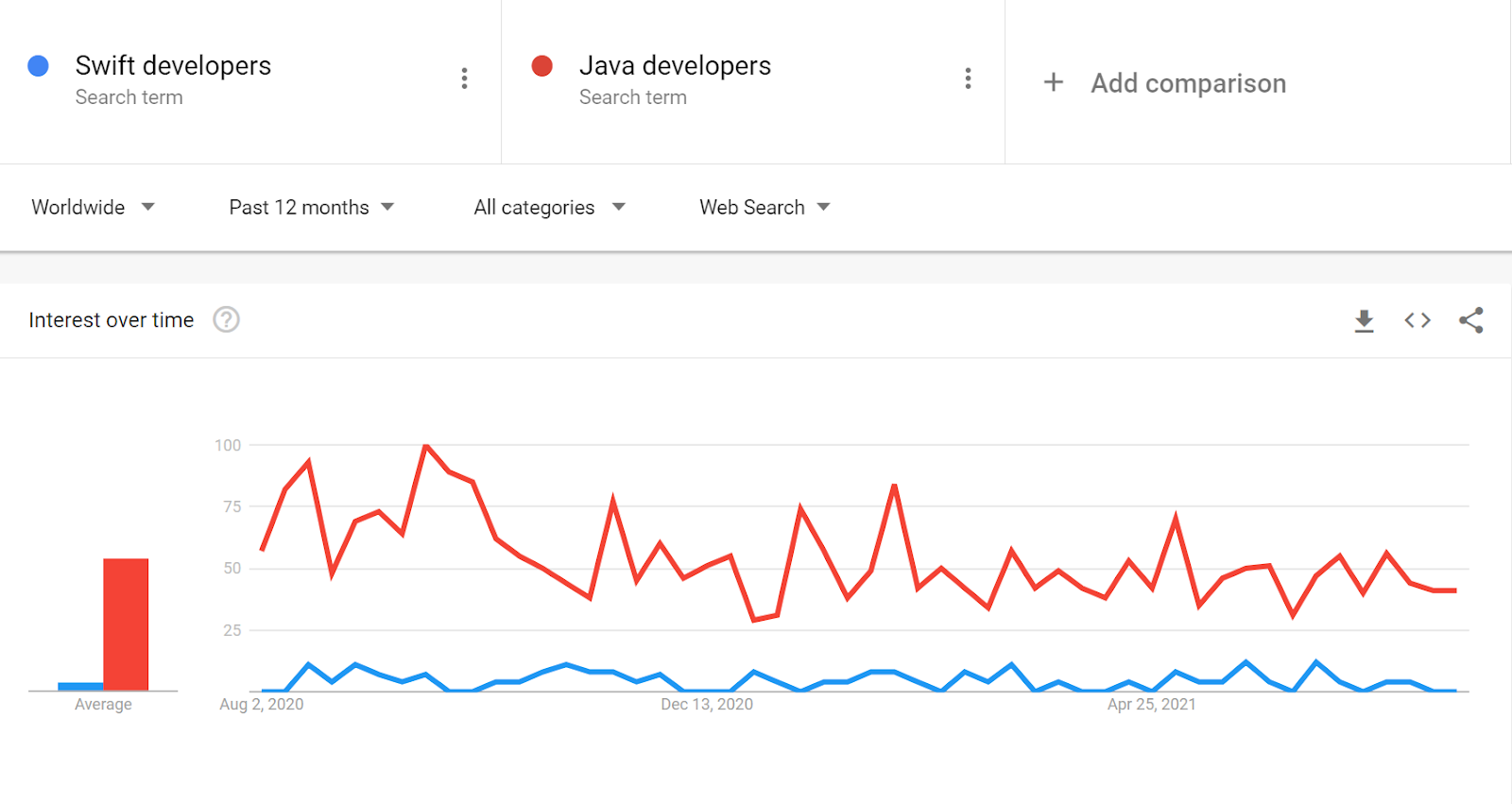
06 Hiring Java developers and Java product teams
A study by Jetbrains estimates that there are nearly 7 million Java developers currently in the world. Other analyses (including Developer Economics) suggest even a higher count, claiming between 8-10 million programmers use Java at work.
With so many specialists to choose from, how can you know where to find the best people to turn your idea into a reliable, flexible, and scalable Java-based app? We’ll tackle this issue head-on now.
The responsibilities of Java developer
Before we investigate the Java labor market, rates, and engagement models, let’s check the skills essential for any Java programmer to be above par.
Junior Java developers
The Java developer’s seniority and the project requirements determine their role in the team and core responsibilities. For example, juniors must certainly know the language, but they aren’t usually expected to work independently. Most of them require some guidance (not hand-holding!) and oversight, as their project experience is generally modest.
Entry-level Java specialists may not be familiar with some frameworks and libraries and seek the support of senior colleagues when implementing more complex scenarios and functions. The same applies to business domain knowledge - juniors typically need a fair share of training and onboarding before they can understand the impact of their code on business workflows and outcomes.
Because of these limitations, investing in a senior-level developer in small and startup projects is usually more sensible than hiring several juniors. Naturally, juniors charge lower rates than their more experienced peers but lack the essential experience to drive a project unassisted. They can effectively work to specifications, but someone has to provide them with clear guidance and assessment.
Senior Java developers
Seasoned Senior Java developers have several years of coding experience. They work independently, finding solutions to complex business and programming problems without supervision and on limited inputs.
The huge advantage of working with seniors is their understanding of business requirements, resulting in well-written, robust code and software that optimally resolves specific business issues for the end-users. Seniors collect user requirements and translate them into code, while juniors usually need to be explicitly told what task to implement.
Senior Java experts should have a good grasp of various Java tools and frameworks. The broad range of utilities they know and use allows them to write code faster and easier than juniors. Additionally, experienced professionals can mentor and lead junior-level programmers, taking the burden of onboarding new hires off your shoulders. They also take full ownership of their work and apply fixes when their code isn’t up to snuff. Of course, the more experienced and efficient a Java developer, the higher the rate.
Any project should have at least one senior developer on board. However, engaging someone with decades of programming experience to perform basic tasks would be an (expensive) overkill.
Java developer skillset
All Java developers, regardless of experience and seniority, should display the following skills:
- Java skills, including object-oriented programming principles
- Basic design principles like SOLID, DRY, KISS, etc.
- Relational databases like MySQL, PostgreSQL, MariaDB
- Version control systems like Git
- Integrated development environments (IDEs)
- Working with REST & SOAP APIs
- Web-frontend languages and technologies, such as HTML, CSS, JQuery
Additional Java developer skillset - it’s great if a Java developer possesses these skills, but they aren’t obligatory for professional Java software development:
- AI and machine learning tools
- Blockchain and crypto
- Mobile technologies
- Hadoop/Big Data
- Microservices architecture
- DevOps tools (Docker, Kubernetes, Maven)
- Unit testing frameworks
- JavaScript development
- Non-Java UI frameworks (Angular, ReactJS)
- Additional programming languages
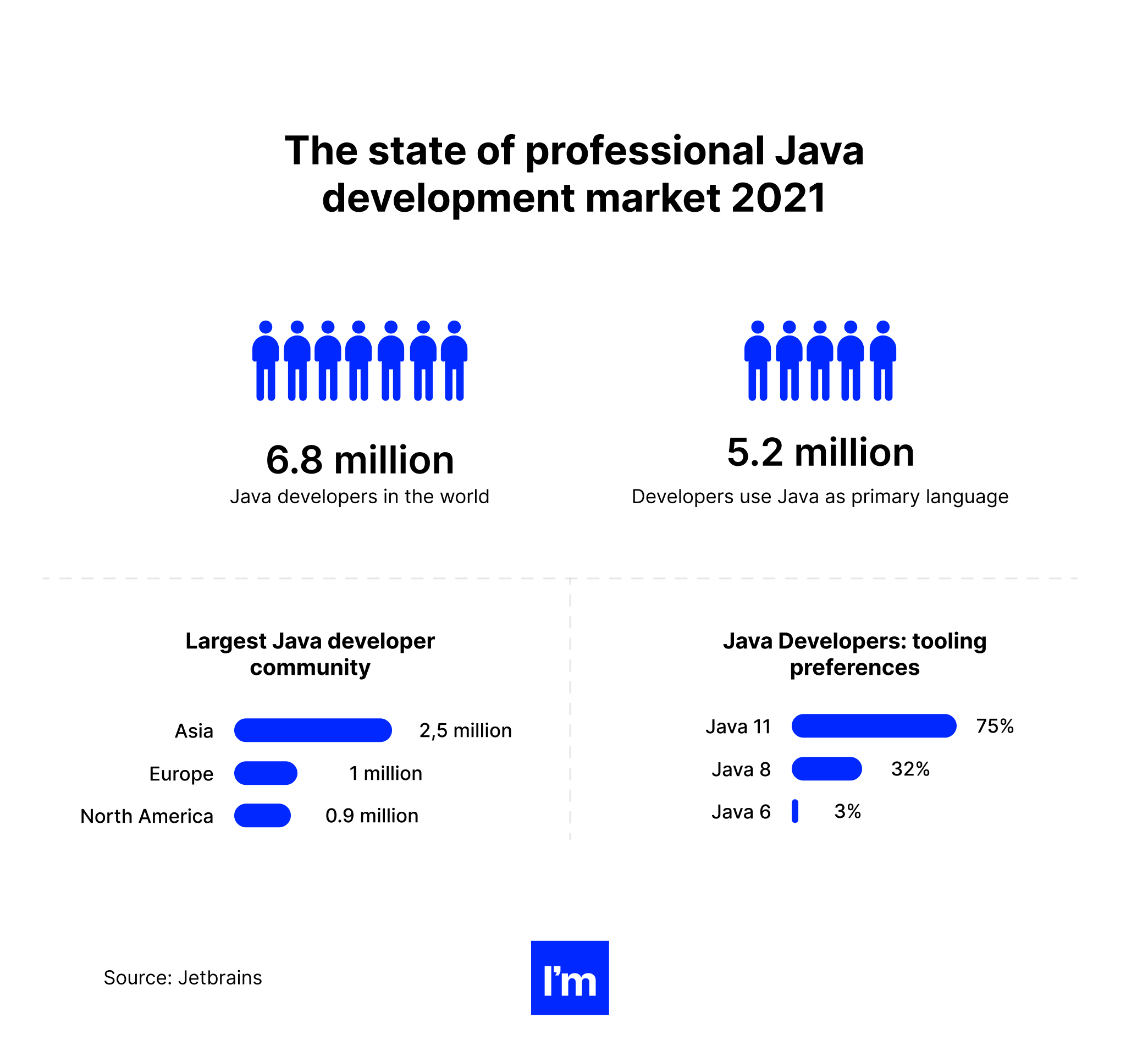
Java developer recruitment: Outsourcing, in-house, or…?
As it’s the case with any programming language, there are several ways to build a Java team:
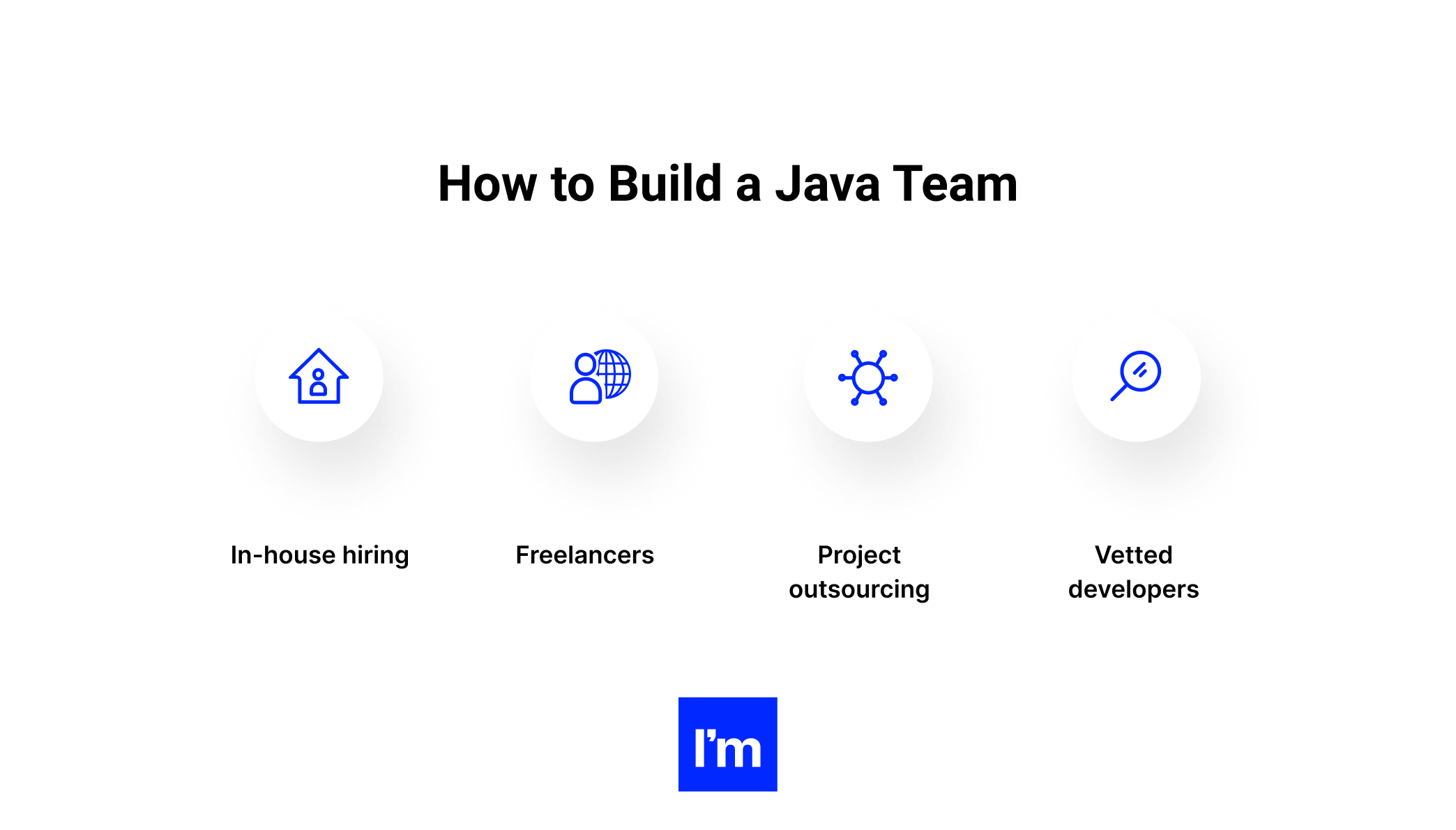
The key considerations when assembling the dream team for your project include:
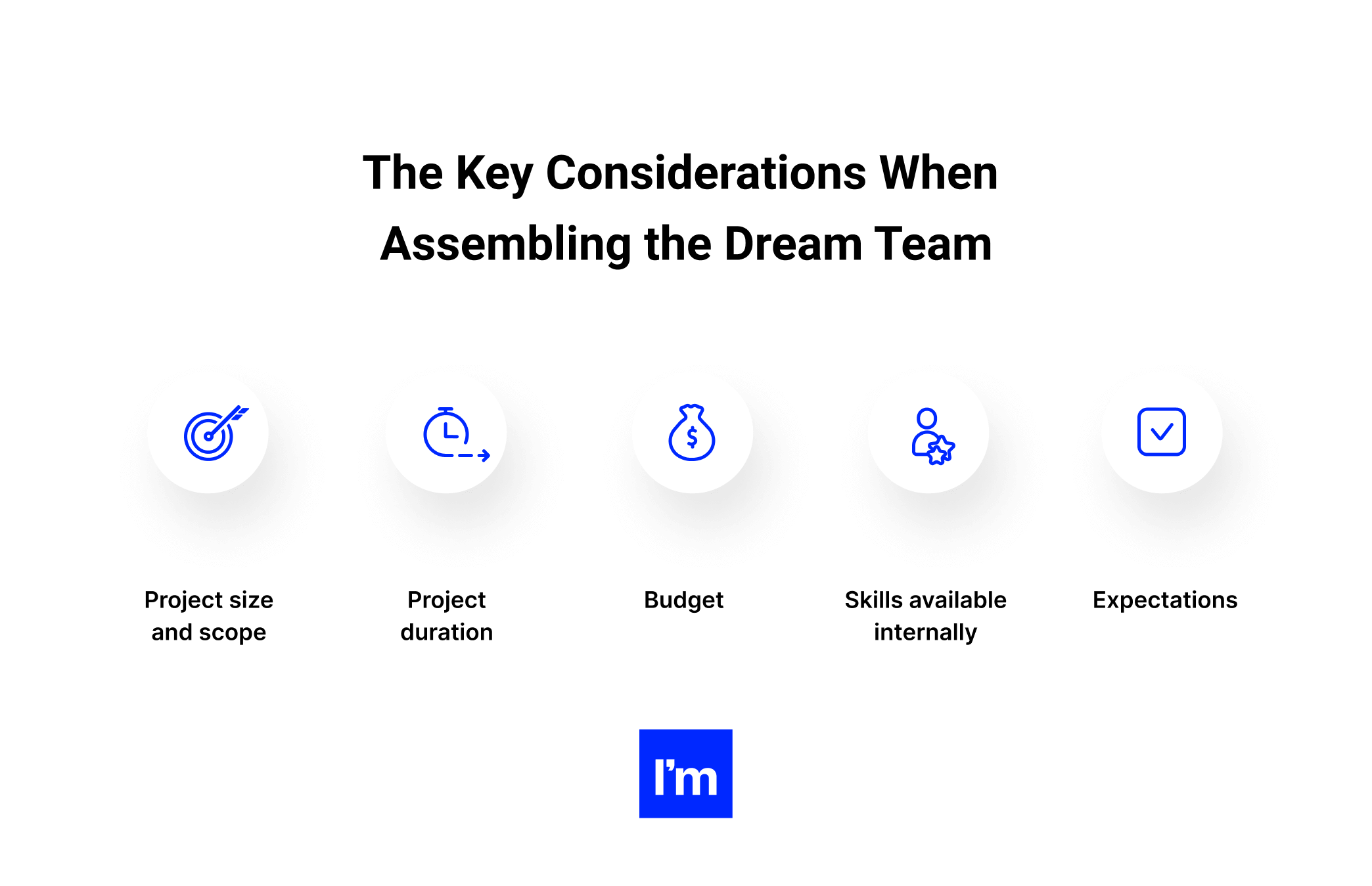
Hiring dedicated Java developers: Pros and cons of different approaches
Of course, all Java developer recruitment options above have their upsides and downsides. Here are some to consider:
In-house hiring
Pros
- Full control over a project
- Seamless collaboration with internals
- Alignment with company goals and culture fit
- Easier to protect and secure access to project and resources
Cons
- The extraordinary cost of hiring, training, and onboarding
- High running costs (HR and payroll, training, management)
- Compensation regardless of the delivered work quality and quantity
- The need to provide all tools and resources
- Slow scaling in both directions
- No vetting and scanning process in place
- From 1-6 months needed to find and hire dedicated Java developers
Best for: Huge companies with full-time internal software development teams delivering different long- and short-term projects.
Not recommended for: Businesses that need to develop a single app or a piece of software for a particular purpose. Startups and SMEs that don’t have the capability and budget to maintain a team of developers full-time.
Freelance Java developers
Pros
- Usually, lower cost than in-house support or agency hires
- Can onboard quickly for ASAP projects (1-5 weeks typically)
- Often flexibility to work extended hours to meet the project deadlines
Cons
- Very little control over work delivery rate and quality
- The risk of dropping out in the middle of the project
- Might not be available full-time or when needed
- No flexibility for up/downsizing
- Difficult to evaluate skill set and experience
- You might need to provide tools to get work completed
- Hard to track the time invested in the project
- Typically hired for short-term commitments
- Issues with maintenance support and project continuity
- No vetting and screening projects in place
- Lack of sense of belonging and ownership for the project’s success
Best for: Small, quick, well-scoped, and organized projects. Companies that already have their in-house team but need more workforce to deliver an app with tight deadlines.
Not recommended for: Large and medium companies with established workflows and processes. Businesses needing an external to launch, manage, and deliver a project end-to-end without much supervision and guidance.
Project outsourcing and body leasing
Pros
- Cost savings
- Predictable price model (typically fixed price)
- The fairly rapid recruitment process
- Usually good quality of work
- End-to-end project handling
Cons
- Lack of targeted expertise in your industry
- Limited talent pool as agencies have a set number of people on the team
- Little scalability or long wait times to add more professionals
- Renouncing responsibility for the results
- Lack of alignment with company standards and vision
Best for: One-off projects with fixed deadlines and rigid scope. In that case, the limited scalability and talent pool shouldn’t affect the delivery.
Not recommended for: Sophisticated, specialized industries. Companies that need consistent and scalable programming support. Organizations that care about personal involvement and team alignment of all employees and partners.
Vetted developers agency
Pros
- Screening and selection process ensures top quality talent
- Flexibility to hire dedicated Java developer teams of any size
- High scalability, size up and down on-demand
- Minimum ramp-up time (1-21 days)
- Cost optimization through lower rates and flexible pricing models
- Access to developers experienced in your vertical
- Following market trends and applying last-day innovations
- Ability to fill in all roles (development, QA, R&D, management, support)
- Full ownership rights to the source code
Cons
- Remote location and possible time zone differences
- Need some time to align with your business goals
- May (but doesn’t have to) involve developers working on multiple projects at once
Best for: Agile, fast-paced projects that thrive on experience and familiarity with the business domain. Development tasks outside of a company’s field of expertise. Scalable projects with short ramp-up times.
Not recommended for: Basic and repetitive coding tasks that could be easily automated. Huge, large-scale projects that require a full-time commitment from hundreds of people.
The cost of Java development
Given the massive differences across projects, software services suppliers, and customer verticals, it’s impossible to put a common price tag on the delivery of a Java application. Each project has to be evaluated on its own.
However, we can quantify certain factors that impact the final cost of professional Java development, such as labor cost, project delivery time, and expertise levels. And we’ve done just that.
Hiring Java experts: what goes into the final cost?
Let’s consider in-house hiring first. Here, it’s quite easy to figure out the cost of development: you just have to look at what a Java specialist makes, and that’s that.
But remember that to get your final calculation, you also need to factor in the software and hardware costs. Plus their maintenance. And yes, a markup on employee salaries like payroll taxes and benefits, recruiters, equipment, taxes…
Altogether, these ancillary expenses can increase each person’s recruitment costs by 20-35%, on average. In contrast, most of these extra costs won't affect you when you hire an external, whether a freelancer or a vetted expert through an agency.
Java developers’ salaries across countries
The full cost of Java software development services largely depends on where you hire dedicated Java developers:
- Countries with the lowest software developers’ earnings globally include Malaysia, the Philippines, India, Pakistan, and China.
- The highest-paying countries for software engineers include the USA, Switzerland, Israel, Norway, Denmark, Australia, Germany, Sweden, and the UK.
- In India, a Java developer makes $6K/year, on average. However, the pay scale may swing both ways, from $2.7K/year up to $15K/year, depending on the level of seniority and skills.
- Malaysian Java specialists get $20.5K/year, on average. In the Philippines, Java Developers typically earn about $11K/year, with salaries ranging from $5K/year (the lowest) to $19.5K/year (the highest).
- When we go slightly West, we’ll learn that the median pay for Java development skills in Ukraine is around $26.6K/year. Java specialists in Kyiv tend to make about $31K/year, while experts in other cities, including Kharkiv, can make one-third of that. For seniors, the pay scale significantly increases, reaching up to $48K/year.
- The median salary of Polish Java developers with mid-level experience stands at ca. $31K/year. An entry-level Java specialist in Poland can make as little as $17.2K/year, while top seniors (5-9 years of experience) typically earn around $46.3K/year.
- Now let’s compare that to the USA. According to Stack Overflow, Java developers make $120K/year on average. Realistically, this applies to senior specialists. The exact pay ranges vary depending on the state. Still, in general, the average salary for a Junior Java Developer cross-country is about $60K/year. In comparison, mid-level specialists can expect to get around $90K/year, according to various sources.
- When we go south, the national average salary for Java Developer in Mexico stands at $17.5K/year. Seniors get significantly higher pay, averaging at $26.4K/year. The pay ranges of Java specialists in countries like Chile, Brazil, and Argentina are so extensive that we couldn’t come up with reliable and conclusive data.
- Jump to Africa, and Nigerian Java experts typically get paid around $11.6K/year, with the lowest-paid roles standing at ca. $5.4K/year and the highest-paying roles reaching $15.5K/year. South African salaries are a whole different story, with rates starting from $10K/year for entry-level Java programmers, going through $20K/year for juniors, and reaching the average of $43.5K/year in the case of senior Java specialists. Thus, the average pay for all Java developers in the country stands at $37.5K/year.
- Looking back at another high-paying country, Germany, we will learn that the national average salary for a Junior Java Developer is about $52K/year. Senior Java experts make significantly more, ca. $62K/year. The rates in France are slightly lower, while those in the Scandinavian countries would typically be higher.
- An average Swiss Java developer earns about $95K/year. In Israel, the average salary for a Java Developer would be $86K/year (both data based on Payscale).
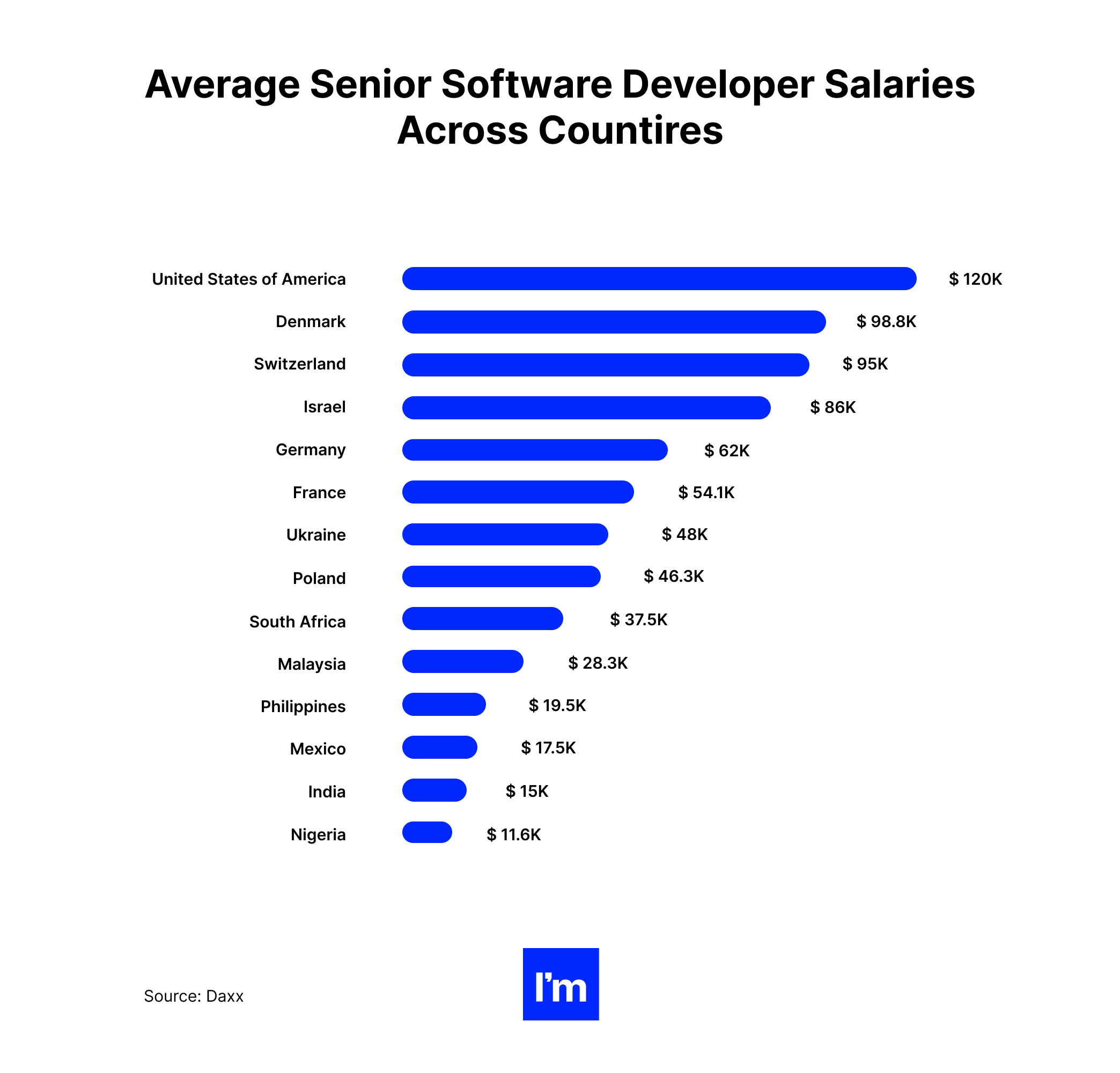
Java developers’ hourly rates across countries
Now, let’s make a per-hour rate comparison depending on the region. Median wages are provided where available; otherwise, an average pay.
Java Developer hourly rates in Malaysia
- Senior Java software engineer hourly rate: $16-$20.5 with an average wage of $19.1
- No specific data for junior Java specialists
Java Developer hourly rates in the Philippines
- Junior Java software engineer hourly rate: $2.8-$3.8 with an average wage of $3.5
- Senior Java software engineer hourly rate: $6.2-$7.6 with an average wage of $7
Java Developer hourly rates in Poland
- Junior Java software engineer hourly rate: $15.5-$23.1 with an average wage of $19.2
- Senior Java software engineer hourly rate: $30.8-$38.5 with an average wage of $34.7
Java Developer hourly rates in Ukraine
- Junior Java software engineer hourly rate: $19-$25 with an average wage of $22
- Senior Java software engineer hourly rate: $39-$60 with an average wage of $49.5
Java Developer hourly rates in France
- Junior Java software engineer hourly rate: $15.38-$23 with an average wage of $17.95
- Senior Java software engineer hourly rate: $21.4-$32 with an average wage of $25.6
Java Developer hourly rates in Switzerland
- Junior Java software engineer hourly rate: $35.9-$59.1 with an average wage of $43.8
- Senior Java software engineer hourly rate: $53.6-$75.5 with an average wage of $64.2
Java Developer hourly rates in the USA
- Junior Java software engineer hourly rate: $30.7-$55 with the median wage of $40
Senior Java software engineer hourly rate: $55.5-$80.6 with the median wage of $65
Where to hire dedicated Java developers to receive the best value for money?
In recent years, the Central and Eastern Europe region has become a hub for finding and recruiting IT and software development talent. One of the key reasons is that the specialists from this area tend to offer the best value for money.
CEE Java developers possess excellent hard and soft skills, speak English fluently, and charge affordable rates. What else makes them highly competitive on the international Java software development services market? And where exactly to look for these experts?
You’ll find all answers to your questions in our extensive guide to outsourcing Java development:
The State of CEE IT Outsourcing and Offshoring Report
07 Inspiring examples of Java uses in the wild
As we’ve already seen in the section What can you do with Java? Java is penetrating almost every industry. And how about checking some real-life Java programming examples?
Out of hundreds of thousands of Java web app examples, we’ve selected a few for you to give you a taste of Java’s immense programming capabilities. Enjoy!
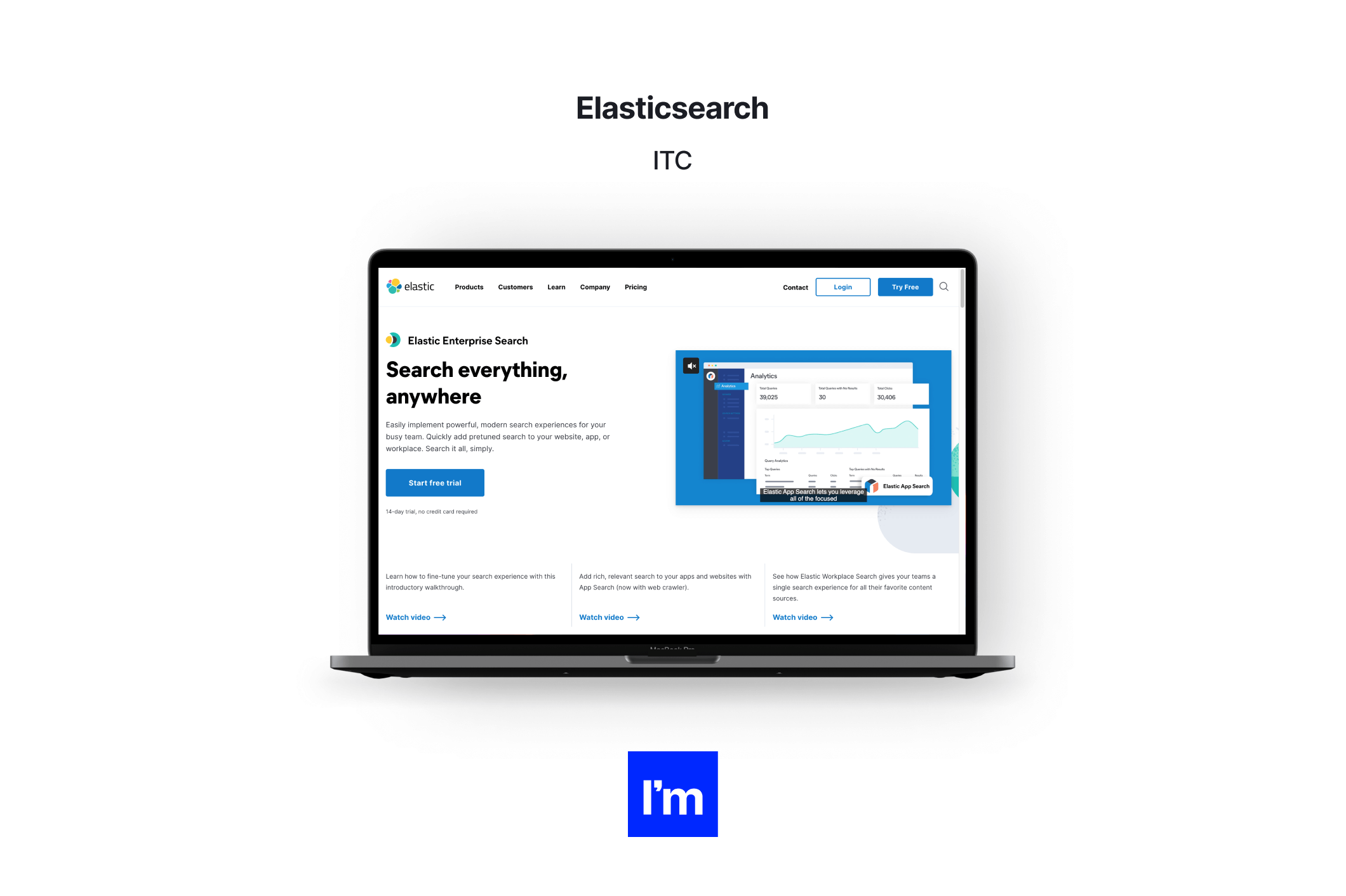
Elasticsearch is a free and open-source full-text search and analytics engine. It allows storing, searching, and analyzing big data sets in near real-time to power apps with complex search features (like e-commerce platforms, CRMs, recommendation engines, spatial and GIS visualization, and many more). The tool is ultra-fast, easy to use, and versatile.
The engine was built on top of Lucene, a library providing powerful indexing features written in Java. The library offers features such as scalable, high-performance indexing and accurate and efficient search algorithms through a simple API. Moreover, because it’s 100% Java-based, it can run on any platform. And as for other benefits of using Java to power the library and - consequently - Elasticsearch, let’s give the floor to Doug Cutting, the creator of Lucene and Hadoop:
"Java offers a good compromise between developer productivity and runtime performance. Developers benefit from a simple, powerful, type-safe language with a wide range of high-quality libraries. Performance is generally good enough."
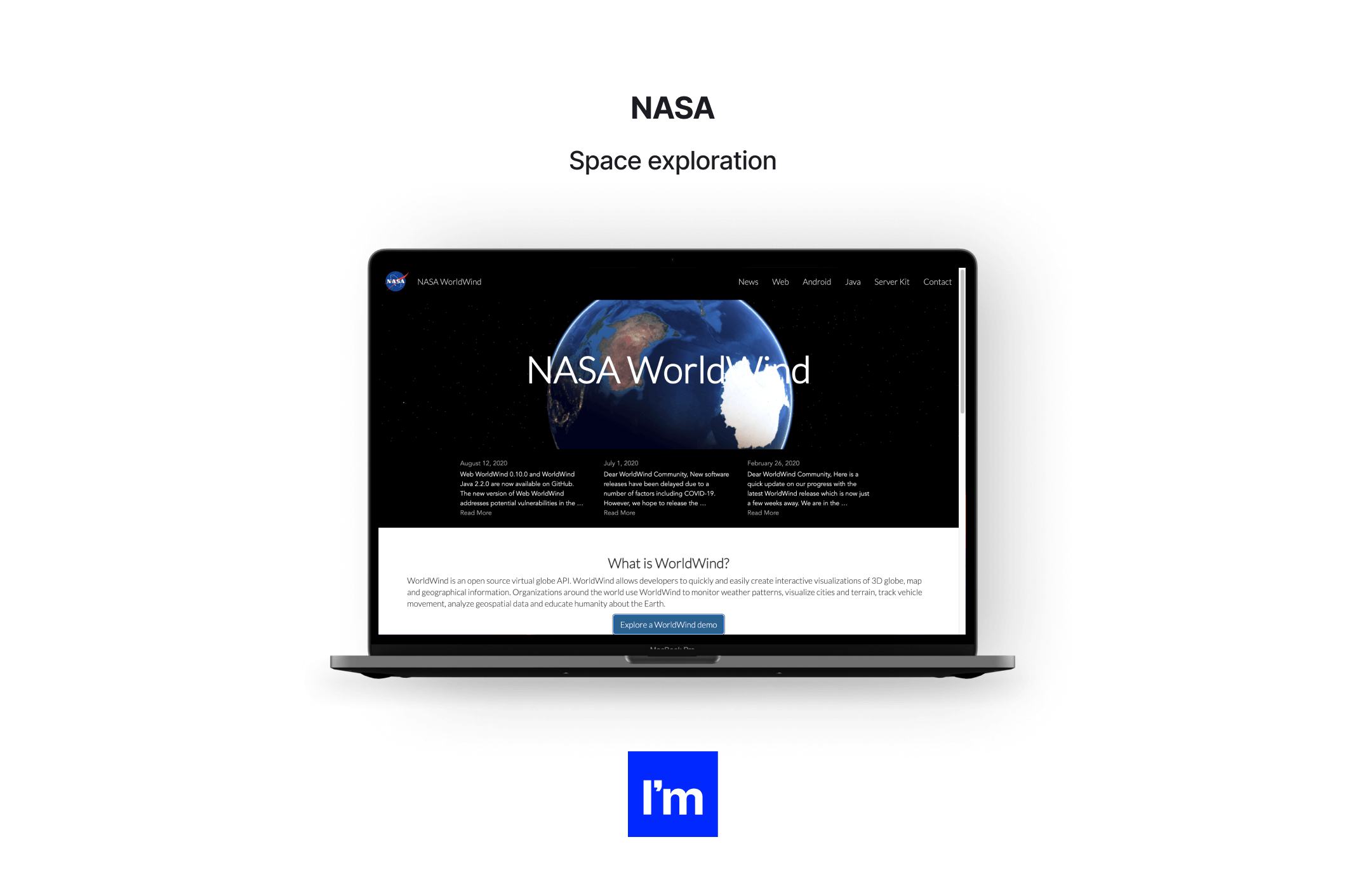
NASA has been using Java extensively in the last 20 years to build its mission support software. Examples of Java-based projects include the deep space climate observatory and a system for estimating collision rates and probabilities.
Another interesting application is World Wind, an SDK that allows developers to create interactive visualizations of the 3D globe, maps, and geodata to monitor weather changes, display terrain, track movement, and more. Using the Java-based World Wind resources, programmers can develop geospatial apps for desktops (including Mac OS X and Linux) and Android devices or build a globe web app.
Some of the reasons why NASA keeps using Java in its projects include cost efficiency, rapid development, and wide availability of tooling supporting AI, data analytics, and data visualization use cases.
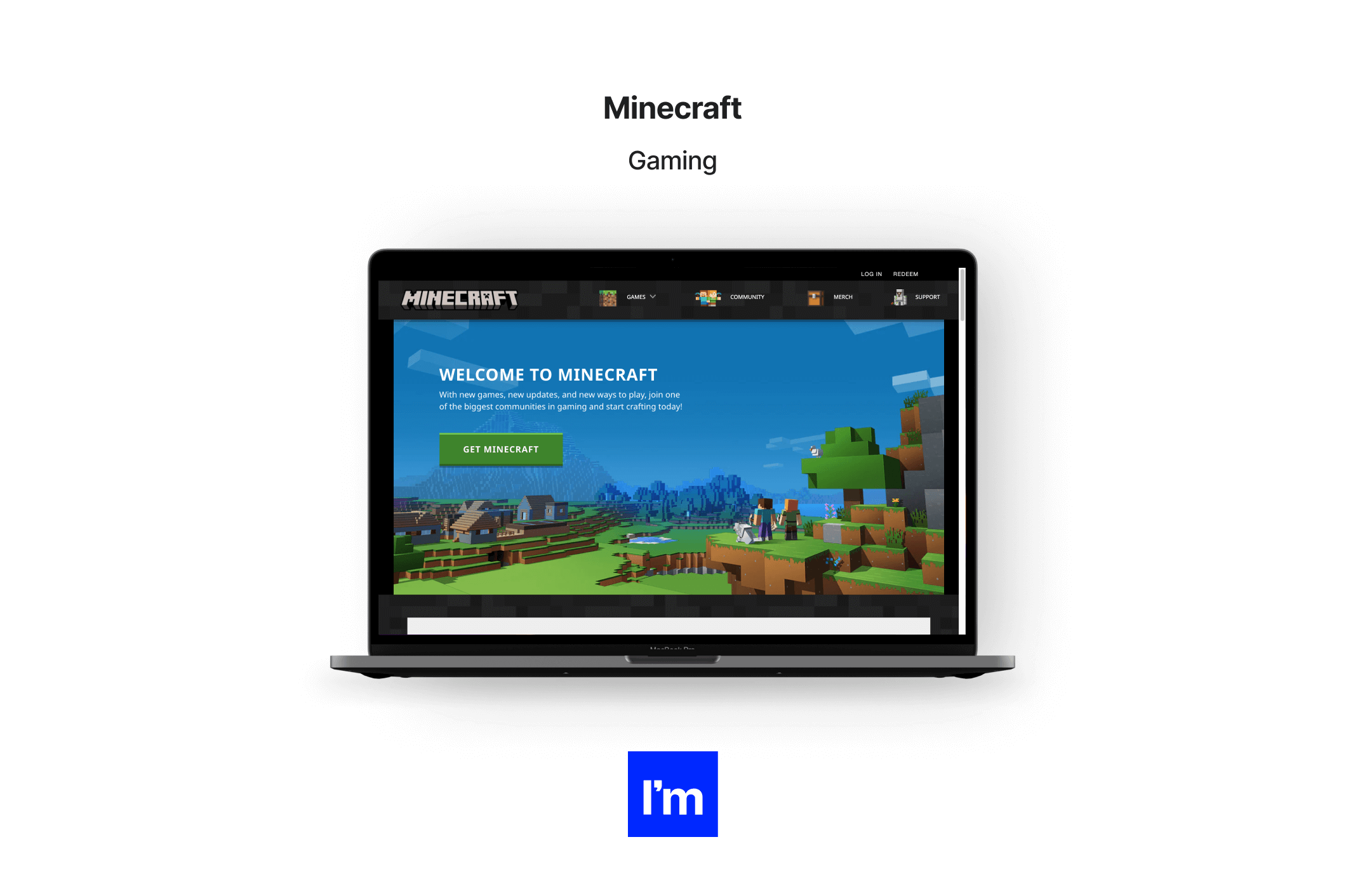
Minecraft, one of the most successful video games ever, is written in Java and uses the language for its game logic, rendering, and networking. Some of the Java libraries that make up the game’s engine have been opened to enable the users to use them in their own game and create custom skins and mods.
One of the key reasons why the game creators went for Java is - again - its portability. Thanks to its core language, Minecraft has enabled cross-platform play between Windows, Linux, and Mac OS since the beginning. What’s interesting, the highly interactive game has made a convincing case for Java’s performance. After all, it is fast enough to power the creation of unlimited virtual worlds, albeit represented by purposefully simple graphics.

Siemens Healthineers is the healthcare leg of Siemens that builds technology solutions supporting lab diagnostics, molecular medicine, diagnostic and therapeutic imaging, and other advanced medical services.
Java is the mainstay of many of the company’s software systems. A PaaS digital health platform teamplay is one of them, enabling medical technology and life sciences organizations to build digital apps with AI-driven capabilities. Healthineers also use Java in projects supporting the integration of hundreds of medical devices and big data processing platforms that store, handle, and analyze massive volumes of medical data.

Java has an edge in banking and finance apps for many reasons. Enhanced security features, platform reliability, and distributed computing capabilities are just a few of them. This is why numerous banks, including HSBC, Goldman Sachs, JP Morgan, and Deutsche Bank, embrace the language in their core tech stack. The language is also widely used by challenger banks and fintech organizations like Revolut.
The financial services provider’s backend is predominantly based on Java 11. It powers essential services and systems, such as risk management, spending patterns analysis, payment processing, and fraud detection modules. In addition, a Java-based Revolut API makes it possible for business users to integrate their third-party accounts and automate some banking operations. For delivering multi-platform mobile apps, the company uses Kotlin, which is 100% interoperable with Java.
And what features have compelled Revolut engineers to choose Java? Here are some tidbits from an interview with one of the company’s Java developers:
- “We primarily use Java everywhere. We default to Java. We're quite happy with that.”
- “I don't want to receive a phone call, and then I have to look at squiggly lines, and I have no idea what happens. If you've read some very esoteric-looking languages, or if you've seen somebody who was trying to do a very smart version of Scala or Haskell code. I find Java much more readable in places.”
- “We use a framework called Java Spark. Why? Because it's extremely simple. Very easy to debug. Very easy to reason about. If something goes wrong, that means you don't have to worry too much because it's all in there.”
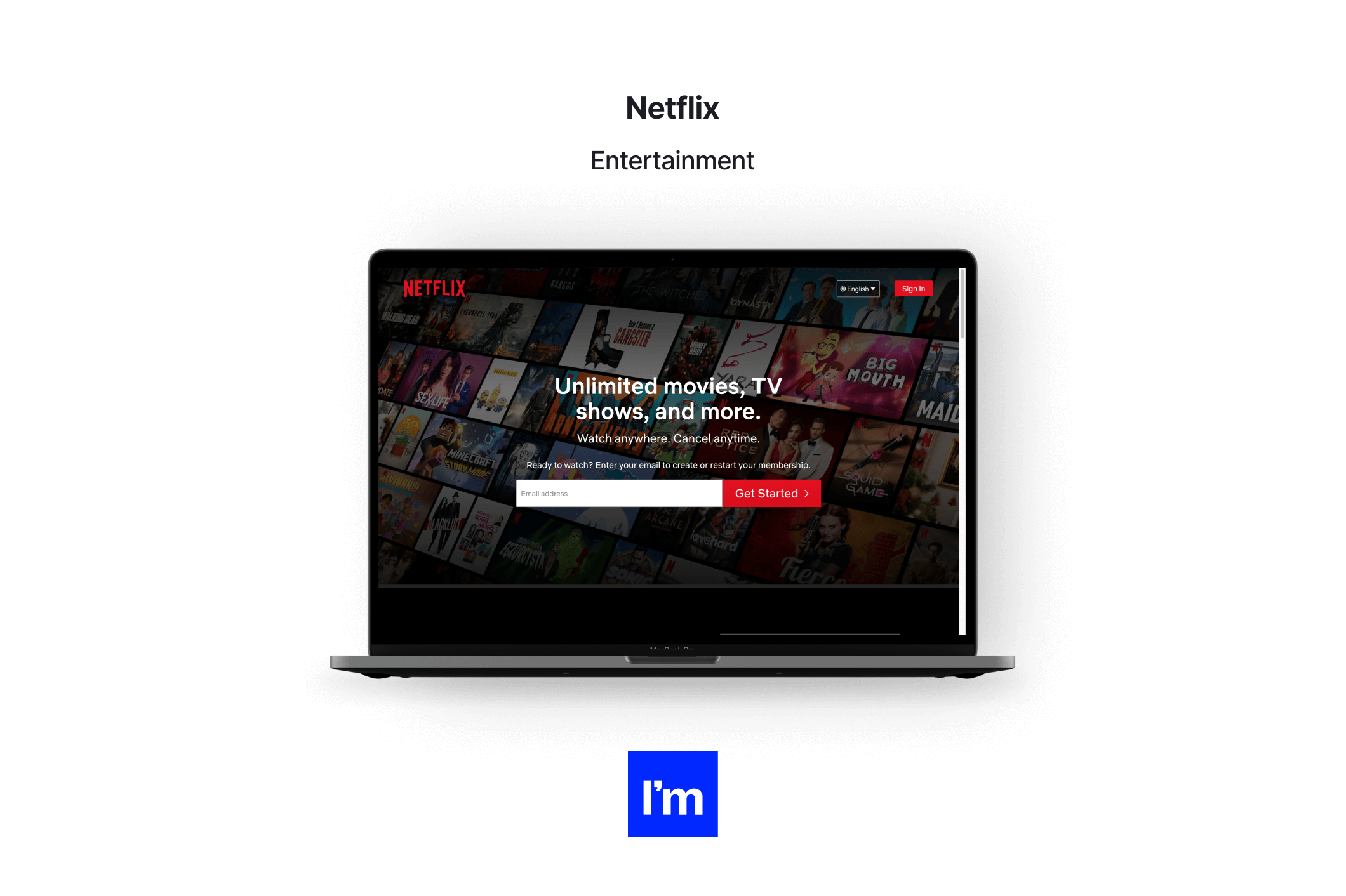
Two hundred nine million users use Netflix’s flexible on-demand TV service every day, corresponding to more than 2 billion content requests per day, powered by a Java-based engine.
A vast proportion of services running within the Netflix architecture are built on the JVM. Additionally, the company uses various Java-based open-source tools for monitoring, upgrading, and scaling its infrastructure services. Java also underlies Netflix’s help center and customer self-service apps.
Netflix trusts in Java based on its scalability, essential to roll out its services to new client accounts instantly. Despite being a mature technology, Java ideally fits into the company's continuous delivery and integration pipeline, as it is flexible and allows making changes quickly.
Netflix's engineering department also appreciates Java’s portability, enabling developers to deliver code to all platforms quickly. Last but not least, finding developers skilled in Java is much easier than it would be for most other languages. And quick hiring is critical for an organization of 10,000 people that is constantly expanding.
“Java platform services make it possible for a developer to quickly come up to speed and write a service that works in our architecture. (...) There is still a tremendous amount of innovation within Java and in the Java ecosystem. It's solid. It's not going anywhere.”
Andy Glover, Director of Productivity Engineering at Netflix

Rakuten is an e-commerce and online retailing giant from Japan, serving nearly 120 million global users. Like other notable industry brands, such as eBay, Amazon, and Target, it takes huge advantage of Java to power its platforms. In particular, the company has been using Java Enterprise Edition for its backend and service logic implementations in the full range of Rakuten’s activities, including financial services.
One of the company’s Chief Engineers reveals that working with Java can be extremely convenient from a developer’s perspective.
“Java EE has a very detailed API documentation, and a quick read through this documentation is sufficient enough to build your first web app in an hour,” he says.
“A programmer needs to concentrate only on business logic, boilerplate code is covered by APIs, the configuration is done by annotations and mostly optional.”
Consequently, the code quality improves, resulting in fewer bugs and on-time project delivery.
08 Java today and tomorrow
“Is Java dead?”, “Is Java still relevant?”, “Is Java going away?” Questions like these have been reappearing on Reddits and Quoras of the Internet for a few years now. For the most part, that’s because Java’s position as the top programming language of the world has been threatened in recent years by more modern and lightweight languages like Python or Go.
In some cases, like game development or iOS mobile apps, Java gave way to its younger cousins. Nevertheless, it still beats many of them on other fronts, as demonstrated in Java vs other programming languages.
Despite so many contenders, it looks like Java has weathered this storm and is still hugely relevant today, especially in corporate Java applications, web apps development, and microservices, and cloud-based software development. Besides, it is constantly being improved to match the emerging business use cases. So if you ask us about Java’s impending demise, our answer would be: “No, Java’s not going anywhere, and it still thrives.”
To prove it, let’s review the state of Java today and have a sneak peek into Java’s future.
Current trends in Java technology
Looking at some industry surveys and indexes already quoted throughout this guide, we see that Java comfortably sits in the top tier of popularity ranks. It does show a declining trend, but it’s quite slow.
Java usage statistics
For example, the TIOBE Programming Community index for August 2021 lists Java as the world’s third most popular programming language. Last year, it was on the second spot, but it got outdistanced by Python. Similarly, StackOverflow’s Developers’ Survey of 2021 suggests that 35.5% of programmers use Java, dropping nearly 5% since last year.
However, as far as business demand is concerned, Java still dominates over Python and other programming languages; it’s the second most in-demand language, sought by 59% of organizations. Also, the PYPL index names Java the second most popular programming language of all, indicating that it has recorded a growth in popularity since last year.
A glance at global Google Trends reveals more interesting insights. Examining the trends related in general to ‘Java,’ ‘Python,’ ‘Go,’ and ‘Rust’ programming languages, we will observe a profound interest in Python, which dominates over Java. The other two languages are far behind them.
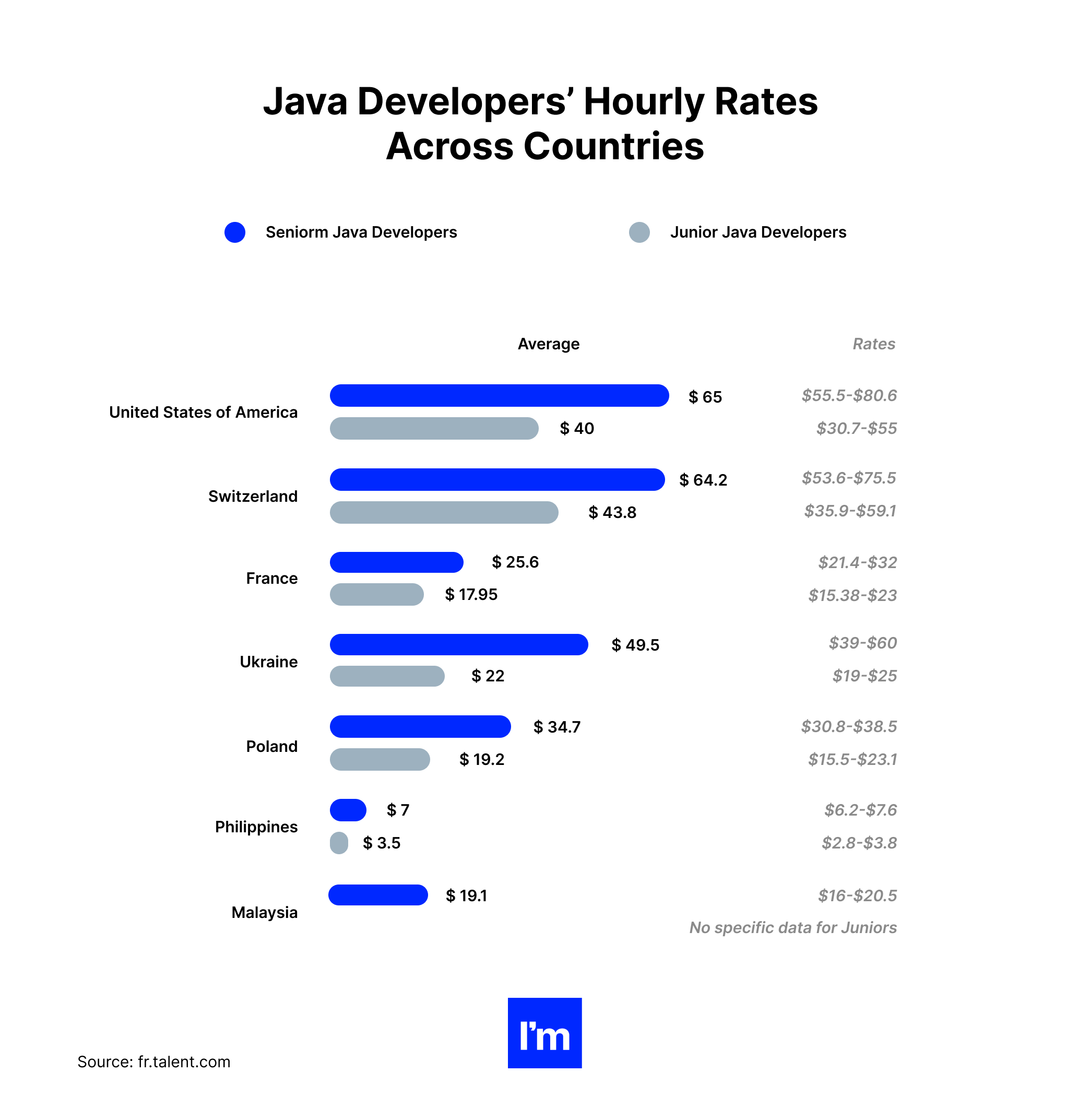
But a more specific search for ‘Java developers,’ ‘Python developers,’ etc., paints an entirely different picture - the demand for Java developers has far exceeded the one for other technologies.
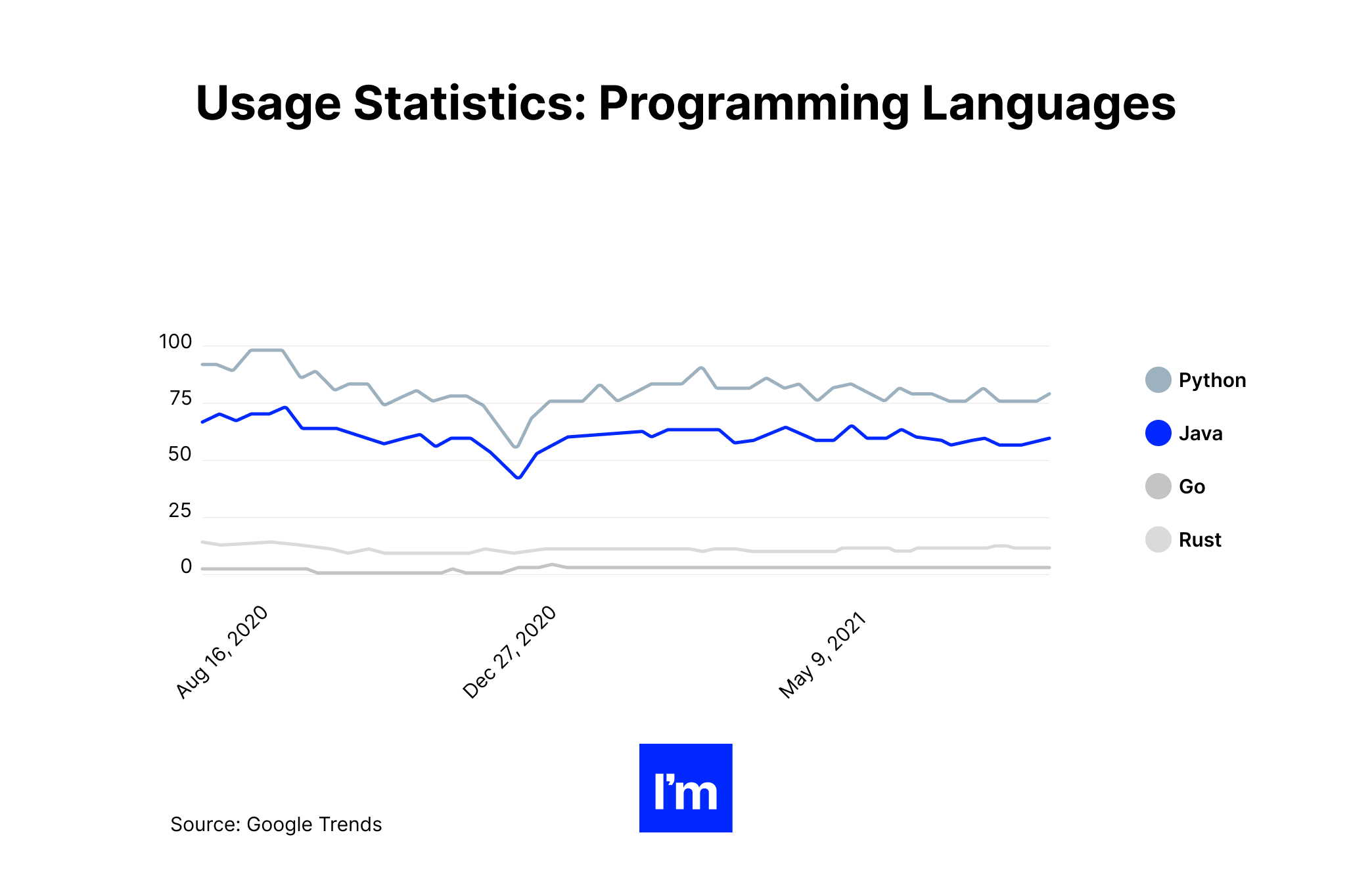
As we can see, research results are inconclusive, but Java invariably takes the podium regardless of the data source.
Java latest technology trends
Over the past few years, Java has gone through several updates and enhancements to make it more consistent with modern business requirements. Some of the key changes throughout the last few release cycles have included:
- A change in release cadence. From Java 9 onwards, Oracle has shortened the release cycle from about three years to only six months, allowing Java to keep up with new technology trends and deliver smaller features fast, in line with the agile methodology.
- The ‘Preview’ mode for feature release. Java owners have adopted a more flexible and user-driven approach to software development with a preview feature. It allows new features to be beta-tested by the Java community before they are rolled out in the official release.
- Default strong encapsulation. Users of JDK 9 and up can now use strong encapsulation for crucial internal APIs. The change was made to encourage Java software developers to adopt standard APIs for greater stability, easier maintenance, and enhanced security.
Top Java events and influencers to follow
As software development is highly collaborative, social media has become a hub for grassroots software development communities. LinkedIn, Facebook, and especially Twitter and Reddit provide platforms for Java professionals and enthusiasts to connect, collaborate, and share insights on Java software development.
Over the years, some Java experts have built a significant following - their accounts are go-to places for the latest Java news and updates, events coverage, and groundbreaking innovation. Here are a few leading Java experts to watch on social media.

By day, Markus is a Developer Adoption Program Lead in EMEA at Red Hat. Off duty, he’s also a Java Champion, former Java EE Expert Group member, founder of JavaLand, and a reputed speaker at Java conferences (see below), with over 14 years of solid experience as a Java EE developer and expert. You can follow him for updates on Java development and microservices architecture.

The Deputy CTO of Azul Systems, Simon has been with Sun Microsystems, then Oracle, for nearly 20 years, leading the Java technology evangelism team and driving adoption of the language across different sectors. In his own words, Simon is spreading the word on Java and JVM, far and wide.

Trisha is a Lead Developer Advocate at JetBrains with expertise in Java high-performance systems and software applications for a range of industries. She’s focused on making Java programmers’ lives easier through her blog posts, books, speeches, and a monthly newsletter at JetBrains. Trisha shares time-saving tips and tricks for developers and insights on improving one’s Java skills.

Adam has been working as a freelance Java consultant since JDK 1.0, and over the years, he has evolved into one of the leading Java experts. A Java Champion, NetBeans Dream Team Founding Member, Oracle ACE Director, triple JavaOne Rock Star, he is a regular speaker at Java conferences. He also has a blog, podcast, and YouTube channel - all related to Java programming.

Mark is the Chief Architect of the Java Platform Group at Oracle. He has contributed to the development of the Java SE Platform for over 20 years, serving as lead engineer for several JDK releases. Mark’s Twitter account is a reliable source of knowledge about the upcoming Java releases and updates.

Josh is an application developer, technical writer, and DB administrator who primarily works with Java and other JVM technologies. He is a prolific writer sharing his insights and expertise on Java software development and a frequent contributor to Oracle blog and Java Magazine. Follow him on Java-related technical content, news, and events coverage.

Apart from being a Java Champion, international keynote speaker, and IBM Master Inventor, Angie volunteers with Black Girls Code and runs her blog, sharing loads of programming and automation articles, videos, and other content. Angie also leads an online training platform, Test Automation University.

Previously with Oracle for nearly six years as Principal Product Manager, Bruno now works in Microsoft’s Developer Division Java Engineering Group. He’s responsible for building Java workloads for Azure cloud while also leading Java at Microsoft public communications. So if you want any updates on Java EE, cloud computing, and JavaFX, his account is the place to go.

Another Java Champion on our list, Mala works as a Developer Advocate for JetBrains. She is also an author of several OCA Java Certification Guides and other Java programming-related books, a keynote speaker, and the founder of a website that offers courses for Oracle Java certifications. Check out her tweets for Java event updates, technical insights, and educational resources.
Java events worth attending
As the world is slowly opening, you may want to meet some of the above Java keynote speakers and enthusiasts in person. And there’s no better occasion to do that than by attending one of the Java industry events.
There are dozens of them happening throughout the year. But let’s see which ones are particularly worth checking:
- SpringOne - SpringOne conference is the premier event for all software developers building cloud-native software. While Java isn’t explicitly the main theme, Java enthusiasts will find many sessions and workshops concerned with Java-based cloud-native implementations.
- Devoxx France - Devoxx is a series of developers’ community events originally organized by the Belgian JavaUser Group. By now, it has grown into an international event, with Devoxx editions taking place in Poland, Morocco, Ukraine, the USA, and other countries.
- JAX London - Based in London, this event brings together Java software development specialists and enterprise-level professionals innovating in the fields of Java, microservices architectures, continuous delivery, and DevOps.
- JCON - An international Java Community conference organized by JAVAPRO, the first free magazine for professional Java developers, architects, and other experts.
- ÜberConf - No Fluff Just Stuff’s flagship educational event for software engineers, tech leads, and other software development professionals. It explores topics such as modern Java, Kotlin, microservices, AI & ML, Android mobile development, DevOps, and many more.
- DevTernity - One of the biggest software development conferences in Europe emphasizing topics around software architecture, development, technical leadership, and programming best practices. It is not limited to Java technologies but obviously, many of the sessions concern the language.
- Devnexus - The longest-running and largest US conference for Java professionals. It runs over three days with thousands of attendees. The focus is Java programming with special consideration for microservices and cloud-based development.
Java events: other worthy mentions
The 2021/2022 dates of the above conferences are confirmed. But there’s a bunch of other notable Java events that are likely to reopen next year. So keep an eye on their updates:
- JSpring Digital - Java Spring Conference for users of the Spring ecosystem.
- Oracle Code One - One of the largest programming conferences in the world comprising various technologies, Java included.
- JBCN Conf - A Java and JVM conference gathering together Java enthusiasts discussing Java frameworks, best practices, and key issues with Java implementations.
- Java Zone - An community-driven conference focusing on hands-on Java experiences, learning sessions, and lightning talks.
The future of Java development
All in all, the rumors about Java's demise seem largely exaggerated. But who knows what the future holds for Java developers and projects?
We’re not fortunetellers, so we have no insight into the master plans of huge software corporations. They might be cooking up a new, groundbreaking programming language that will end Java and other technologies this very minute.
But for all we know, Oracle has stepped up its efforts in innovating Java in the last few years (which shows, e.g., in the higher rate of Java releases or the Project Valhalla that explores and incubates advanced JVM features). So, it’s unlikely that the corporation would like to throw away this investment.
Besides, Oracle will provide extended support for the 17th Java LTS release until 2029. Right now, Java is already powering cloud-native and microservices deployments. It is also constantly updated to harness the upcoming technological advancements. All of this indicates a bright future for the Java programming language.
09 Closing
Whew, that’s been a lot! Kudos for making it to the end!
This guide has so much detail because Java is such a mature, diverse, and robust programming language. We hope that by now, you can see and appreciate it.
Now that you know everything about the business application of Java, are you ready to take it to the next level and kick off your software project?
If you still need to fill in some critical tech roles before that happens, we’ve got you covered. With hundreds of professional Java development experts, we will help you build a stellar Java software development team in no time. Just get in touch with us!
Hire seasoned Java developers
Startups, scale-ups, and enterprises all build their teams with vetted Java specialists from Ideamotive. These are experts we have screened, tested, and worked with across dozens of Java projects for our clients.
Using our vast network of top-tier IT talent, we will connect you with the right people for your Java software development project: software engineers, consultants, IT project managers, web & mobile designers, and other experts matched with your industry, technology, and company culture.
Sounds good?
Rated 4.8 / 5.0 by clients from various industries and locations.
